- Skip to primary navigation
- Skip to main content
- Skip to primary sidebar
- Skip to footer
Journey With Confidence

Everything You Need To Know About Towing A Travel Trailer

Photo courtesy Ford
Hitch Up the Easy Way With Our Travel Trailer Towing Guide
Some 56 million Americans are expected to hit the highways, byways, and backroads this summer with a recreational vehicle, according to the latest RV Industry Association (RVIA) surveys. Another 10 million RVers will join them in 2022. About 1-in-5 of those hitting the road will be hitching up and towing a travel trailer—everything from teardrops to tent trailers and travel trailers to toy haulers as individuals, families, and friends head out to enjoy all the freedom and adventure our great country offers.
For more than 110 years, automobile owners have been towing recreational vehicles so they can explore America. Towing a travel trailer is part of adventure-seekers’ DNA, and we’ve been doing it as long as automobiles have been around.
The urge to explore at one’s own pace with a travel trailer in tow was hugely popular in the 1950s and ‘60s . Today, that popularity in RVing is once again thriving as Americans look for ways to travel the nation comfortably and safely.
The safest way to travel
“More and more Americans are ready to travel this summer, and 56 million of them are planning to go RVing in an RV they rent, own, or borrow,” said Craig Kirby, President and CEO of RVIA . “Even with other forms of travel returning, the desire to use an RV to get outdoors and experience an active outdoor lifestyle is stronger than ever. RVing has been cemented as a mainstream travel option that is here to stay.”
The appeal of exploring the country while towing a travel trailer appeals to all age groups and interests, too. The popularity of RVing has even attracted media attention from the Wall Street Journal , which ran “ The Safest Way To Travel This Summer ” in a May 2020 issue.
This surge in the popularity of RVing comes to light when you try to book reservations for an RV campground space at county, state, and national parks . You can also see it on the road; the number of cars, pickups, vans, SUVs , and crossovers towing travel trailers has never been greater.
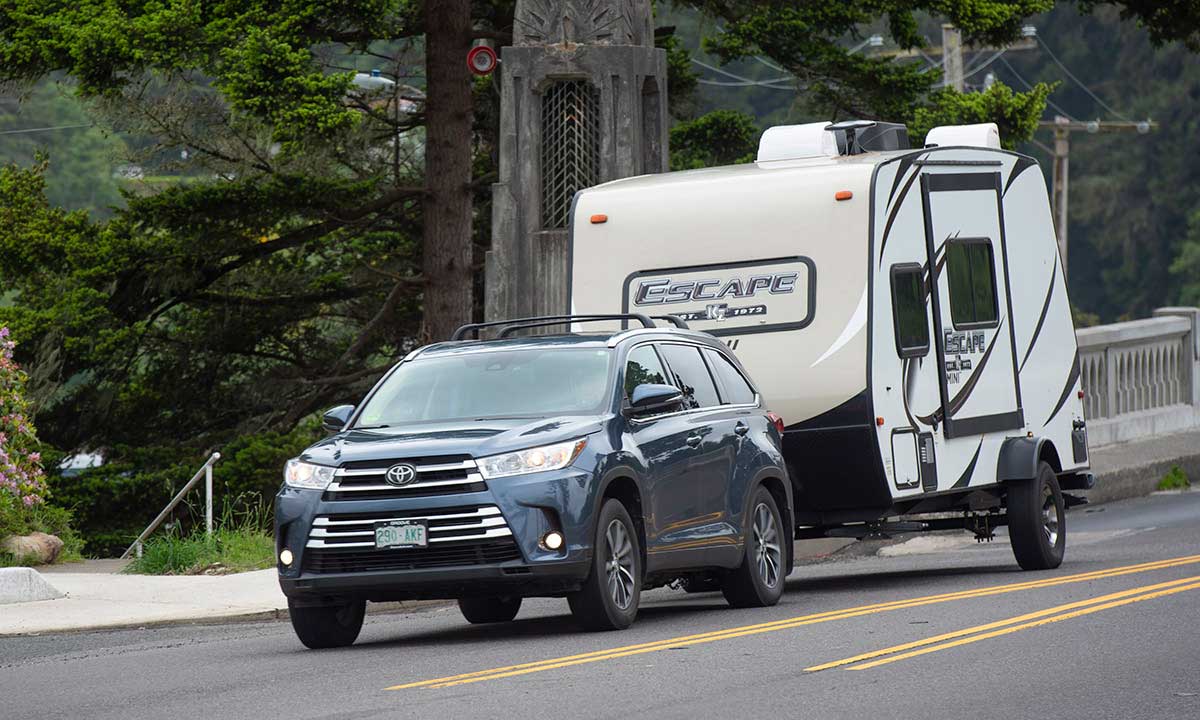
Americans hitting the road to vacation with an RV trailer in tow is at an all-time high. Make sure your travel trailer is the proper Gross Vehicle Weight Rating (GVWR) and doesn’t exceed the maximum tow rating of the vehicle towing it.
Safety concerns towing a travel trailer
From Gen Z to Boomers, RVing via a travel trailer of any type offers freedom and a sense of self-sufficiency. It’s both a practical and comfortable form of lodging. You can disconnect your tow vehicle and have a base camp to explore the area around you.
But towing a travel trailer can bring some unexpected drama and safety concerns for millions of first-time RVers. Trailers add weight to the back of the tow vehicle, and that added weight changes the handling dynamics and braking of the tow vehicle. That’s why you need to make sure your trailer and tow vehicle are properly matched.
This guide explains the basics of towing a travel trailer so your RVing experience is easier, safer, and more enjoyable.
The basics of towing a travel trailer
Towing a travel trailer consists of three components: the vehicle, the hitch, and the RV.
Within those components are variations based on the vehicle’s towing capacity, the weight of the RV , the hitch setup, and towing-related accessories to tie everything together safely.
In this towing guide, we are specifically talking about “tow-behind” or “bumper-pull” RV trailers that attach to the hitch ball on a hitch mounted under the bumper of a pickup, SUV, crossover SUV, or car, not a 5th wheel or gooseneck hitch that mounts in the bed of a pickup truck.
You can easily avoid drama and stress by properly matching the tow vehicle, hitch, and travel trailer. But get one of those wrong, and you have a recipe for disaster.
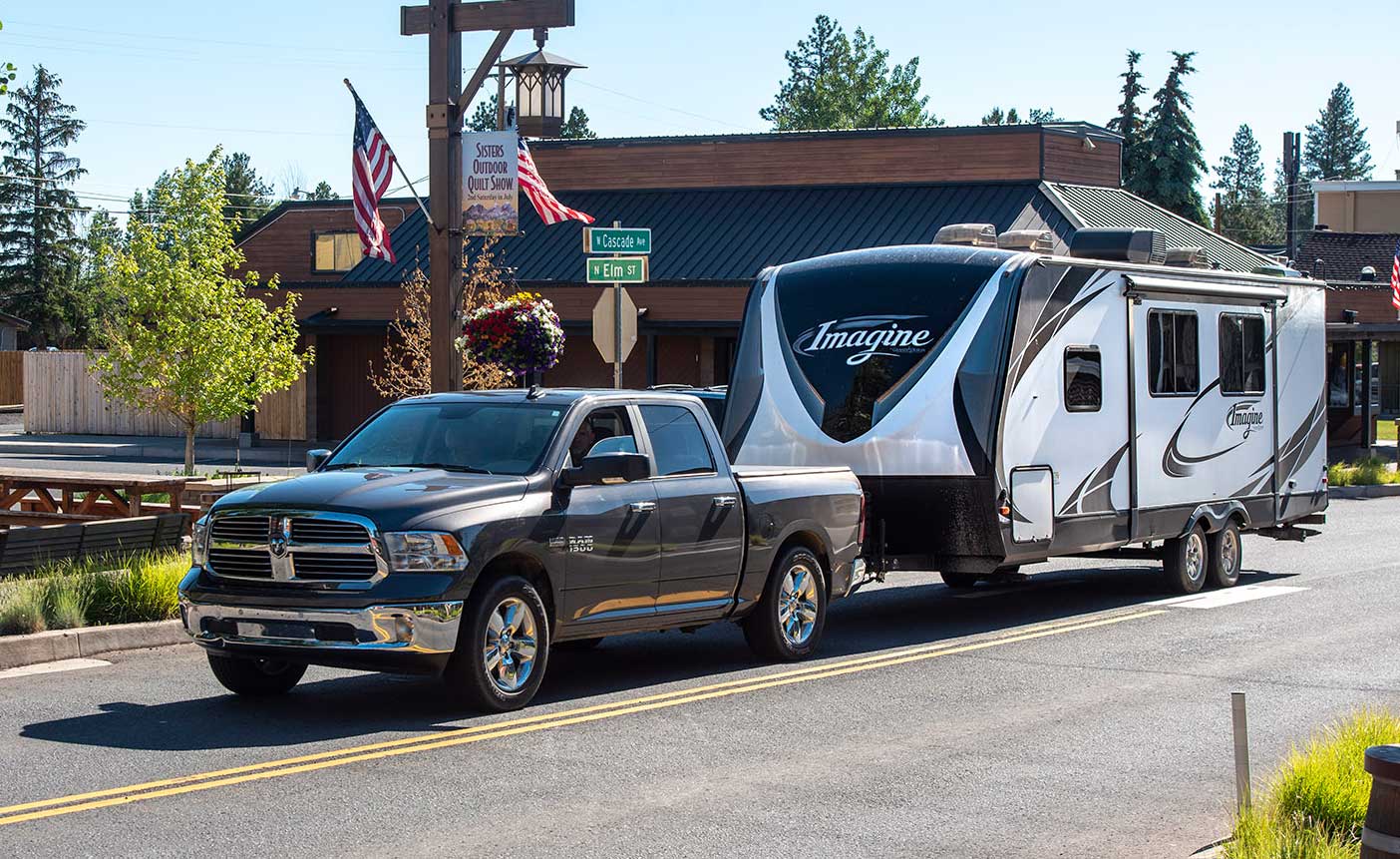
The best vehicle for towing any trailer is the one that fits both your personal needs and requirements while the trailer falls within the limitations set by the vehicle’s manufacturer.
What is the best vehicle for towing a travel trailer?
So, let’s begin with the tow vehicle. One question I get a lot from first-time RVers is, “What’s the best vehicle for towing a travel trailer?” The answer is, “It all depends.”
It all depends on what type of trailer you want to tow, whether you intend to tow with a vehicle you currently own, or maybe you have neither a tow vehicle nor a travel trailer and want to get both.
The most important aspect of towing a travel trailer is making sure the vehicle is up to the task of towing the trailer you plan on attaching to the hitch ball.
Here’s the deal when it comes to tow vehicles: The vehicle manufacturer determines how big (heavy) a trailer the vehicle can safely tow—not you. From a legal standpoint, that’s it, but I’ll explain more later in this RV trailer towing guide.
RV trailer numbers you need to know
There are two important weight-related factors when it comes to RV trailers: GVWR (Gross Vehicle Weight Rating) and tongue weight (TW).
GVWR is the safe maximum weight of the trailer when it’s loaded for camping with water, fuel, supplies, and cargo. The TW is how much downforce the loaded trailer places on the hitch.
Both numbers are displayed on the metal Federal Certification / VIN ID tag located on the front left side of a travel trailer. You can also find the specifications listed on the trailer manufacturer’s website.
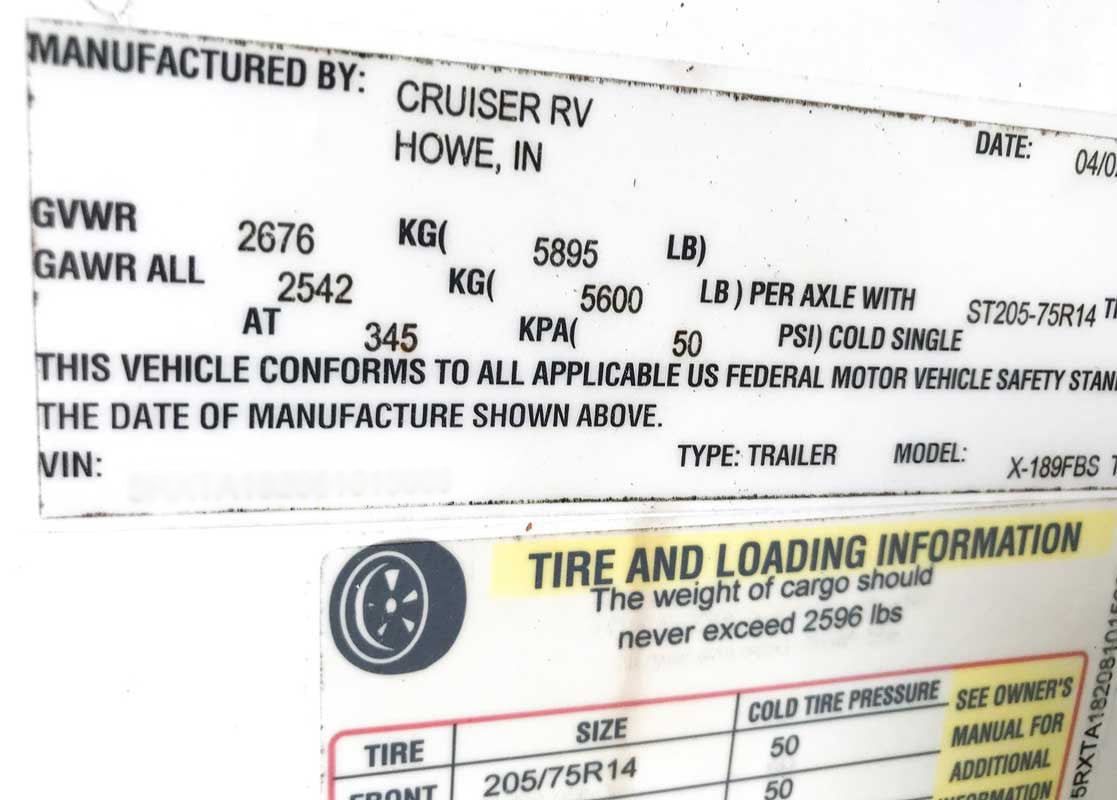
Every RV trailer has an ID/VIN decal or metal tag somewhere on the left front. It shows the trailer’s GVWR, which is the maximum it can weigh fully loaded. This is a critical number to know when matching a tow vehicle to a trailer. The trailer’s GVWR should never exceed the tow vehicle’s maximum tow rating.
Concentrate on those two weights, not the RV’s bells and whistles or nice furnishings. Those two numbers set the basis for choosing the vehicle best suited for towing a travel trailer.
Tongue weight of RV trailers, sometimes referred to as “hitch weight,” will be typically between 10- and 15-percent of the trailer’s GVWR.
For example, a 32-foot trailer like the Forest River Aurora 28BHS , weighing 7,600 pounds GVWR, has a TW of 730 pounds, while the 32-foot Grand Design Imagine 2800BH has a GVWR of 7,995 pounds and a hitch weight of only 604 pounds.
So, do your research. RV trailer weights can vary widely by brand, type, and size. That’s why it’s important to narrow down these numbers to the specific trailer you plan to tow and then make sure those weights match your vehicle’s towing limitations.
Payload calculator
A website called Keep Your Daydream Today does a great job of explaining all the weight-related towing nuances, and the site has a nice payload calculator that can be downloaded to figure out what you can safely tow per the vehicle manufacturer’s listed tow ratings.
How big of an RV trailer can my vehicle tow?
Now that you know the trailer’s GVWR and TW, it’s time to focus on the tow vehicle. Towing a travel trailer from your home to a campground begins with dropping the trailer tongue on a hitch ball. But the most critical aspect of safely getting from Point A to Point B is having the right vehicle for towing.
Your tow vehicle needs to have the power to pull the trailer up hills and maintain reasonable speeds over the open road. More importantly, the tow vehicle has to be properly equipped for towing, per the vehicle manufacturer’s guidelines, and have the factory tow rating capacity to handle the load it’s towing.
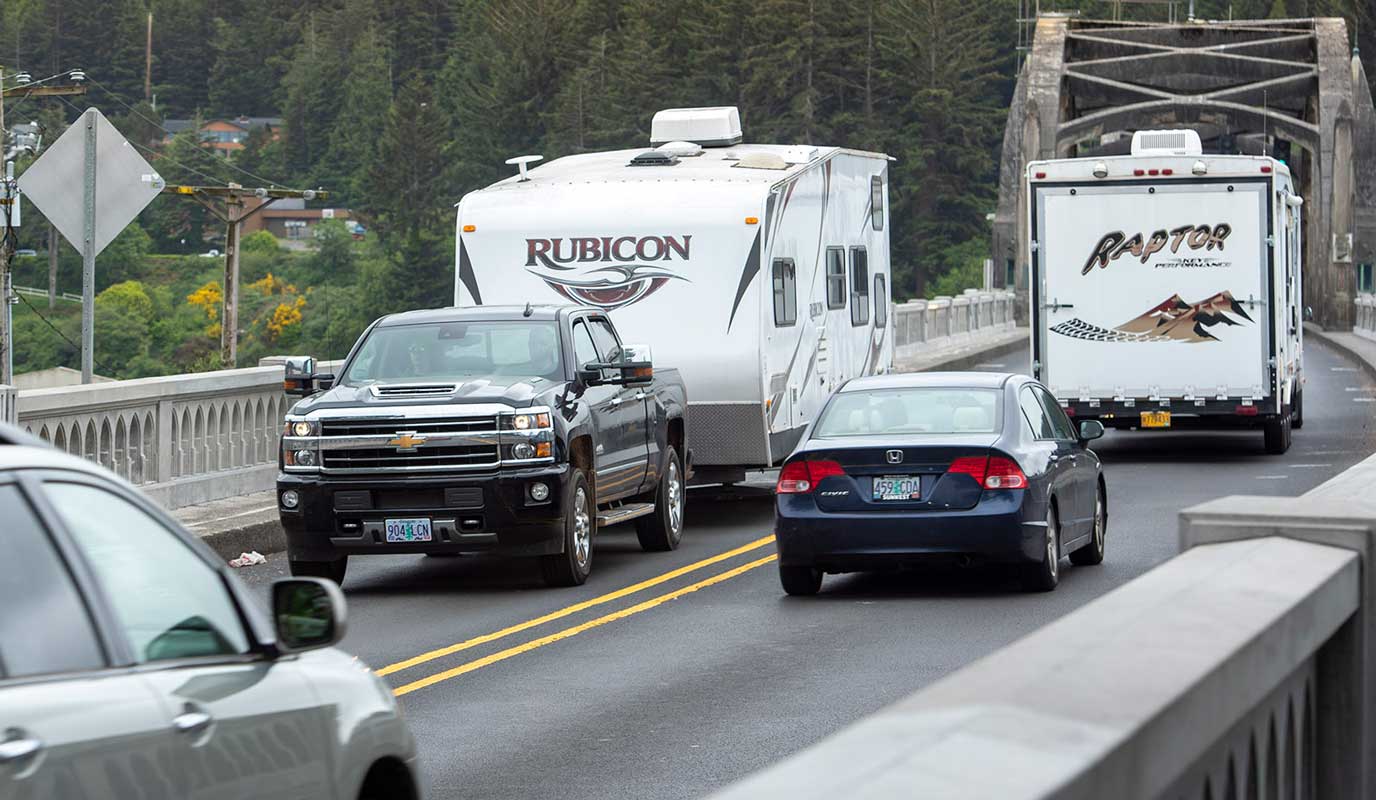
Having the right tow vehicle for the trailer takes all the drama out of the RVing experience and maximizes the safety factor for others on the road.
The only one who can set the limit on how much weight any vehicle can tow is the vehicle manufacturer.
To find your tow vehicle’s maximum trailer towing capacity, and what it needs to be properly equipped per the vehicle manufacturer’s specifications, dive into the towing/trailering section of the owner’s manual. There you’ll find the bare-bones information.
RV tow rating information
But what you really want is the detailed tow rating information. For that, you’ll have to dig deeper. The information is usually on the vehicle manufacturer’s fleet/commercial website under a heading like “RV & Trailer Towing Guide.”
When matching a trailer to a tow vehicle, a good rule-of-thumb is to keep the trailer’s GVWR at less than 75 percent of the tow vehicle’s trailer towing capacity.
So, if the tow vehicle is rated for a maximum of 6,000 pounds, the chosen trailer should have a GVWR of 4,500 pounds or less. Likewise, if the tow vehicle is rated to tow 10,000 pounds, a good trailer weight is 7,500 pounds or less.
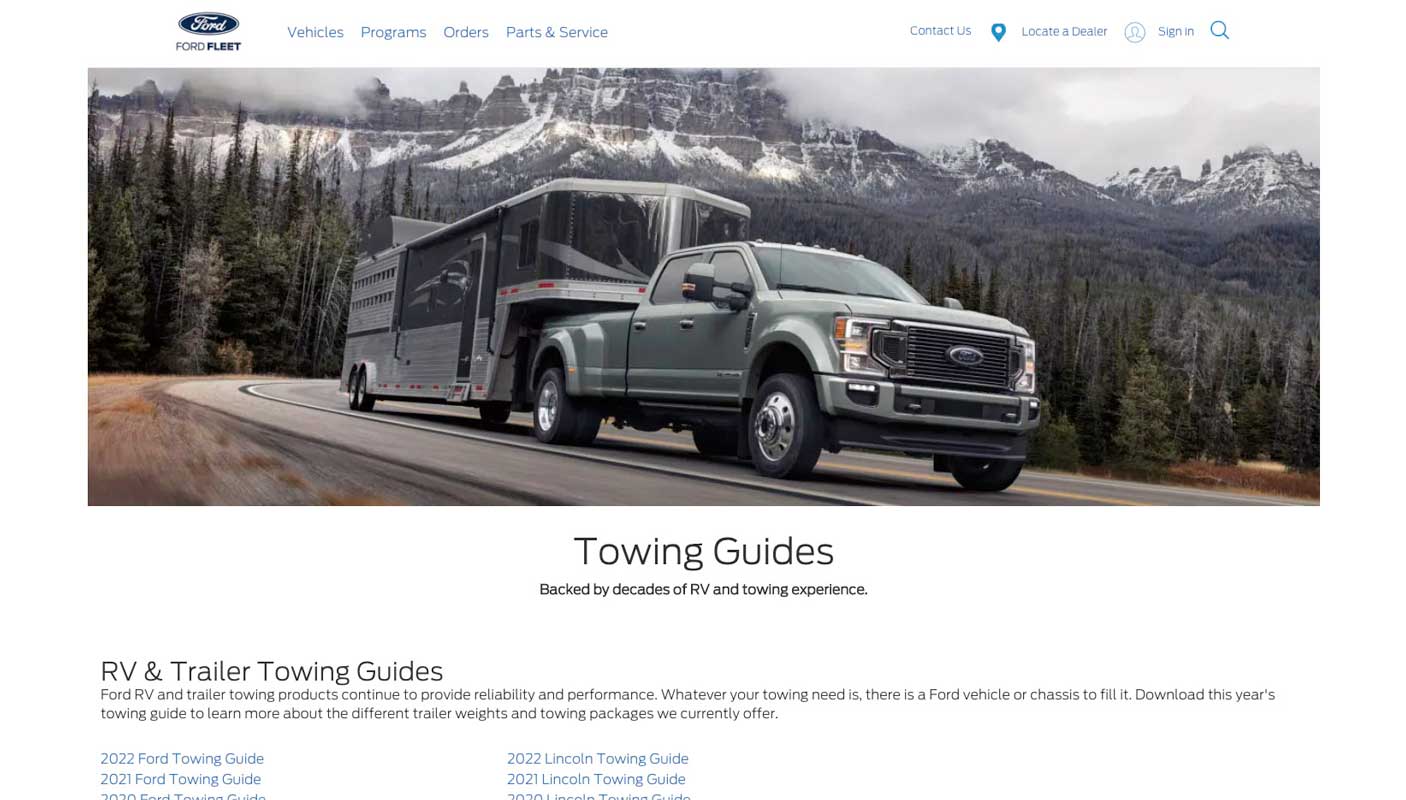
You can find detailed trailer towing information on the vehicle manufacturer’s fleet/commercial website under a heading like “RV and Trailer Towing Guide,” “Towing Guides,” or “Trailering Guide.”
Where to find pickup truck manufacturer trailer towing ratings
To make tracking down trailer tow ratings of the Big Three pickup manufacturers easy, here are those website links:
- Chevrolet: www.gmfleet.com/Guides
- Ford: www.fleet.ford.com/towing-guides
- GMC: www.gmfleet.com/GMC Trailering Guide
- Ram Truck: www.fcausfleet.com/ramtrucks/towing-guide
It’s easy to find the trailer towing limits for cars, SUVs, and crossover SUVs. Pickups are a whole different story.
Pickup truck ratings for towing a travel trailer vary by year, make, model, cab configuration, transmission, and axle ratio. They can also vary related to the type of hitch setup, whether “conventional weight-carrying” (towing-on-the-ball) or using a weight-distributing hitch system. So read the numbers and annotated information carefully.
Vehicle’s trailer tow ratings can’t be changed
As you review trailer tow ratings, you’ll see that just because a vehicle has a hitch doesn’t mean it can tow whatever is attached to the hitch ball. Every vehicle that rolls off the assembly line has a towing limitation, just as it has a unique VIN.
Once a vehicle leaves the manufacturing assembly line, its tow ratings and cargo-carrying capacities are set in stone—just like the VIN. Those ratings could have higher/lower capacities, depending on the engine and transmission package, axle ratio, and other options available on that particular model vehicle. This is especially true of pickup trucks.
Even though installing aftermarket products like air bags and anti-sway bars can improve the ride and handling when towing a travel trailer, such modifications do not change that particular tow vehicle’s limitations as set by its manufacturer.
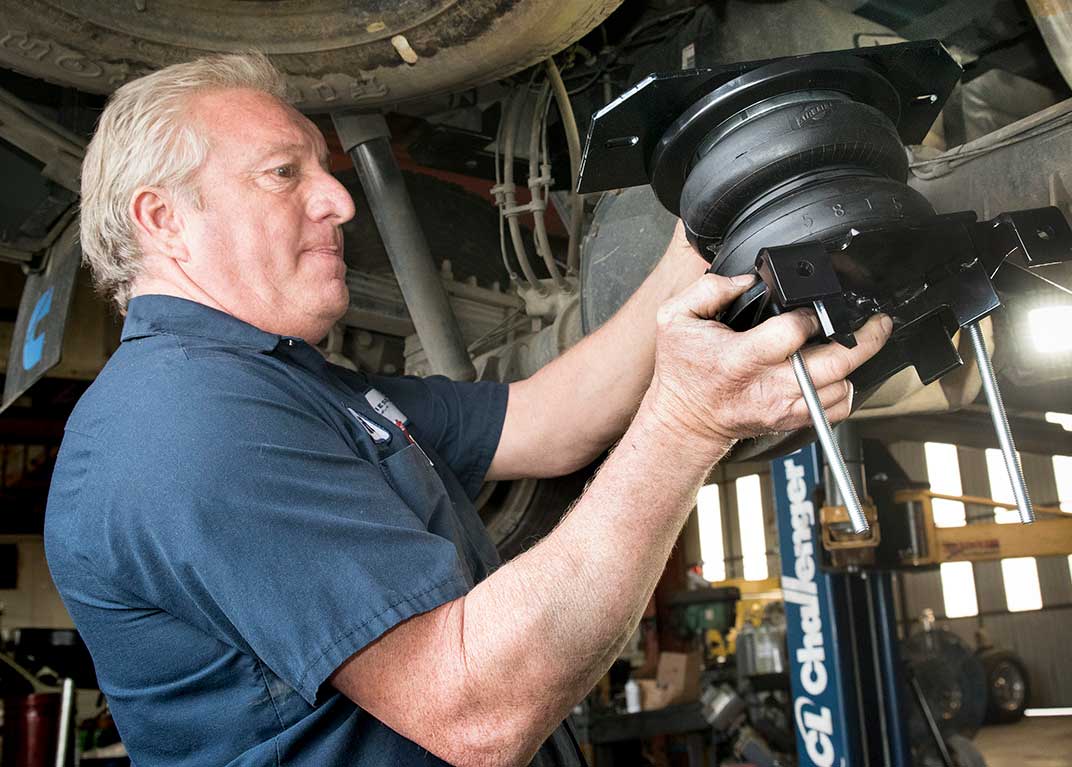
Installing overload springs, anti-sway bars, air helper springs, a heavier-duty hitch, or making other vehicle suspension, drivetrain, or engine modifications does NOT change the vehicle’s tow rating or load capacity. Those ratings are set by the vehicle manufacturer when the vehicle is built.
Why are vehicle manufacturer trailer towing ratings important?
Why is it important to know the trailer towing limits of your vehicle? Safety. Warranty. Liability.
Vehicle manufacturers set vehicle tow ratings and load capacities with safety, warranty, and liability at the forefront. They do so using special test procedures specified under SAE J2807 , which is a strict vehicle manufacturing safety standard focused on keeping the driver and occupants reasonably safe when towing trailers.
At the same time, SAE J2807 testing protocols allow the vehicle manufacturer to set a comfortable weight limit for the vehicle to function reliably through the warranty period when used for such towing and cargo-carrying tasks.
Among the battery of tests within SAE J2807 are emergency accident-avoidance and vehicle control tests with a loaded trailer in tow. If the vehicle being tested doesn’t pass these tests in a manner deemed safe by the vehicle engineering team, then the trailered weight is reduced and the vehicle re-tested until it meets the safety standards. When it meets the safe standard, that’s the maximum trailer towing capacity for that particular vehicle.
Towing a travel trailer that’s heavier than the vehicle is rated for towing, or not having the tow vehicle properly equipped, can put the burden of liability on you if you’re in an accident. Your insurance company could very well deny coverage because under the law, you, the driver, are considered negligent .
Trailer tow ratings can be confusing. But they are very important from a safety and vehicle handling standpoint.
Real-world lessons in trailer weight ratings
A neighbor recently joined the millions of Americans towing a travel trailer on his family’s first RV adventure. He hitched a beautiful Forest River 2021 rPod 190 travel trailer to the hitch of his 2017 Lexus RX 350 AWD. His first weekend on the road towing the trailer “scared him to death” because of trailer sway. He couldn’t understand why his Lexus handled so poorly when it was “rated” to tow 3,500 pounds—according to the trailer salesperson—and the trailer only weighed 2,900 pounds.
We looked at the numbers. He had two issues. First, the “dry weight” of the rPod was 2,900 pounds, but the GVWR was 3,800 pounds. Second, his Lexus was rated to tow 3,500 pounds only if equipped with “a sway control device with sufficient capacity” per the owner’s manual. Otherwise, the trailer towing capacity was limited to 2,000 pounds.
So, he installed a Blue Ox SwayPro 350 weight distribution hitch and made sure the trailer’s GVWR didn’t exceed 3,500 pounds.
He and his wife have spent anywhere from 3 to 5 days traveling around the Pacific Northwest at least twice a month, loving the RV life! For now, the Lexus and rPod are a happy match for their lifestyle.

Even though a salesperson says the vehicle you are buying is “perfectly capable” of towing such-and-such trailer, have the trailer’s GVWR number memorized, and then have the salesperson show you the maximum towing specs for the specific vehicle. In pickups, the difference in axle ratios alone can make a 2,000-pound or greater difference in a tow rating. In smaller vehicles, the same can be true for different engines.
Don’t rely on salespeople for accurate towing info
Another friend bought a 2021 Ram 1500 Laramie 4×4 Quad Cab and an equally nice 26-foot Backcountry Mountain TRX trailer so the family of four could enjoy the outdoor lifestyle during summer and fall. The salesperson at the Ram dealer said the Hemi-powered 4×4 could tow as much as 12,750 pounds, so no problem towing the 9,995-pound Outdoors RV camper.
But what he found out later when looking up the maximum trailer tow ratings in the Ram towing guide was that his particular pickup, with the standard 3.21 axle ratio, was limited to just 8,330 pounds. Fortunately, he persuaded the dealer to swap his new pickup for an identical one that was equipped with the “premium” 3.92 axle ratio, which was rated to tow 11,430 pounds—a much better match to the trailer and much safer for his family.
To that end, you must go back to the basics of weight when it comes to how much your vehicle can tow. You need to know the GVWR of the trailer and the maximum trailer capacity of your specific tow vehicle.
If the trailer’s GVWR is more than the trailer tow rating of your tow vehicle, find a lighter trailer or a tow vehicle with a higher trailer towing capacity.
A good rule-of-thumb in choosing a trailer is its GVWR be no more than two-thirds the max trailer tow rating of the vehicle. This gives you a margin of error on the safe side. Your tow vehicle must also be properly equipped as specified by its manufacturer.
What is the best 4X4 for off-grid RVing?
So what’s the best 4×4 vehicle for towing trailers when camping off the grid and exploring roads less traveled? Most people think the obvious answer is one of the many Jeep models, such as the iconic Wrangler Unlimited Rubicon or Grand Cherokee. They’re partially correct.
Jeep Models
Setting fuel economy and price aside, the Jeep Rubicon 392 is king, setting the highest bar among the Jeep line when it comes to overall backcountry and off-road performance. Its V8 power, technology, and agility are amazing.
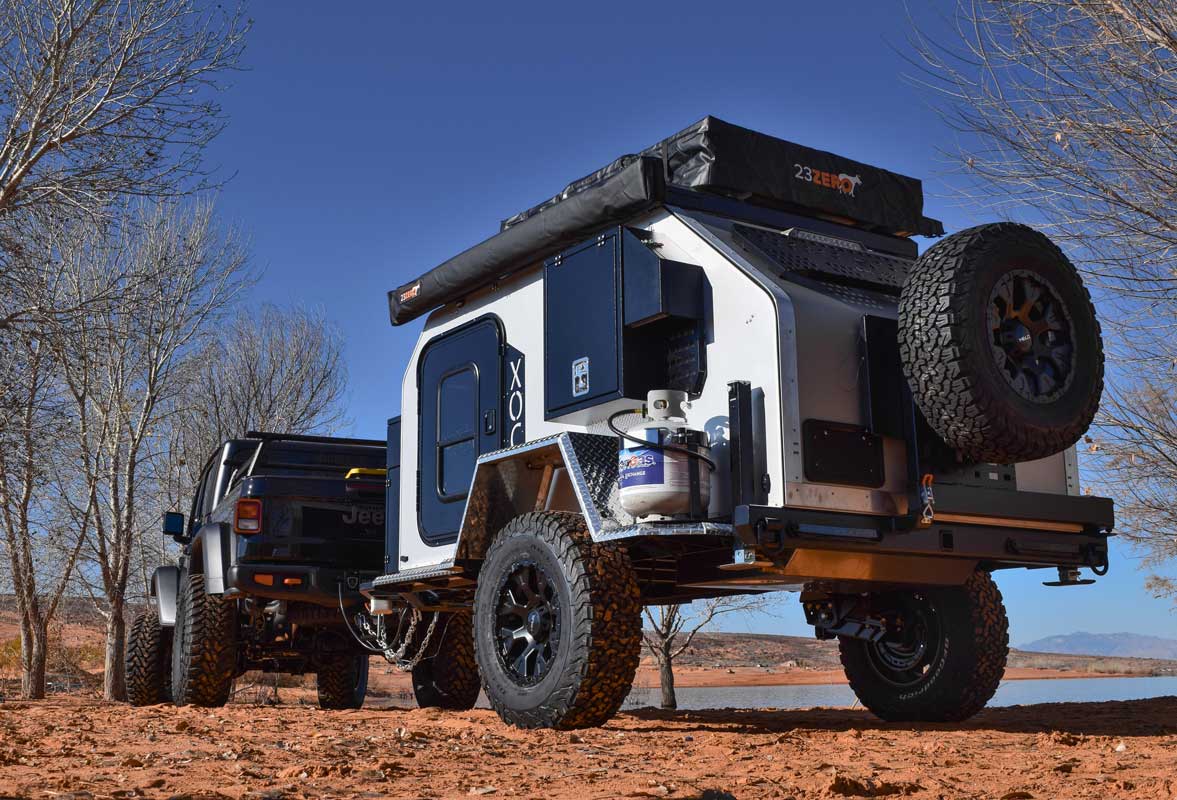
Jeeps are the icon for off-pavement/off-road travel. But the soft, pliant suspension takes away some of their towing ability, limiting most models to towing trailers less than 3,500 pounds. Off-road trailer manufacturers such as Vorsheer, which makes the 2,600-pound (GVWR) XOC, build their trailers to accommodate these tow ratings. Photo courtesy Vorsheer Mfg
But the Jeep Wrangler’s soft, pliant suspension, across all models, is also its downfall when it comes to tow ratings. They are among the lowest in this class of SUV, with a maximum towing capacity of just 3,500 pounds for the 6.4L V8-powered Rubicon 392 to as little as 2,000 pounds for the base model two-door Wrangler Sport with the 3.6L V6.

Jeep’s Grand Cherokee is an excellent tow vehicle for those who do a lot of highway RVing and backcountry travel with “light off-roading.” Some models can tow up to 7,650 pounds.
The Jeep Grand Cherokee has higher tow ratings ranging from 4,000 to 7,200 pounds (Hemi V8-powered SRT). But the Jeep Gladiator pickup is the best choice with a trailer towing capacity of up to 7,650 pounds, depending, of course, on the model and axle ratio.
Ford Bronco
A new contender when it comes to the best 4×4 for RVing off-grid is the latest iteration of the iconic Ford Bronco . Ford’s new SUV leads the pack for four-wheeling in overall performance, with excellent fuel economy, suspension travel, and traction capabilities.
Broncos equipped with the 2.7L EcoBoost V6 and 10-speed automatic combo are ideal for towing. The trade-off for the Ford Bronco’s off-road prowess is a limited trailering capacity of up to 3,500 pounds when equipped with the optional Class II Trailer Tow Package.
If money isn’t an option and you want the very best 4×4 for off-grid travel and towing RV trailers, the 702hp Ram 1500 TRX , with a tow rating of 8,100 pounds, wins. Hands-down. It’s won both Four Wheeler and MotorTrend magazine’s Truck of the Year and several other prestigious automotive pickup awards this year.
Hitch types and hitch capacities
The term “properly equipped” means the vehicle has the factory towing package, which can vary from vehicle to vehicle and from manufacturer to manufacturer. But it always includes a factory-installed receiver hitch and wiring to connect between the tow vehicle and the trailer.
Properly equipped also means using the proper hitch type for the weight of the trailer. There are two hitch types for towing a trailer using a receiver-type hitch: weight carrying and weight distributing.
Attaching the trailer to the hitch ball bolted on the shank that comes out of the hitch is called “weight carrying” because the full load of the trailer’s tongue weight is carried by the hitch assembly.
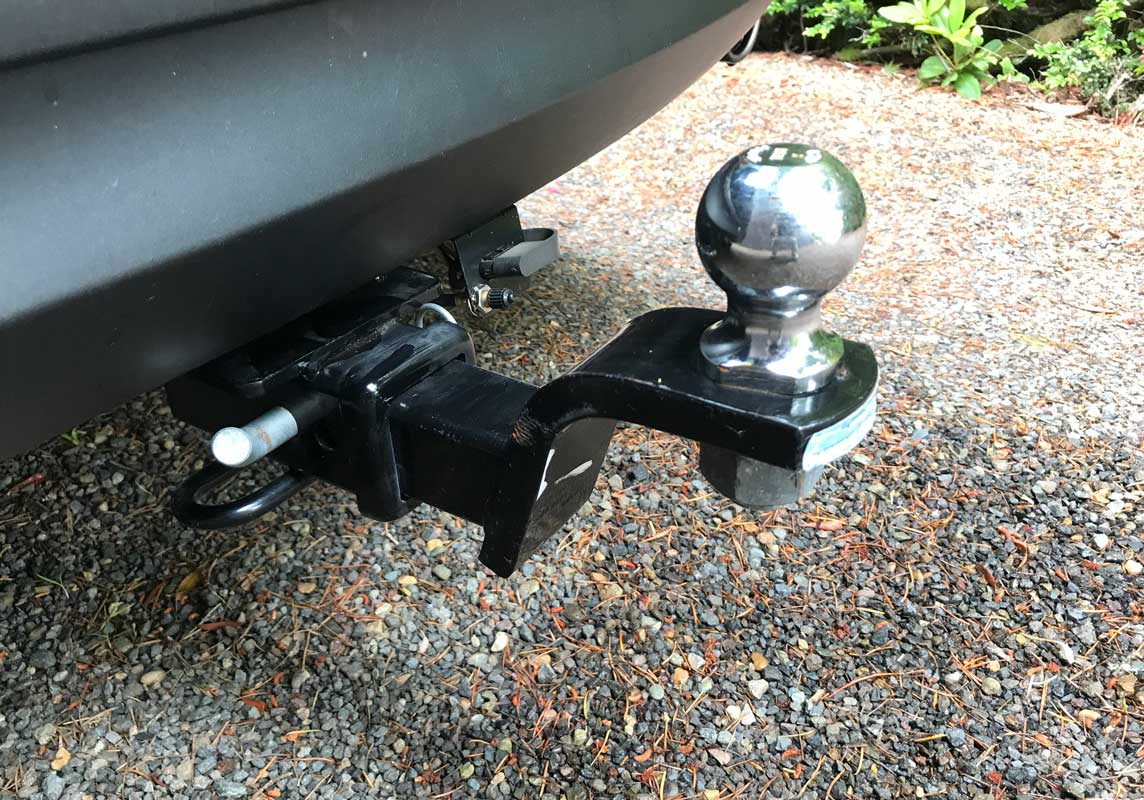
This is a typical “weight-carrying” hitch setup that comes from the factory. It accommodates a “shank” with a trailer ball mount. The load capacity of a hitch can be found on the hitch manual’s decal—the same with the shank. The hitch ball capacity is imprinted on the top of the ball.
The towing capacity of the hitch is determined by the hitch manufacturer, and the maximum load/towing capacities are listed on the hitch, the hitch shank, and on top of the hitch ball. Hitches come in five classifications depending on the size of the opening for the receiver (shank) and load capacity.
The typical factory hitch on cars, crossovers, smaller SUVs is Class I or II.
Midsize pickups, SUVs, and vans generally come with a Class III hitch.
Full-size pickups usually have a Class IV hitch, while some 1-ton diesels use a Class V hitch.
Hitch classes and Gross Trailer Weight
NOTE: Changing the size of the hitch to one with a higher capacity DOES NOT change your vehicle’s tow rating.
Understanding hitch balls and capacity
The most important connection point between the tow vehicle and the trailer is the shiny round thing sticking up from under the bumper—the hitch ball. You’ll have a big problem if the ball isn’t the correct size to fit the trailer coupler, or the ball isn’t installed on the shank (mount) with the correct amount of torque on the nut.
Standard RV trailer hitch balls come in three different diameters: 1-7/8″, 2”, and 2-5/16″, while shank sizes varying from ¾” to 3″ depending on the hitch capacity. The smaller 1-7/8″ hitch balls have a towing capacity of up to 3,500 pounds and are typically found on cars, smaller SUVs, minivans, and crossovers.
Hitches equipped with 2″ tow balls are rated for 8,000 pounds and are typical of that used on smaller travel trailers and overlanding/adventure-style off-road trailers. The larger 2-5/16″ hitch balls are rated from 12,500 pounds to 21,000 pounds and are common on RV trailers that weigh more than 8,000 pounds.
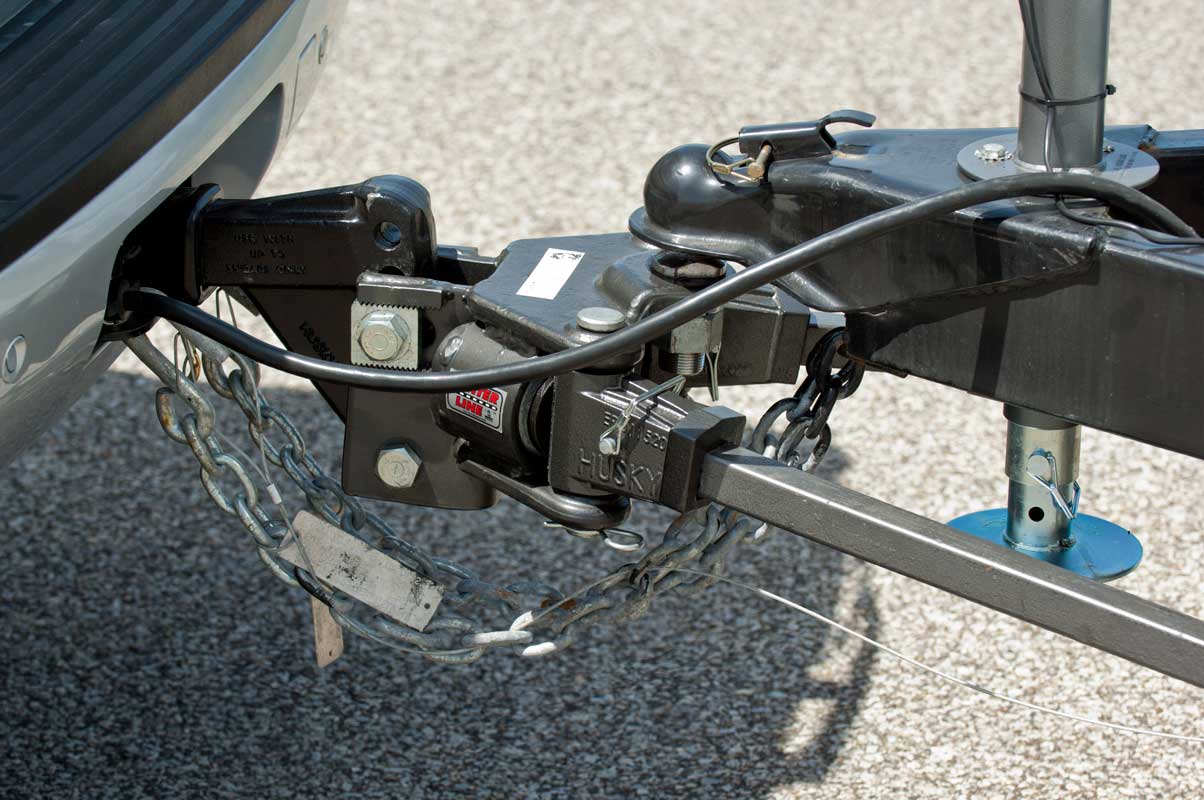
A typical weight-distribution (WD) hitch has two “spring bars” that extend from the hitch head to the trailer. The bars act like wheelbarrow handles, so some of the weight of the trailer on the hitch can be shifted fore and aft to better balance the tow vehicle/trailer combo. A WD hitch also greatly reduces trailer sway.
How do weight distribution hitches work?
A weight distributing hitch , or weight distribution hitch, uses a special head with provisions for attaching one or two long arms that attach to the trailer frame that can be adjusted to transfer some of that tongue weight fore and aft so the tow vehicle is better balanced.
The typical WD hitch also incorporates an anti-sway device or design for better trailer control.
“The weight distribution feature will transfer some of the weight to the front axle, as well as some being transferred back to the trailer’s axle(s)” explains Josh Jones, a customer service rep at Progress Manufacturing , makers of the Equl-i-zer Hitch and Fastway trailer towing components. “Basically, 1/3 of the tongue weight is transferred from your tow vehicle back to the trailer, and the remaining 2/3 is evenly distributed on the front and rear axles of your truck. This gives all four tires equal contact with the road, improving steering and braking, and the hitch’s built-in sway control eliminates sway before it starts so you have a smoother, more enjoyable towing experience.”
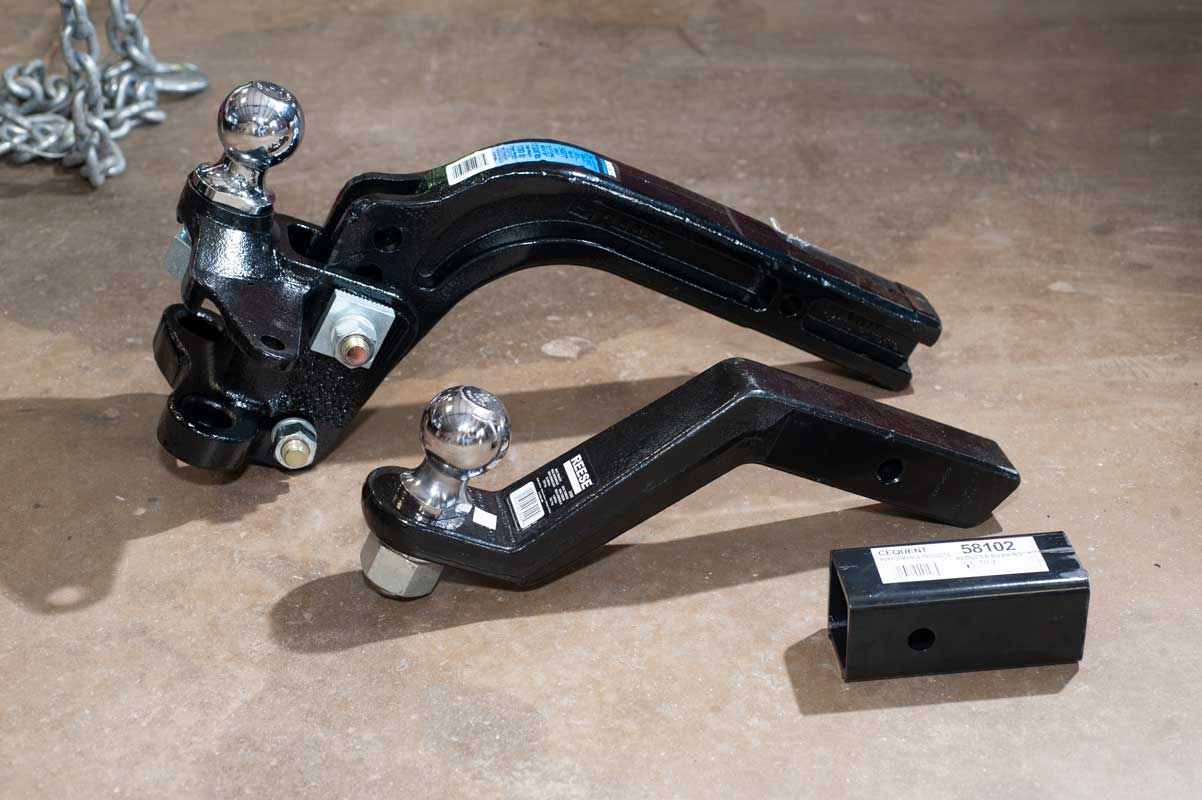
Both weight-distributing (top) and standard hitches have maximum trailer towing ratings. Using a reducer sleeve (bottom) to step down from 2.5” or 3” hitch receivers to 2” also reduces trailer towing capacity.
That’s why the “weigh-carrying” tow capacities of a vehicle, especially full-size pickups, vans, and SUVs, are usually considerably less than a “weight-distributing” setup because more weight is put on the rear axle when one is just towing on the ball.
These dual-capacity tow ratings really apply to pre-2018 and older heavy-duty pickups with some max trailer towing limits of 5,000 pounds towing-on-the ball unless a weight-distributing hitch is used. Also, using the 2″ adapter sleeve in newer pickups’ 2.5″ receiver hitches significantly reduces both the weight-carrying tow limit and maximum tongue weight.
The Best 2022 Pickups For Towing Trailers With GVWR Under 5,000 Pounds
Brake requirements for rv travel trailers.
Attaching a trailer to your tow vehicle places an additional load on its braking system. That means the heavier the trailer, the less responsive the brakes and the longer it takes to stop the vehicle. That’s why most state motor vehicle laws require trailers over a certain gross weight must have their own trailer braking system .
Some state trailer laws require a braking system on trailers with a GVW of 1,500, some 3,000 pounds, and some 6,000 pounds GVW. Other states require the tow vehicle/trailer combo must stop within a certain distance from a designated speed, or the tow vehicle be able to hold the trailer while stopped on a “hill of any grade under all conditions.”
Thankfully the RV trailer manufacturers make the braking aspect of towing a travel trailer easy by equipping their trailers, even the lighter off-road/overlanding camp trailers, with electric brakes on trailers that weigh more than 1,500 pounds. This way, the trailer can be sold in any state and meet the legal brake requirements.
As for trailer brakes, the typical RV trailer has electric-actuated brakes along with a “breakaway” system in the event the trailer decides to go for a little side trip on its own. (Breakaway systems are required on trailers with a GVW greater than 3,000 pounds.)
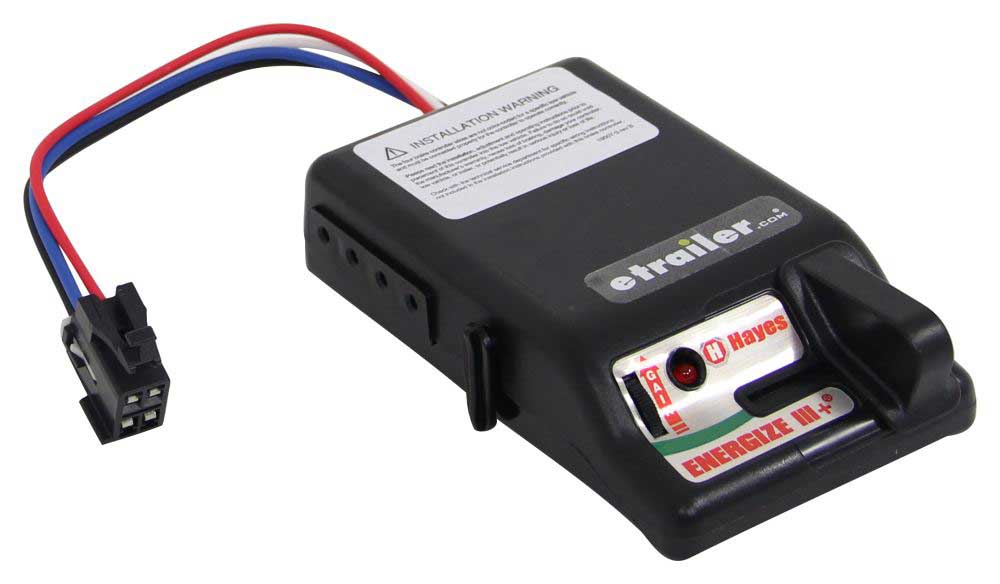
Aftermarket electric brake controllers send electronic signals to the trailer brakes when the driver hits the tow vehicle’s brake pedal. There are lots of types of controllers, and most allow the driver to manually apply the trailer brakes via a dash-mounted controller if needed. Photo courtesy eTrailer.com
How do RV trailer brakes work?
Electric-actuated RV trailer brakes on bumper-pull can be either drum or disc, much like those that stop your tow vehicle. The braking is applied when an electrical signal is transmitted from the brake pedal to a separate device in the vehicle called a brake controller , which then signals and activates the trailer’s brakes.
In an electric drum brake system, the braking signal goes to an electromagnetic actuator inside the brake drum that pushes the brake linings into the drum. On an electric-over-hydraulic disc braking system, the signal from the controller activates a hydraulic pump that pushes fluid in the brake lines to the calipers that engage the brake rotor.
Some of the newest pickups and SUVs have built-in brake controllers, while older pickups and most cars, crossovers, and SUVs will need an aftermarket brake controller unit installed. Either way, it’ll be up to you to make the proper brake controller adjustments per that particular brake controller’s instructions.
Both braking systems require the proper trailer plug, the correct trailer wiring setup in the tow vehicle, and a charged battery in the trailer to operate safely. Part of most vehicle manufacturers’ “Towing Package” includes such wiring and plug for the trailer wiring harness.
Typical travel trailer weights
When you shop for RV travel trailers, you’ll see a wide range in gross vehicle weight ratings (GVWR), even in the tiny trailers and off-road trailers. For instance, the typical teardrop trailer comes in between 1,500 and 2,500 pounds, with the more robust overlanding off-road trailers coming in with a GVWR between 2,500 to 4,500 pounds. Pop-up tent and hard-sided campers generally have GVWRs between 2,000–4,000 pounds.
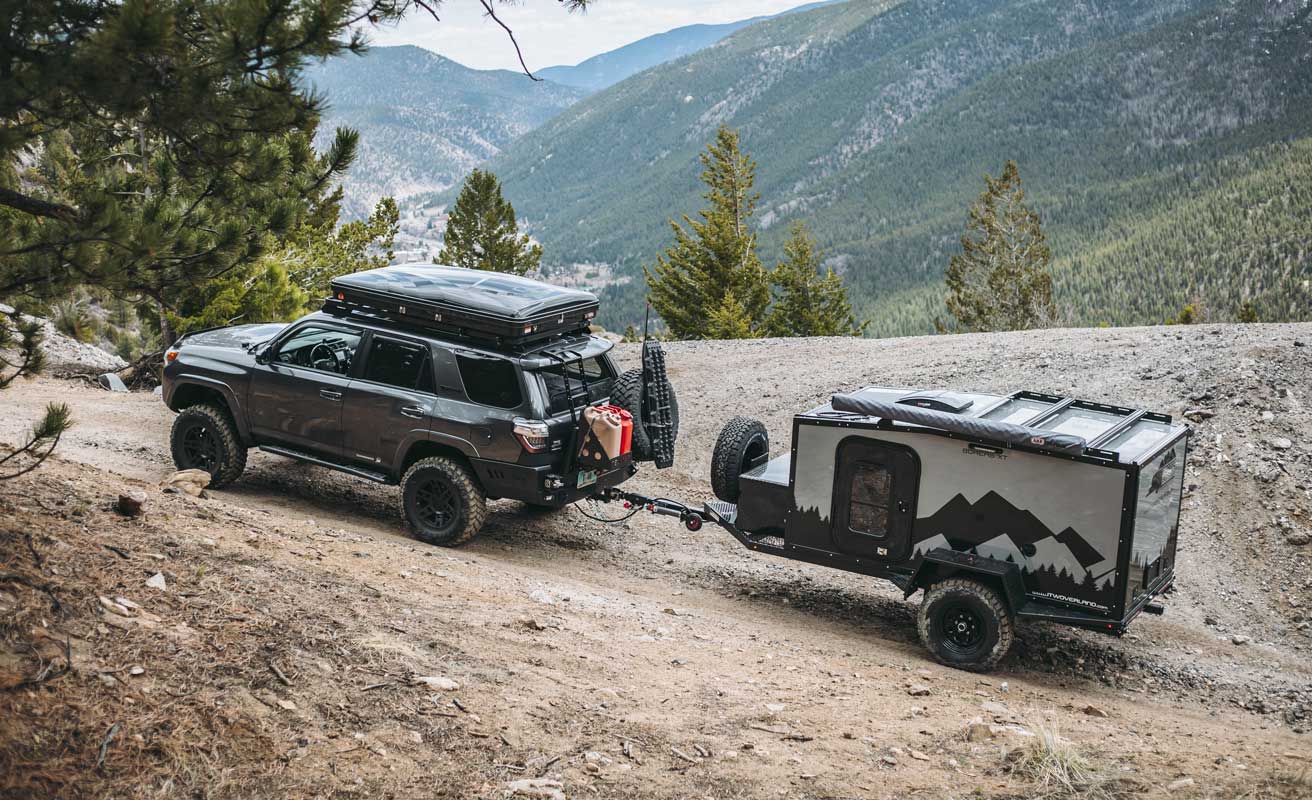
RV trailers are available to fit just about any lifestyle. They also vary in weight, so it’s easy to find the perfect travel trailer to fit your tow vehicle. Some adventuresome RVers—of an estimated 10 million taking vacations with a trailer in tow—will be doing so on roads less traveled. Photo courtesy Boreas Campers
More traditional bumper-pull RV trailers have an average GVWR range related to their length, design (camper or toy hauler), and number of slideouts. Midsize RV trailers in the 23- to 28-foot range have a maximum loaded weight between 6,000 and 8,000 pounds.
Start shopping around for the 30-foot-plus bumper-pull trailers and the GVWRs can top 10,000 pounds, which is nearing the upper limit for most full-size pickups and SUVs towing with a weight-distributing hitch.
Popular trailers for towing and average weights
While there are hundreds of travel trailer brand and specification combinations we could list, we’ll focus on some well-known RVs to give you a sense of what to look for when shopping for a trailer to tow:
Where do electric pickups fit in with towing RV trailers?
Electric vehicles, aka EVs, are slowly making their way into the automotive market but still only make up less than 2 percent of the new car market in the U.S., according to Pew Research and other market watchers.
EVs, whether car, SUV, crossover, or pickup, are excellent modes of transportation for city and urban settings. Not so much so in rural America, where the availability of designated plug-in sites is few and far between. EV vehicles also cost a lot more than their gas and diesel counterparts. If the current federal tax incentives or EV tax credits are phased out, that price disparity will be even greater.
Then there’s the cost of EV ownership over the life of the vehicle to consider, along with trade-in value. After all, all batteries wear out, and the packs in EVs are no different.
What will it cost to replace an EV’s battery pack in 100,000 miles or 10 years? It’s not going to be cheap. A Greencars.com article claims that cost could be as high as $15,000, not including labor.
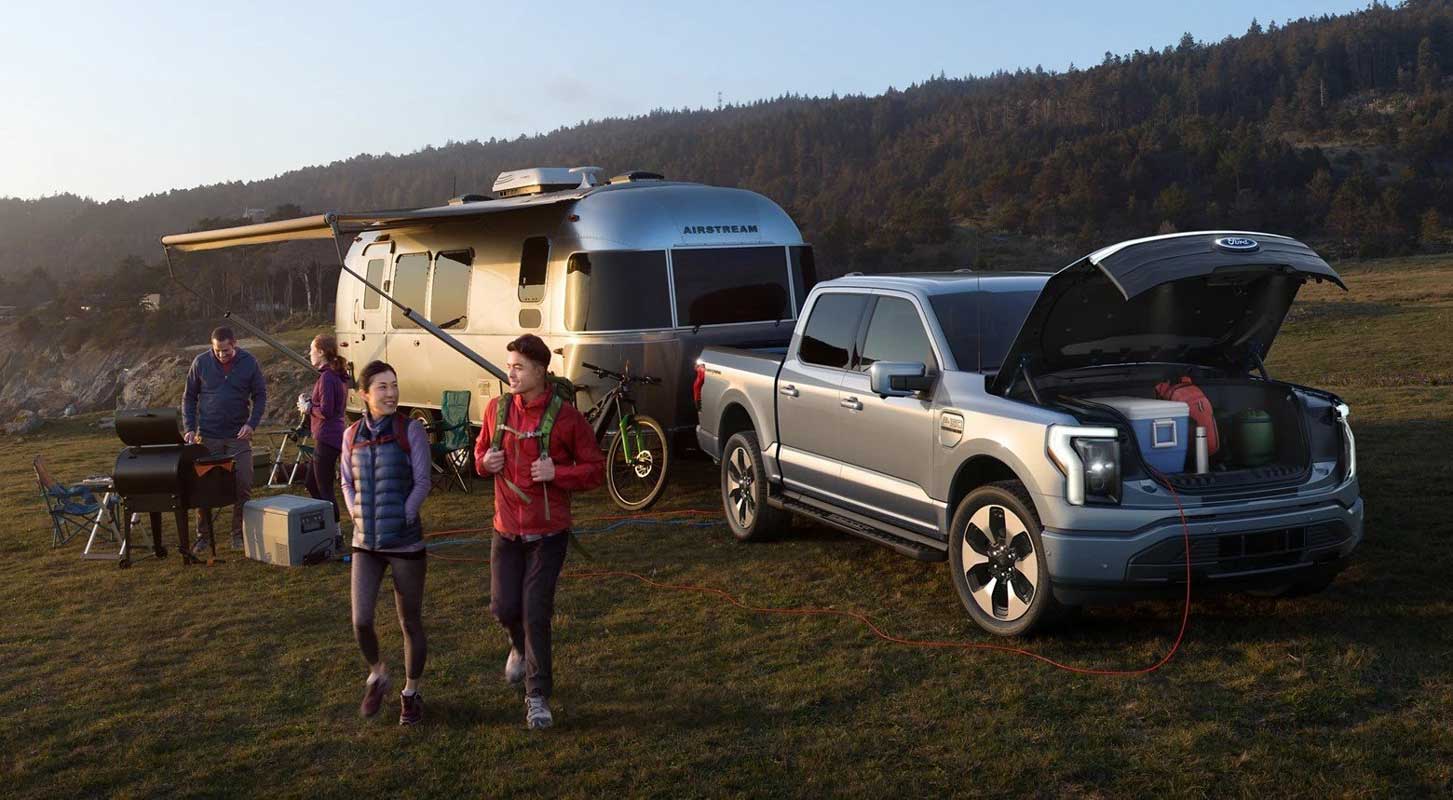
All-electric (EV) pickups are emerging from different vehicle manufacturers as battery technology advances. One of the great things about EV pickups and SUVs is the engine compartment becomes a big trunk! Photo courtesy Ford
RV trailer towing range for EV pickups
Trailer towing brings up another matter: driving range. EV pickup’s capability in distance between charges is cut by 1/3 to ½ when towing a travel trailer. So instead of being able to drive 250–300 miles unloaded, you’ll need to look for a place to plug in every 3 to 4 hours. That’s not convenient and not what most RVers want in a tow vehicle.
Ford’s 2022 F-150 Lightning , with a towing capacity of 10,000 pounds, sports EPA range numbers of 230 miles for the “standard” battery pack and 300 miles with the optional “extended range” pack. The trailering range is probably going to be around 150–200 miles depending on the battery pack.
The F-150 EV battery packs require 10 to 13 hours to fully recharge with the Ford Charge Station Pro , which plugs into either 120V or 240V outlets. We’ll probably see EV charges common as their evolution continues.
Sure, the EV F-150 can be turned into a backup power station, but that power comes from the battery pack, good for off-grid camping but shortening the driving range even more. So, if you’re keen on going green by towing your travel trailer with an EV, keep the driving range in mind.

EV pickups are hitting the road, and RVers are taking note. The 2022 Ford Lightning EV has a trailer towing capacity of 10,000 pounds and a range estimated at 150–200 miles between charges when towing, depending on the battery pack option. Photo courtesy Ford
Tow ratings for EV pickups & SUVs
*Unloaded **GM has not released final numbers
Now that you know how to match a tow vehicle to a travel trailer and set it up safely, you’re ready to tow like a pro. It’s time to head out on the road, have fun, and make wonderful memories. That’s what the RV life is all about!
Make your next RV trip even easier and more enjoyable with an RV-safe GPS . With it, you can get directions custom tailored to the height and weight of your tow vehicle and travel trailer. The turn-by-turn navigation, including voice- and lane-guidance, works even when you’re offline. No more worrying about steep mountain passes, low clearances, bridge weight limits, or propane-restricted tunnels.
Continue reading:
- 7 Things You Need To Know For Safe RV Towing
- What Is Your Gross Vehicle Weight (And Why Does It Matter)?
- 4 Trailer Safety Tips That Could Save Your Life

Towing Capacity Guide
Attention: Your vehicle's max towing capacity includes passenger weight, added accessories, any current liquids in tanks, and any cargo you've added such as food, clothes, chairs, grills, games, tools, etc.. For purposes of Find an RV I can Tow, we've allowed 1000 lbs for RVs over 8000 lbs, 750 lbs for RVs under 8000 lbs, and 500 lbs for RVs under 5000 lbs for average Cargo Weight. Always confirm your specific tow vehicles towing capacity directly from your vehicle's manufacturer before purchasing or towing an RV. You are responsible for the decision to operate your vehicle and any RV you may tow. If your specific vehicle is not listed, please contact us for assistance.
Terms & Definitions
- Dry Weight/Shipped Weight - The weight of the RV as shipped from the manufacturer without any passengers, cargo, liquids, or additional accessories or dealer installed options.
- Gross Vehicle Weight (GVW) - The current combined weight of the RV (dry weight) plus passengers, cargo, and liquids.
- Gross Vehicle Weight Rating (GVWR) - The maximum allowed weight of an Vehicle/RV, including passengers, cargo, fluids, etc..
- Cargo Weight - The total weight of all passengers, food, clothing, liquids, accessories, etc.. that you might put into your RV.
- Tongue/Hitch Weight - The weight/pressure applied from the trailer tongue/coupler to the conventional/bumper hitch on your vehicle.
- Pin Weight - This is often referred to as the weight/pressure applied from fifth wheel king pin to the hitch in the bed of your truck.
- Payload Capacity - For Trucks the amount of weight you can safely add to the bed of the truck. Your Fifth Wheels Hitch Weight or Pin Weight plus the actual weight of hitch plus any other accessories you have in the bed of the truck must not exceed the Payload Capacity amount. Confirm Payload Capacity with your vehicle’s manufacturer.
- Max Towing Capacity - The maximum weight limit that can safely be towed by your specific vehicle. This weight is calculated by adding the RV’s GVW with weight of all passengers, cargo, and liquids in your tow vehicle.
You are using an outdated browser. Please upgrade your browser to improve your experience.
Provide us with some basic info and we’ll appraise your RV.
Tell us about the RV you currently own:
Tell us about the rv you're looking for:.
Your message was sent successfully
A representative has been notified and will be with you shortly.
Essential Tips for Towing a Travel Trailer: A Comprehensive Guide
Welcome to the world of towing a travel trailer! Whether you’re a seasoned RVer or a newcomer to the RV lifestyle, towing a travel trailer opens up a world of adventure, allowing you to explore diverse landscapes, create cherished memories, and embark on unforgettable journeys. However, towing a travel trailer comes with its own set of considerations, responsibilities, and skills to ensure a safe and enjoyable experience.
In this comprehensive guide, we aim to equip you with a wealth of knowledge and practical tips to navigate the intricacies of towing a travel trailer. From understanding your trailer’s weight and capacity to selecting the right tow vehicle, distributing weight properly, and performing pre-trip inspections, each aspect plays a crucial role in ensuring a smooth towing journey.
But that’s not all. We delve into maneuvering and backing up techniques, the importance of allowing for extra stopping distance, adjusting your driving habits for towing, being mindful of the height and length of your trailer, and monitoring tire pressure for optimal performance. We’ll also cover essential topics such as staying updated on regulations, considering weather conditions, embracing environmental responsibility, being prepared for emergencies, optimizing fuel efficiency, practicing towing etiquette, and even exploring frequently asked questions.
Throughout this guide, our aim is to empower you with the knowledge and skills needed to confidently navigate the roads with your travel trailer in tow. We’ll provide detailed insights, practical advice, and helpful tips garnered from experienced RVers, experts, and industry professionals. By following these guidelines and implementing best practices, you can embark on your towing adventures with confidence, peace of mind, and the ability to make the most of every moment.
Whether you’re planning a cross-country road trip, weekend getaways to your favorite camping spots, or a leisurely exploration of natural wonders, towing a travel trailer offers you the freedom and flexibility to create your own itinerary, embrace the beauty of the great outdoors, and forge lifelong connections with fellow travelers.
So, let’s dive in and embark on this comprehensive towing journey together. From the essentials to the finer details, we’ll cover everything you need to know to tow a travel trailer safely, efficiently, and responsibly. Get ready to unlock a world of possibilities and embark on the adventure of a lifetime!

Table of Contents
- 1 Know Your Trailer’s Weight and Capacity
- 2 Use the Right Tow Vehicle
- 3 Distribute Weight Properly
- 4 Perform a Pre-Trip Inspection
- 5 Practice Maneuvering and Backing Up
- 6 Allow for Extra Stopping Distance
- 7 Adjust Your Driving Habits
- 8 Be Mindful of Height and Length
- 9 Monitor Tire Pressure
- 10 Stay Updated on Regulations
- 11 Weather Considerations
- 12 Emergency Preparedness
- 13 Fuel Efficiency Tips
- 14 Parking and Storage
- 15 Insurance and Legal Considerations
- 16 Environmental Responsibility
- 17 Towing Etiquette and Campground Courtesy
- 18 Towing with Pets
- 19 Technology and Towing
- 20 Troubleshooting and Maintenance Tips
- 21 Frequently Asked Questions
- 22 Final Thoughts
Know Your Trailer’s Weight and Capacity
Understand Trailer Weight Terminology : When it comes to trailer weight, it’s essential to understand a few key terms:
- Gross Vehicle Weight Rating (GVWR) : This is the maximum weight that a trailer is designed to carry, including the weight of the trailer itself, cargo, and fluids (such as water and propane). Exceeding the GVWR can compromise the trailer’s structural integrity and safety.
- Dry Weight (Unloaded Vehicle Weight or Base Weight) : This refers to the weight of the trailer without any cargo, fluids, or personal belongings. It includes the weight of standard equipment installed by the manufacturer.
- Cargo Carrying Capacity (CCC) : Also known as payload capacity, CCC represents the maximum weight of cargo and personal belongings that can be added to the trailer.
Consult the Trailer Documentation : Review the trailer’s documentation, including the owner’s manual and any weight-related stickers or plates affixed to the trailer. These documents provide valuable information about the trailer’s weight ratings, such as the GVWR, tongue weight capacity, axle ratings, and tire load ratings. Familiarize yourself with these specifications before loading your trailer.
Weigh Your Loaded Trailer : To accurately determine your trailer’s weight, consider taking it to a public weigh station or using portable weighing scales designed for RVs and trailers. This will help you understand the actual weight of your trailer when loaded with cargo, fluids, and personal belongings. Comparing this weight to the GVWR will ensure that you’re not overloading your trailer.
Calculate Tongue Weight : Tongue weight is the downward force exerted on the hitch ball by the trailer’s tongue. It plays a crucial role in maintaining stability while towing. Typically, tongue weight should be around 10% to 15% of the trailer’s total weight. You can measure tongue weight using a specialized scale or by using weight-distributing hitches that include built-in tongue weight measurement systems.
Determine Your Tow Vehicle’s Towing Capacity : Check your tow vehicle’s owner manual or consult with the manufacturer to determine its towing capacity. This specification indicates the maximum weight the vehicle can safely tow. Ensure that the towing capacity exceeds the GVWR of your loaded trailer to maintain safe towing conditions.
Consider Weight Distribution Hitches : Weight distribution hitches (WDH) are invaluable tools for towing large travel trailers. They help distribute the trailer’s weight evenly across all wheels, reducing strain on the tow vehicle’s rear axle and improving stability. Consider using a weight distribution hitch if your trailer’s tongue weight exceeds the recommended limits or if you experience rear sagging or poor steering control.
Pay Attention to Payload Capacity : In addition to the towing capacity, consider your tow vehicle’s payload capacity. This represents the maximum weight of passengers, cargo, and hitch weight that the vehicle can handle. Make sure the combined weight of the passengers, cargo, and tongue weight of the trailer doesn’t exceed the payload capacity to maintain proper vehicle handling and performance.
By understanding your trailer’s weight and capacity, you’ll be able to make informed decisions when it comes to loading, towing, and ensuring the safety and stability of your travel trailer. Always prioritize safety and stay within the recommended weight limits to enjoy a smooth and enjoyable towing experience.
Use the Right Tow Vehicle
Consider the Towing Capacity : One of the primary factors to consider when selecting a tow vehicle is its towing capacity. Towing capacity refers to the maximum weight a vehicle can safely tow. It is determined by factors such as engine power, transmission, frame strength, suspension, and cooling systems. Refer to your vehicle’s owner manual or consult with the manufacturer to determine its towing capacity.
Analyze Gross Combined Weight Rating (GCWR) : The Gross Combined Weight Rating (GCWR) is the maximum weight limit for both the tow vehicle and the trailer when they are fully loaded. It includes the combined weight of the vehicle, passengers, cargo, fuel, and the trailer itself. Ensure that the GCWR of your tow vehicle is higher than the total weight of your loaded trailer to maintain safe towing conditions.
Evaluate Engine Performance and Torque : A robust engine with ample horsepower and torque is essential for towing heavy trailers. Consider a vehicle with an engine that can deliver sufficient power to handle the added weight and overcome steep inclines without straining. Higher torque values are particularly advantageous for maintaining momentum while towing uphill or when faced with challenging driving conditions.
Check Transmission Type : An appropriate transmission is crucial for towing. Automatic transmissions are generally preferred for towing because they offer smoother gear shifts and better torque management. Look for vehicles with transmissions specifically designed for towing, which may include features like tow/haul modes or manual gear selection to optimize performance while towing.
Assess Braking System : Adequate braking capability is vital when towing a travel trailer. Ensure that your tow vehicle is equipped with a reliable and robust braking system. Consider vehicles with features like electronic trailer brake controllers , which enable the synchronization of the trailer’s braking system with the tow vehicle’s brakes for better control and stopping power.
Verify Suspension and Stability Control : A well-designed suspension system is essential for maintaining stability and ride comfort while towing. Look for vehicles equipped with heavy-duty suspension components and technologies like load-leveling systems or rear air suspension, which help mitigate the effects of added weight on the tow vehicle. Additionally, advanced stability control systems, such as electronic stability control (ESC), can enhance towing safety by reducing the risk of trailer sway and maintaining stability in challenging driving conditions.
Assess Cooling Systems : Towing places an extra load on the engine and transmission, causing them to generate more heat. Adequate cooling systems, such as larger radiators, transmission coolers, and engine oil coolers, are crucial to prevent overheating and ensure optimal performance while towing. Verify that your chosen tow vehicle is equipped with the necessary cooling systems for towing heavy loads.
Consult with Professionals : If you’re unsure about selecting the right tow vehicle for your travel trailer, it’s advisable to consult with professionals such as RV dealerships or towing specialists. They can offer expert advice based on your specific trailer’s weight, dimensions, and towing requirements, helping you make an informed decision.
Choosing the right tow vehicle is crucial for a safe and comfortable towing experience. By considering factors such as towing capacity, engine performance, transmission, braking system, suspension, cooling systems, and seeking professional guidance when needed, you’ll be well-equipped to tow your travel trailer with confidence and peace of mind.
Distribute Weight Properly
Proper weight distribution within your travel trailer is essential for maintaining stability and control while towing. The goal is to evenly distribute the weight across the trailer’s axles to prevent excessive strain on the hitch and tow vehicle, and to maintain balanced handling characteristics.
Consider Tongue Weight : Tongue weight is the downward force exerted on the hitch ball by the trailer’s tongue or coupler. It plays a significant role in maintaining stability during towing. Aim for a tongue weight that is approximately 10% to 15% of the total trailer weight (when loaded). You can measure tongue weight using specialized scales or by using weight-distributing hitches with built-in tongue weight measurement systems.
Load Heavier Items Towards the Front : When loading your travel trailer, place heavier items towards the front, closer to the axle. This helps maintain proper tongue weight and keeps the trailer balanced. Heavier items could include water tanks (if positioned towards the front), generators, batteries, or larger equipment. Avoid placing heavy items towards the rear, as it can lead to improper weight distribution and potentially cause trailer sway.
Balance Side-to-Side Weight : Ensure that weight is evenly distributed from side to side within the trailer. Imbalanced weight can lead to handling issues and put stress on the trailer’s suspension. Pay attention to how you load items and distribute weight throughout the interior of the trailer. Make adjustments as needed to achieve balance.
Avoid Overloading : Respect the trailer’s weight capacity and avoid overloading it. Exceeding the Gross Vehicle Weight Rating (GVWR) can lead to structural damage, tire failure, and unsafe towing conditions. Consider the combined weight of passengers, cargo, fluids, and equipment to ensure it stays within the recommended limits.
Secure Loose Items : Secure all items within the trailer to prevent shifting during transit. Loose items can disrupt weight distribution, affect stability, and potentially cause damage. Utilize straps, cargo nets, or other securing mechanisms to keep everything in place.
Keep a Low Center of Gravity : Maintaining a low center of gravity contributes to better stability while towing. Whenever possible, place heavier items lower in the trailer, such as closer to the floor or lower storage compartments. This helps minimize the risk of top-heavy situations that can lead to swaying or tipping.
Regularly Reassess Weight Distribution : Periodically assess and adjust the weight distribution within your trailer, especially during extended trips. As you consume resources or add new items, the weight distribution can shift. Take the time to redistribute weight as needed to maintain proper balance and stability.
Remember, proper weight distribution is crucial for safe and controlled towing. By understanding the importance of tongue weight, loading heavier items towards the front, balancing weight side-to-side, avoiding overloading, securing loose items, keeping a low center of gravity, and regularly reassessing weight distribution, you’ll ensure a smoother and more enjoyable towing experience with your travel trailer.
Perform a Pre-Trip Inspection
Performing a thorough pre-trip inspection is crucial to ensure the safety and reliability of your travel trailer before embarking on any journey. Follow these steps to conduct a comprehensive pre-trip inspection:
Check the Exterior : Inspect the exterior of your travel trailer for any signs of damage, such as dents, cracks, or loose panels. Pay close attention to the roof, sidewalls, and undercarriage. Check the condition of the windows, doors, and awnings, ensuring they open, close, and latch properly. Look for any signs of leaks, including water stains or soft spots.
Inspect the Hitch and Coupler : Examine the hitch and coupler to ensure they are in good condition and securely connected. Verify that the coupler is properly locked onto the hitch ball, and check the safety latch or locking mechanism. Confirm that all safety chains are properly attached and in good working order.
Test the Lights and Signals : Check all the exterior lights and signals on both the tow vehicle and the trailer. This includes headlights, brake lights, turn signals, taillights, and clearance lights. Replace any bulbs that are burnt out, and ensure all the wiring connections are secure. Consider having a second person assist you in verifying the functionality of the lights and signals as you activate them.
Verify the Brake System : Test the trailer’s brake system to ensure it is functioning properly. This includes electric brakes or surge brakes, depending on the type of system your trailer has. Activate the brakes using the brake controller or by applying pressure to the surge brake actuator (if applicable). Listen for any unusual noises, and ensure the brakes engage and release smoothly.
Check the Tires : Inspect the tires on both the tow vehicle and the trailer. Look for signs of wear, such as uneven tread wear or sidewall damage. Ensure that the tires are inflated to the correct pressure, as indicated by the manufacturer’s recommendations. Check the tire sidewalls for the maximum load rating, and make sure it exceeds the weight of your loaded trailer.
Inspect the Wheel Bearings and Suspension : Examine the wheel bearings and suspension components of the trailer. Look for any signs of excessive wear, corrosion, or damage. Lubricate the wheel bearings if necessary, following the manufacturer’s guidelines. Test the suspension by pushing down on each corner of the trailer to check for proper movement and rebound.
Test the Trailer’s Brakes and Breakaway System : Verify that the trailer’s electric brakes or surge brakes are operating correctly. If your trailer has an electric brake system, activate the brakes using the brake controller and ensure they respond effectively. If your trailer is equipped with a breakaway system, test it by pulling the breakaway switch to activate the brakes without the tow vehicle connected. Confirm that the brakes engage and hold the trailer in place.
Check the Safety Equipment : Inspect the safety equipment on the trailer, such as the fire extinguisher, smoke detectors, and carbon monoxide detectors. Ensure they are in working order and have not expired. Check the status of the trailer’s emergency exit windows and hatches, verifying that they open easily.
Verify the Trailer’s Plumbing and Electrical Systems : If your trailer has plumbing and electrical systems, inspect them for any leaks, damaged connections, or loose wiring. Test the water pump, faucets, toilets, and any other plumbing fixtures. Check the electrical outlets, switches, and appliances, ensuring they are functioning correctly.
Secure Loose Items : Before hitting the road, secure any loose items within the trailer to prevent shifting during transit. Check cabinets, drawers, and other storage areas to ensure everything is properly stowed and secured.
By conducting a comprehensive pre-trip inspection, you’ll identify any potential issues or maintenance needs that require attention before you start your journey. Taking the time to perform these checks will help ensure a safer and more enjoyable travel experience with your trailer.
Practice Maneuvering and Backing Up
Find an Open Space : To practice maneuvering and backing up your travel trailer, find an open space such as an empty parking lot, a quiet street, or a spacious campground. Ensure that the area provides enough room for you to make turns and perform various maneuvers safely.
Start with Basic Maneuvers : Begin by practicing basic maneuvers to get a feel for how your trailer responds to steering inputs. Start with simple turns, both left and right, to understand the turning radius of your tow vehicle and trailer combination. Take note of any limitations or differences compared to driving without a trailer.
Master Straight-Line Reversing : Start with straight-line reversing to gain confidence in controlling the trailer’s direction while moving backward. Use your mirrors and visual reference points to align your trailer with the desired path. Make small, precise steering adjustments and take it slow. Keep in mind that reversing with a trailer may require turning the steering wheel in the opposite direction compared to normal driving.
Use Reference Points : Reference points can help you gauge the trailer’s position while maneuvering or backing up. Use the side mirrors to establish reference points on the trailer, such as the corners or edges, to guide your movements. With practice, you’ll develop a better sense of the trailer’s position and how it tracks behind the tow vehicle.
Practice Turning and Cornering : Once you’re comfortable with straight-line reversing, practice making turns and corners with your trailer. Approach turns slowly and widen your turning radius to accommodate the increased length of the trailer. Be mindful of the trailer’s swing and the potential for the rear to cut corners more tightly than the tow vehicle.
Utilize Spotter Assistance : Having a second person, known as a spotter, can greatly assist in maneuvering and backing up your trailer. The spotter can provide guidance and communicate with you using hand signals or two-way radios. Establish clear signals beforehand to indicate when to stop, turn, or adjust your course. Maintain open communication with your spotter to ensure a smooth and coordinated operation.
Practice Parallel Parking : Parallel parking with a trailer can be challenging but is an essential skill. Find a suitable space and practice aligning your trailer parallel to the curb or other vehicles. Use a combination of your mirrors, spotter assistance, and reference points to guide your positioning. Take your time, make small adjustments, and be patient throughout the process.
Consider Taking a Driving Course : If you’re new to towing or want to enhance your skills, consider enrolling in a trailer towing course. These courses provide hands-on training, professional guidance, and valuable tips for safe and effective towing. Instructors can help you refine your techniques and build confidence in various towing maneuvers.
Be Mindful of Obstacles and Clearance : While practicing maneuvers and backing up, be aware of any obstacles, curbs, or low-hanging branches that could impact your trailer. Keep a safe distance from other vehicles or objects, especially when reversing. Take note of height clearances to avoid damaging the trailer’s roof or air conditioning units.
Learn from Experience : Practice regularly and learn from your experiences. Each towing situation may present unique challenges, and the more you practice, the better you’ll become at handling your travel trailer. Take note of what works well for you, learn from any mistakes or challenges, and continually improve your towing skills.
Remember, practice makes perfect. By dedicating time to practice maneuvering and backing up your travel trailer, you’ll develop the necessary skills and confidence to handle different towing scenarios. Always prioritize safety, stay patient, and be aware of your surroundings while maneuvering your trailer.
Allow for Extra Stopping Distance
Understand the Impact of Towing : Towing a travel trailer significantly increases the overall weight and length of your rig, which affects braking performance. It’s crucial to recognize that towing requires a longer stopping distance compared to driving without a trailer. Understanding this impact is vital for safe towing.
Maintain a Safe Following Distance : To account for the increased stopping distance, maintain a safe following distance between your tow vehicle and the vehicle ahead. The recommended guideline is to leave at least a four-second gap between your trailer and the vehicle in front of you. This provides you with adequate time to react and brake if a sudden stop occurs.
Anticipate Braking Situations : When towing a travel trailer, it’s important to anticipate potential braking situations well in advance. Stay alert and watch for any changes in traffic flow, upcoming intersections, or road conditions that may require you to slow down or stop. Being proactive in recognizing potential hazards allows you to adjust your speed and braking accordingly.
Brake Smoothly and Gradually : When it’s time to apply the brakes, do so smoothly and gradually. Avoid sudden or hard braking, as it can cause the trailer to sway or skid. Apply consistent pressure to the brake pedal to bring your vehicle and trailer to a controlled stop. Smooth braking helps maintain stability and prevents the trailer’s brakes from locking up.
Use Trailer Brakes : If your travel trailer is equipped with electric brakes, ensure they are properly connected and in working order. Trailer brakes provide additional stopping power and can assist in reducing the load on your tow vehicle’s brakes. Adjust the brake controller settings to achieve the appropriate braking force for your trailer’s weight and road conditions.
Engage Engine Braking : Take advantage of engine braking, also known as downshifting or using lower gears, to assist with stopping your trailer. Engine braking helps slow down your rig while reducing the strain on the tow vehicle’s braking system. Utilize the tow/haul mode, if available, to optimize engine braking performance.
Be Prepared for Emergency Stops : In emergency situations, such as sudden obstacles or the need to avoid collisions, be prepared for more aggressive braking. However, it’s crucial to maintain control of your trailer during these maneuvers. Apply the brakes firmly but progressively, steering to maintain stability and avoiding oversteering or excessive swaying.
Adjust Speed to Road and Weather Conditions : Road and weather conditions can significantly affect your stopping distance while towing. Reduce your speed when driving on wet, icy, or slippery roads to allow for increased stopping distances. Adjust your driving to match the conditions, as traction and braking capabilities can be compromised in adverse weather.
Consider Weight Distribution and Load : Proper weight distribution within your trailer plays a role in braking performance. Ensure that the weight is balanced and not overloaded towards the rear, as this can affect the stability and braking effectiveness. Regularly assess the weight distribution and make adjustments as needed.
Maintain Regular Maintenance : Regularly maintain your tow vehicle’s braking system and trailer’s braking components. This includes inspecting brake pads, rotors, brake fluid levels, and adjusting the trailer’s brake controller as necessary. Properly maintained brakes contribute to optimal stopping performance.
By allowing for extra stopping distance and being mindful of the increased weight and length of your towed travel trailer, you’ll enhance safety and control while on the road. Remember to maintain a safe following distance, brake smoothly and gradually, utilize trailer brakes and engine braking, adjust speed to road conditions, and prioritize regular maintenance to ensure reliable braking performance while towing.
Adjust Your Driving Habits
Moderate Your Speed : When towing a travel trailer, it’s essential to adjust your driving speed. Higher speeds can increase the risk of trailer sway and reduce your ability to react to sudden changes on the road. Maintain a moderate speed that allows for better control, stability, and sufficient reaction time.
Avoid Sudden Lane Changes : Towing a travel trailer requires careful planning and deliberate movements. Avoid abrupt or sudden lane changes, as they can cause the trailer to sway or affect the stability of your tow vehicle. Signal well in advance, check your mirrors, and make smooth lane changes to maintain control.
Use Your Mirrors Frequently : Develop a habit of checking your mirrors frequently while towing. This allows you to monitor the position of your trailer, the traffic behind you, and any potential issues on the road. Utilize your side mirrors and, if available, extended towing mirrors to have a clear view of your trailer’s surroundings.
Take Turns Wider : The increased length of your rig requires wider turns to avoid mounting curbs, hitting obstacles, or encroaching into neighboring lanes. Take turns wider than you would without a trailer, giving yourself ample room to navigate safely. Pay attention to signs indicating the appropriate turning radius for larger vehicles.
Be Cautious on Hills and Inclines : When driving on hills or inclines, adjust your speed and gear selection to maintain control and prevent strain on your vehicle’s engine and transmission. Ascend hills at a steady pace, and consider downshifting to utilize engine braking on descents. Be cautious of your trailer’s weight and ensure it doesn’t exceed the recommended limits for safe towing.
Plan Ahead for Passing and Merging : Passing or merging with a trailer requires careful planning. Allow for extra time and space when executing these maneuvers. Signal well in advance, check for sufficient gaps in traffic, and accelerate gradually to complete the maneuver safely. Be aware of your trailer’s length and account for the additional time needed to pass or merge.
Stay Focused and Avoid Distractions : Towing a travel trailer demands your full attention on the road. Minimize distractions inside the vehicle, such as using mobile devices or adjusting entertainment systems. Keep conversations with passengers to a minimum and prioritize safe driving practices. Maintaining focus allows you to react promptly to any changes or hazards.
Monitor Weather and Road Conditions : Weather and road conditions can significantly impact towing safety. Stay informed about weather forecasts along your route and be prepared to adjust your driving accordingly. Reduce your speed on wet or slippery roads, be cautious of crosswinds, and exercise extra care during adverse weather conditions.
Take Breaks and Rest : Long hours on the road can be tiring, so plan for regular breaks to rest and refresh yourself. Fatigue can impair your judgment and reaction times, compromising your ability to tow safely. Take breaks at designated rest areas, stretch your legs, and rehydrate. If possible, share driving responsibilities with another licensed driver.
Practice Defensive Driving : Adopt a defensive driving mindset while towing a travel trailer. Be aware of the actions and behaviors of other drivers around you. Anticipate potential hazards, maintain a safe distance from other vehicles, and stay prepared to react to sudden changes in traffic or road conditions.
By adjusting your driving habits while towing a travel trailer, you’ll enhance safety and maintain better control of your vehicle. Moderating your speed, avoiding sudden lane changes, utilizing mirrors frequently, taking wider turns, planning for passing and merging, staying focused, monitoring weather and road conditions, taking breaks when needed, and practicing defensive driving contribute to a safer and more enjoyable towing experience.
Be Mindful of Height and Length
Know Your Trailer’s Height and Length : Before you hit the road, it’s crucial to be aware of the height and length of your travel trailer. Measure the height of your trailer from the ground to the highest point, such as the air conditioning unit or antenna. Measure the overall length from the front of the tow vehicle to the back of the trailer, including any accessories or attachments.
Check Height Restrictions : Many bridges, tunnels, gas stations, parking garages, and other structures have height restrictions. Before planning your route, research and identify potential height restrictions along the way. Take note of any low-clearance areas that may pose a risk to your trailer. Plan alternative routes if necessary to avoid these obstacles.
Utilize GPS or Navigation Apps : Use a GPS device or navigation app specifically designed for RVs and trailers . These tools can provide information on height restrictions, low-clearance areas, and RV-friendly routes. Input your travel trailer’s dimensions into the device or app to receive customized directions that take your trailer’s height and length into account.
Display Height Warning Signs : Attach a prominent height warning sign to the inside of your tow vehicle’s windshield. This serves as a constant reminder of your travel trailer’s height, helping you stay vigilant and avoid collisions with low structures or obstacles.
Be Cautious when Entering and Exiting : Exercise caution when entering and exiting driveways, parking lots, and other areas with angled or steep entrances. Assess the slope of the entry point to ensure that your travel trailer’s underside, such as the rear bumper or spare tire, doesn’t scrape against the ground. Take these areas slowly and at an angle if necessary to avoid damaging the trailer.
Allow for Extra Space : When changing lanes or maneuvering through tight spaces, give yourself extra clearance. Remember that your trailer extends beyond the rear of your tow vehicle, and its wide turns can encroach on neighboring lanes. Always check your mirrors and blind spots to ensure there’s sufficient space to safely complete the maneuver.
Communicate with Spotter Assistance : If available, use a spotter to guide you in tight or tricky situations. A spotter can provide directions, ensure clearance from objects or structures, and communicate any potential risks. Establish clear hand signals or use two-way radios to maintain effective communication between you and the spotter.
Be Mindful of Overhanging Branches : Pay attention to overhanging tree branches along your route, especially when driving through wooded areas or campgrounds. Trimmed branches may still have low-hanging sections that could scrape or damage the roof or other components of your travel trailer. Stay aware and choose routes that minimize the risk of contact with branches.
Watch Out for Driveway Dips and Uneven Surfaces : Be cautious of steep driveway dips, uneven road surfaces, or speed bumps that could cause the underside of your trailer to scrape or bottom out. Approach these areas slowly and at an angle if needed to minimize the risk of damage.
Practice Height and Length Awareness : Develop a habit of regularly checking your surroundings, including overhead clearance, when navigating in areas with potential height or length restrictions. Be mindful of signs indicating low-clearance areas, tunnels, or bridges. Stay alert and avoid situations where your travel trailer’s height or length may become an issue.
By being mindful of the height and length of your travel trailer, you’ll avoid potential accidents, damage, or inconveniences caused by low-clearance structures or tight spaces. Stay vigilant, utilize specialized navigation tools, display height warning signs, communicate effectively with spotters, and practice awareness of your trailer’s dimensions to ensure a safe and smooth towing experience.
Monitor Tire Pressure
Importance of Proper Tire Pressure : Maintaining proper tire pressure is crucial for both safety and performance while towing a travel trailer. Adequate tire pressure ensures optimal traction, stability, and load-bearing capacity. Incorrect tire pressure can lead to handling issues, increased fuel consumption, premature tire wear, and even tire blowouts. Regularly monitoring and maintaining tire pressure is essential.
Check Manufacturer’s Recommendations : Refer to the travel trailer’s owner manual or check the tire sidewalls for the manufacturer’s recommended tire pressure. The recommended pressure may vary depending on factors such as tire size, load rating, and ambient temperature. Ensure that you adhere to the specific guidelines provided by the manufacturer.
Use a Reliable Tire Pressure Gauge : Invest in a high-quality tire pressure gauge to accurately measure the air pressure in your trailer tires. A digital gauge or a quality analog gauge with a pressure release valve is recommended for precise readings. Avoid relying solely on visual inspections or gas station air pumps, as they may not provide accurate readings.
Monitor Tire Pressure Regularly : Check the tire pressure of your travel trailer’s tires at least once a month, or before each trip. It’s essential to inspect the pressure when the tires are cool, as heat generated during towing can increase tire pressure and provide inaccurate readings. Check the pressure in all tires, including the spare tire if applicable.
Inflate to the Recommended Pressure : Use an air compressor or a reliable air source to inflate the tires to the recommended pressure. Avoid overinflating or underinflating the tires, as both can negatively impact towing performance and tire lifespan. Adjust the pressure gradually, and recheck it with the tire pressure gauge to ensure accuracy.
Consider Load and Weight : Take into account the load and weight distribution in your travel trailer when adjusting tire pressure. If your trailer is heavily loaded or has uneven weight distribution, consult load/inflation tables provided by tire manufacturers. These tables provide specific recommendations for different load ranges to ensure the tires are properly inflated for the given weight.
Monitor Pressure During Trips : While on the road, periodically check the tire pressure of your travel trailer’s tires. Factors like changes in ambient temperature and prolonged driving can affect tire pressure. Consider investing in a reliable tire pressure monitoring system (TPMS) that provides real-time pressure and temperature readings for each tire.
Inspect for Damage or Wear : During tire pressure checks, inspect the tires for any signs of damage, such as cuts, bulges, punctures, or uneven wear. Address any issues promptly to avoid tire failure while towing. If you notice abnormalities or concerns, consult a tire professional for a thorough inspection and necessary repairs or replacements.
Account for Temperature Changes : Keep in mind that tire pressure can fluctuate with changes in temperature. In colder weather, tire pressure tends to decrease, while it may increase in hotter conditions. Adjust the tire pressure accordingly to ensure it remains within the recommended range for safe towing.
Maintain Proper Load Distribution : Proper weight distribution within your travel trailer contributes to even tire wear and optimal tire performance. Avoid overloading individual tires and ensure that the weight is distributed evenly among all tires. This helps maintain proper inflation and minimizes the risk of tire damage or failure.
By monitoring tire pressure regularly and ensuring proper inflation, you’ll enhance safety, handling, and tire longevity while towing your travel trailer. Stay diligent, follow manufacturer recommendations, consider load and weight factors, inspect for damage, and address any concerns promptly to maintain optimal tire performance throughout your journeys.
Stay Updated on Regulations
Research Local and State Regulations : Before embarking on a towing trip with your travel trailer, take the time to research and understand the local and state regulations that may apply to towing. Different regions may have specific rules and requirements regarding trailer size, weight limits, speed limits, towing equipment, and more.
Consult Department of Transportation Websites : Visit the websites of the relevant Department of Transportation (DOT) or transportation authorities for the jurisdictions you’ll be traveling through. These websites often provide detailed information on towing regulations, road restrictions, permit requirements, and any special considerations for towing recreational vehicles.
Understand Weight and Length Restrictions : Familiarize yourself with weight and length restrictions imposed by different jurisdictions. This includes maximum Gross Vehicle Weight Rating (GVWR), overall length limits, and axle weight limits. Ensure that your travel trailer complies with these regulations to avoid legal issues and ensure safe and legal towing.
Research Special Vehicle Requirements : Some areas may have additional requirements for towing vehicles or trailers. For example, certain states may require trailers to have functioning brake systems or safety chains. Research if there are any specific regulations or equipment requirements for towing in the regions you’ll be visiting.
Stay Informed about Road Bans or Construction Zones : Check for any temporary road bans or restrictions that may affect towing in your intended travel route. Some areas impose restrictions on certain types of vehicles or trailers during specific times or in construction zones. Stay updated on any advisories or closures that could impact your towing plans.
Consider International Travel : If you plan to tow your travel trailer across international borders, be aware that each country may have its own regulations and requirements for towing. Research the specific rules and ensure compliance with the local regulations before crossing the border.
Join RV and Towing Associations : Consider joining RV or towing associations that provide resources and updates on towing regulations. These organizations often have knowledgeable staff who can answer questions and offer guidance regarding towing regulations and compliance. They may also provide access to forums or online communities where you can connect with experienced tow vehicle owners.
Engage with Online RV Communities : Participating in online RV communities and forums can be a valuable source of information on towing regulations. Interacting with experienced RV enthusiasts and fellow travelers allows you to tap into their knowledge and experiences. Seek advice, share information, and stay informed about any changes in towing regulations.
Follow Social Media Accounts of Transportation Authorities : Follow the social media accounts of transportation authorities and relevant government agencies. They often share updates, road advisories, and regulatory changes that may affect towing. By staying connected to these sources, you’ll receive real-time information about any towing-related news or updates.
Regularly Review and Update Your Knowledge : Towing regulations can change over time, so it’s important to regularly review and update your knowledge. Stay informed about any new laws, regulations, or requirements that may impact your towing activities. Check for updates at least before each trip to ensure compliance with the latest regulations.
By staying updated on regulations and towing requirements, you’ll ensure that you’re towing your travel trailer in a legal and safe manner. Research local and state regulations, consult DOT websites, understand weight and length restrictions, stay informed about road bans or construction zones, consider international travel requirements, join RV and towing associations, engage with online RV communities, follow transportation authorities on social media, and regularly review and update your knowledge to stay informed about towing regulations.
Weather Considerations
Weather conditions have a significant impact on towing safety and can greatly influence your travel experience with a travel trailer. Being mindful of weather considerations is essential for ensuring your safety, maintaining control of your vehicle, and protecting your travel trailer. Consider the following factors when towing in various weather conditions:
Wind : Strong winds can affect the stability and handling of your travel trailer. High gusts can push against the broadside of the trailer, causing it to sway or even veer off course. Be particularly cautious when driving in areas prone to strong crosswinds, such as open plains or coastal regions. Reduce your speed and maintain a firm grip on the steering wheel to counteract the effects of wind gusts. Consider adjusting your route or timing if strong winds are forecasted.
Rain : Driving in wet conditions requires heightened caution. Rain reduces traction and increases stopping distances, making it essential to maintain a safe following distance from other vehicles. Slow down and avoid sudden maneuvers or harsh braking, as these actions can cause skidding or loss of control. Ensure that your trailer’s tires have sufficient tread depth and are in good condition to handle wet roads effectively. Keep windshield wipers in optimal working condition to maintain visibility.
Snow and Ice : Towing a travel trailer in snowy or icy conditions demands even more caution. Before setting out, ensure that your tow vehicle and trailer are equipped with appropriate tires for winter driving. Consider using winter tires or tire chains if necessary. Reduce your speed significantly and increase your following distance to allow for longer stopping distances. Avoid sudden braking, acceleration, or steering inputs, as these can cause skidding or sliding. Stay informed about road conditions and closures, and be prepared with appropriate winter supplies, such as a snow shovel and ice scraper.
Extreme Temperatures : Extreme temperatures can impact both your tow vehicle and travel trailer. In hot weather, monitor the engine and transmission temperatures of your tow vehicle to prevent overheating. Ensure that your trailer’s tires are properly inflated and that your vehicle’s cooling system is in good working order. Consider using reflective window coverings or shades to reduce the interior heat of the trailer. In cold weather, take precautions to prevent freezing of your tow vehicle’s systems, such as using antifreeze and ensuring that all fluid levels are appropriate. Keep your travel trailer adequately heated to prevent freezing of water lines and tanks.
Severe Weather Events : Be prepared for severe weather events such as thunderstorms, hailstorms, or hurricanes. Stay informed about weather forecasts along your route and plan your travel accordingly. If severe weather is imminent, consider delaying your trip or finding a safe place to park and wait it out. Seek shelter in designated storm shelters if necessary. Always prioritize your safety and the safety of your passengers by avoiding travel during extreme weather conditions.
Plan for Weather-Related Delays : Weather conditions can lead to road closures, traffic congestion, or other delays. Factor in extra travel time when towing a travel trailer, especially in areas prone to inclement weather. Stay updated on weather and road conditions by using weather apps, local news channels, or transportation authority websites. Adjust your itinerary as needed to ensure safe and efficient travel.
Remember, your safety and the safety of others on the road should be your top priority. Adjust your driving habits to match the weather conditions, maintain proper following distances, and be prepared for unexpected weather changes. By staying vigilant and mindful of weather considerations, you can navigate various weather conditions while towing your travel trailer with confidence.
Emergency Preparedness
When towing a travel trailer, it’s essential to be prepared for emergencies that may arise on the road. Having a well-thought-out emergency plan and the necessary supplies can make a significant difference in ensuring your safety and the safety of your passengers. Consider the following tips for emergency preparedness:
Create an Emergency Kit : Assemble an emergency kit specifically tailored for your towing adventures. Include essential items such as a first aid kit , flashlight with extra batteries, roadside flares or reflective triangles, a multipurpose tool, duct tape, tire pressure gauge, jumper cables, basic hand tools, a fire extinguisher, and a portable air compressor. Additionally, consider adding items such as a spare tire, jack, lug wrench, and a tow strap or rope.
Carry Emergency Supplies : Pack necessary supplies that can sustain you and your passengers in case of an emergency. This may include non-perishable food items, bottled water, blankets or sleeping bags, extra clothing, personal hygiene items, prescription medications, and a portable phone charger or power bank. Customize the supplies based on the needs of your family or travel companions.
Know Emergency Contact Information : Have a list of important emergency contact numbers readily available, including local authorities, roadside assistance providers, your insurance company, and any specific contacts related to your travel trailer or towing setup. Store these contacts in your phone and have a hard copy in your glove compartment or the emergency kit.
Develop an Emergency Plan : Create an emergency plan that outlines what to do in different scenarios, such as breakdowns, accidents, or severe weather events. Share this plan with your travel companions and ensure everyone understands their roles and responsibilities. Establish a meeting point in case you get separated and have a communication plan in place, including a designated person to contact if you’re unable to do so.
Stay Informed : Stay informed about weather conditions, road closures, and any advisories that may impact your travel. Use weather apps, local news channels, and transportation authority websites to stay updated on current conditions. Consider utilizing a weather radio or mobile alerts to receive real-time weather updates while on the road.
Share Your Travel Plans : Inform a trusted friend or family member about your travel plans, including your intended route, estimated arrival times, and any planned stops. Regularly check in with them during your journey to provide updates on your progress and inform them of any changes to your plans.
Maintain Roadside Assistance Coverage : Consider investing in a roadside assistance program that specifically covers towing or RV-related incidents. These programs can provide valuable assistance in case of breakdowns, tire changes, lockouts, or towing needs. Review the coverage details and ensure it aligns with your towing setup and travel trailer.
Stay Calm and Follow Safety Procedures : In the event of an emergency, it’s crucial to remain calm and follow proper safety procedures. This may include moving your travel trailer to a safe location, activating hazard lights, and using reflective triangles or flares to alert other drivers. Follow established safety protocols for dealing with accidents, fires, or medical emergencies.
Stay Connected : Ensure that you have reliable means of communication, such as a fully charged cell phone with a strong signal or a two-way radio. Familiarize yourself with the coverage areas of your service provider and have alternative communication options available, such as a satellite phone or a Citizen’s Band (CB) radio.
Practice Basic Vehicle Maintenance : Regularly maintain your tow vehicle and travel trailer to minimize the risk of mechanical failures. This includes checking fluid levels, inspecting tires for wear or damage, ensuring the trailer’s braking system is functioning correctly, and conducting routine maintenance as recommended by the manufacturer. Proper maintenance reduces the likelihood of unexpected breakdowns and enhances towing safety.
By being prepared for emergencies, you can handle unexpected situations more effectively and ensure the safety and well-being of yourself, your passengers, and your travel trailer. Take the time to assemble an emergency kit, carry necessary supplies, know emergency contact information, develop an emergency plan, stay informed, maintain roadside assistance coverage, stay calm during emergencies, stay connected, and practice regular vehicle maintenance. With these preparations in place, you can navigate emergencies with greater confidence and peace of mind while towing your travel trailer.
Fuel Efficiency Tips
When towing a travel trailer, maximizing fuel efficiency is beneficial both for your wallet and the environment. Towing adds extra weight and drag to your tow vehicle, which can impact fuel consumption. By implementing the following fuel efficiency tips, you can optimize your towing setup and reduce fuel consumption:
Tow with the Right Vehicle : Select a tow vehicle that is appropriately sized and equipped for towing your travel trailer. Check the manufacturer’s towing specifications and ensure that your vehicle’s engine, transmission, and towing capacity are suitable for the weight and size of your trailer. Using a vehicle that is well-matched to your trailer can improve fuel efficiency.
Reduce Excess Weight : Only pack essential items for your trip and remove any unnecessary cargo or equipment from your travel trailer and tow vehicle. Extra weight increases fuel consumption, so keeping your load as light as possible is beneficial. Consider using lightweight camping gear and packing strategically to minimize weight without compromising necessary supplies.
Streamline Your Trailer : Make efforts to reduce aerodynamic drag on your travel trailer. Consider using an aerodynamic nose cone or cover for the front of the trailer to reduce wind resistance. Keep the trailer’s exterior clean and free from unnecessary protrusions or accessories that can create drag. Streamlining your trailer can help reduce fuel consumption while towing.
Maintain Proper Tire Pressure : Maintaining the correct tire pressure is essential for fuel efficiency. Underinflated tires can increase rolling resistance and fuel consumption. Regularly check the tire pressure of both your tow vehicle and travel trailer, ensuring they are inflated to the recommended levels provided by the manufacturer. Optimal tire pressure can help improve fuel efficiency.
Use Fuel-Efficient Driving Techniques : Adopt fuel-efficient driving techniques while towing. Accelerate gradually and smoothly, avoiding rapid acceleration that can strain your engine and increase fuel consumption. Maintain a consistent speed and avoid unnecessary speed fluctuations. Anticipate traffic flow and use cruise control when appropriate to maintain a steady pace, which can aid fuel efficiency.
Optimize Cruise Control Usage : Utilize cruise control when driving on long, flat stretches of road. Cruise control can help maintain a consistent speed, preventing unnecessary speed variations that can impact fuel consumption. However, avoid using cruise control on hilly or mountainous terrain, as it may cause your vehicle to downshift more frequently and consume more fuel.
Plan Efficient Routes : When mapping your travel route, consider selecting the most fuel-efficient route. Look for routes with fewer hills, lower speed limits, and less traffic congestion. Utilize GPS devices or navigation apps that offer options for optimizing fuel-efficient routes specifically for towing. Efficient route planning can help reduce fuel consumption.
Utilize Tow/Haul Mode : If your tow vehicle is equipped with a tow/haul mode, use it while towing. This mode adjusts the vehicle’s transmission shift points, throttle response, and engine braking to optimize performance while towing. It can enhance fuel efficiency by enabling the engine and transmission to work more efficiently under towing conditions.
Avoid Excessive Idling : Minimize idling time while towing your travel trailer. Idling consumes fuel without any productive use and adds unnecessary emissions. Instead, turn off your engine when parked for extended periods, except when necessary for safety or comfort.
Monitor and Maintain Your Vehicle : Regularly monitor and maintain your tow vehicle to ensure optimal fuel efficiency. Keep up with recommended maintenance schedules, including engine tune-ups, air filter replacements, and oil changes. Properly lubricated components and well-maintained systems contribute to better fuel efficiency.
By implementing these fuel efficiency tips, you can reduce fuel consumption and make the most of your towing adventures with your travel trailer. Tow with the right vehicle, reduce excess weight, streamline your trailer, maintain proper tire pressure, use fuel-efficient driving techniques, optimize cruise control usage, plan efficient routes, utilize tow/haul mode, avoid excessive idling, and monitor and maintain your vehicle for optimal fuel efficiency while towing.
Parking and Storage
Proper parking and storage of your travel trailer are crucial for its safety, security, and convenience. Whether you need to park your trailer during a trip or store it for an extended period, following the right practices can help ensure the longevity of your trailer and make your towing experiences more enjoyable. Consider the following tips for parking and storage:
RV Parks and Campgrounds : Utilize RV parks and campgrounds that provide designated spaces for travel trailers. These facilities typically offer amenities such as electrical hookups, water connections, and dump stations, making them convenient for short-term stays. Research and make reservations in advance to secure a spot that meets your needs.
Private Storage Facilities : If you require long-term or off-season storage for your travel trailer, consider renting a storage space at a private storage facility. Look for reputable facilities that offer secure and monitored areas for RV storage. Ensure that the facility has appropriate space for your trailer’s size and any additional requirements, such as electrical access for battery charging.
Residential Parking : Check local regulations and homeowner association rules regarding parking your travel trailer at your residence. Some neighborhoods have restrictions on storing trailers or have designated areas for parking recreational vehicles. Ensure that you comply with any parking restrictions and be considerate of your neighbors’ space and privacy.
Driveway Parking : If allowed by local regulations and within the limits of your property, parking your travel trailer in your driveway can provide convenience and easy access. Ensure that your driveway is wide enough and offers adequate clearance for maneuvering the trailer. Take into account any local restrictions on the length or height of trailers parked in residential driveways.
Street Parking : In areas where street parking is permitted, you may be able to park your travel trailer on the street. However, be mindful of local regulations, parking permits, and any time restrictions that may apply. Ensure that the trailer does not obstruct traffic, driveways, or fire hydrants, and avoid parking in areas prone to high traffic or where the trailer may be vulnerable to damage or theft.
Backing into Parking Spaces : Mastering the skill of backing your travel trailer into parking spaces is essential for convenience and safety. Practice maneuvering and backing up in open areas such as empty parking lots to build your confidence and improve your skills. Take your time, use your mirrors, and consider enlisting the help of a spotter for better accuracy.
Storage Covers : Consider using a storage cover to protect your travel trailer when parked for extended periods. Quality covers can shield the trailer from dust, UV rays, and the elements, preventing damage to the exterior. Ensure that the cover is properly fitted and secure to avoid flapping or damage from wind.
Leveling and Stabilizing : When parking your travel trailer, ensure that it is properly leveled and stabilized. Use leveling blocks or ramps to achieve a level position, both front-to-back and side-to-side. Stabilizing jacks or wheel chocks can help prevent rocking or movement while parked, enhancing your comfort and stability inside the trailer.
Security Measures : Take appropriate security measures to protect your travel trailer when parked or stored. Install wheel locks, hitch locks, or trailer security systems to deter theft. Consider using motion sensor lights or surveillance cameras if parking the trailer on your property for added security.
Check Local Regulations and Permits : Before parking or storing your travel trailer, familiarize yourself with any local regulations or permits required for long-term parking or storage. Some areas may have restrictions on how long a trailer can be parked on the street or in certain locations. Adhere to the rules to avoid fines or towing.
By following these parking and storage tips, you can ensure the safety, security, and convenience of your travel trailer. Utilize RV parks and campgrounds, consider private storage facilities, check local regulations for residential parking, practice backing into parking spaces, use storage covers, level and stabilize the trailer, implement security measures, and comply with local regulations and permits. Proper parking and storage will help protect your investment and provide peace of mind during your towing adventures.
Insurance and Legal Considerations
When towing a travel trailer, it’s important to understand the insurance and legal considerations associated with your activities. Ensuring that you have appropriate insurance coverage and complying with the relevant laws and regulations will help protect you, your tow vehicle, and your travel trailer. Consider the following tips for insurance and legal considerations:
Review Your Insurance Policy : Contact your insurance provider and review your existing auto insurance policy to determine if it covers towing a travel trailer. Inquire about any specific coverage requirements or limitations for towing. If necessary, consider adding comprehensive coverage, collision coverage, or an umbrella policy to provide additional protection for your tow vehicle and travel trailer.
RV Insurance : Consider obtaining specialized RV insurance for your travel trailer. RV insurance policies often offer comprehensive coverage tailored to the unique risks associated with recreational vehicles. These policies may include coverage for theft, damage, liability, personal belongings, and emergency expenses specific to RV travel.
Liability Coverage : Ensure that you have adequate liability coverage for both your tow vehicle and travel trailer . Liability coverage protects you in case of accidents where you are at fault and covers any damages or injuries caused to other parties. Consult with your insurance provider to determine the recommended coverage limits for your specific towing setup.
Registration and License Plates : Check the local regulations regarding the registration and license plate requirements for your travel trailer. Some jurisdictions may require a separate registration and license plate for the trailer, while others may allow you to use the same registration as your tow vehicle. Comply with the applicable requirements to avoid legal issues while towing.
Trailer-Specific Insurance Considerations : When selecting insurance coverage for your travel trailer, consider the following factors:
- Agreed Value vs. Actual Cash Value : Determine if you want coverage based on the agreed value (the value agreed upon between you and the insurance provider) or the actual cash value (the current market value) of your travel trailer. Agreed value coverage generally offers more protection for older trailers or trailers with customization.
- Total Loss Replacement : Inquire about total loss replacement coverage, which provides compensation to replace your travel trailer with a new one of similar make and model if it is deemed a total loss.
- Contents Coverage : Evaluate whether you need contents coverage for your personal belongings inside the travel trailer. This coverage protects against loss or damage to items such as furniture, appliances, clothing, and electronics.
Roadside Assistance : Consider adding roadside assistance coverage to your insurance policy or obtaining it separately. Roadside assistance can provide valuable services such as towing, battery jump-starts, flat tire changes, lockout assistance, and fuel delivery. This coverage can be especially helpful during towing emergencies or breakdowns.
Compliance with Towing Laws and Regulations : Familiarize yourself with the towing laws and regulations in the jurisdictions where you’ll be traveling. Understand the maximum weight limits, length restrictions, and any specific towing equipment requirements, such as safety chains or trailer brake systems. Adhere to these regulations to ensure safe and legal towing.
Permit Requirements : For oversized or overweight travel trailers, check if special permits are required for certain routes or jurisdictions. Some areas may have restrictions on travel trailer size, weight, or dimensions that necessitate obtaining permits in advance. Research permit requirements and obtain them as needed to comply with local regulations.
International Travel Considerations : If you plan to tow your travel trailer across international borders, research and comply with the insurance and legal requirements of the countries you’ll be visiting. This may include specific insurance coverage, border crossing procedures, and permit requirements. Consult with your insurance provider and relevant authorities for guidance.
Documentations and Proof of Insurance : Ensure that you have all necessary documentation and proof of insurance readily available while towing. Keep a copy of your insurance policy, registration documents, and any permits or relevant legal paperwork in your tow vehicle. Additionally, carry proof of insurance cards or digital copies that can be easily accessed if needed.
By addressing insurance and legal considerations, you can protect yourself, your tow vehicle, and your travel trailer while adhering to the applicable laws and regulations. Review your insurance policy, consider RV insurance, maintain adequate liability coverage, comply with registration and license plate requirements, understand trailer-specific insurance factors, ensure compliance with towing laws and regulations, obtain necessary permits, and carry relevant documentation and proof of insurance. With proper insurance coverage and legal compliance, you can enjoy your towing adventures with peace of mind.
Environmental Responsibility
As outdoor enthusiasts, it’s important to prioritize environmental responsibility while towing a travel trailer. By adopting eco-friendly practices, you can minimize your impact on the environment and help preserve the natural beauty of the places you visit. Consider the following tips for practicing environmental responsibility:
Leave No Trace : Adhere to the principles of Leave No Trace (LNT) to minimize your impact on the environment. These principles include:
- Plan ahead and prepare : Research and understand the regulations and guidelines for the areas you’ll be visiting. Pack responsibly and bring necessary supplies to minimize waste.
- Dispose of waste properly : Dispose of trash, wastewater, and sewage in designated areas. Use designated dump stations or facilities for wastewater disposal. Pack out what you pack in and leave the natural environment as you found it.
- Leave what you find : Do not disturb or remove natural features, plants, or artifacts. Preserve the natural environment for others to enjoy.
- Minimize campfire impacts : Follow fire regulations and use established fire rings or designated fire areas. Completely extinguish fires before leaving, ensuring they are cold to the touch.
- Respect wildlife : Observe wildlife from a distance and avoid approaching or feeding them. Do not disrupt their natural behaviors or habitats.
- Be considerate of other visitors : Respect other campers and travelers by keeping noise levels to a minimum and maintaining a clean and organized campsite.
Minimize Waste : Practice waste reduction by adopting strategies such as:
- Bring reusable containers and water bottles to minimize single-use plastics.
- Use refillable propane cylinders or other alternatives to disposable fuel canisters.
- Opt for biodegradable or eco-friendly cleaning and personal care products.
- Avoid excessive packaging when purchasing supplies for your travel trailer.
Conserve Water and Energy : Promote water and energy conservation while traveling:
- Use water sparingly by taking quick showers and turning off faucets when not in use.
- Collect and reuse graywater for activities such as cleaning or watering plants, where permitted.
- Utilize energy-efficient appliances and LED lighting inside your travel trailer.
- Turn off lights and unplug electronics when not in use to minimize energy consumption.
Camp Responsibly : Choose established campgrounds or designated camping areas whenever possible. These areas are equipped with proper facilities and infrastructure to minimize the environmental impact of camping. Follow campground rules and guidelines, including any specific instructions for waste disposal, campfire usage, and wildlife interactions.
Respect Sensitive Areas : Be aware of environmentally sensitive areas and respect their protection. This may include fragile ecosystems, wildlife habitats, or areas with endangered species. Follow any signage or guidance provided to ensure you do not disturb or harm these areas.
Practice Sustainable Driving Habits : Adopt fuel-efficient driving techniques to reduce carbon emissions and fuel consumption:
- Drive at moderate speeds and maintain a steady pace to optimize fuel efficiency.
- Avoid unnecessary idling to minimize emissions and fuel waste.
- Plan efficient routes to reduce travel distance and time spent on the road.
Support Local Conservation Efforts : Consider contributing to local conservation initiatives or organizations that work towards protecting the natural environment and outdoor spaces. Donations or volunteering can help support ongoing conservation efforts in the areas you visit.
Educate and Encourage Others : Share your knowledge and experiences with fellow travelers to raise awareness about environmental responsibility. Encourage others to follow eco-friendly practices and respect the natural environment. By setting a positive example and spreading awareness, you can inspire others to adopt sustainable habits.
By practicing environmental responsibility, you can contribute to the preservation of natural landscapes and minimize your ecological footprint while enjoying your travel trailer adventures. Follow the principles of Leave No Trace, minimize waste, conserve water and energy, camp responsibly, respect sensitive areas, practice sustainable driving habits, support local conservation efforts, and educate and encourage others to do the same. Let’s strive to protect and preserve the natural beauty of our outdoor destinations for future generations to enjoy.
Towing Etiquette and Campground Courtesy
When towing a travel trailer and staying at campgrounds, it’s important to practice towing etiquette and campground courtesy. Being considerate and respectful of fellow campers and the campground environment enhances everyone’s experience and fosters a positive RV community. Consider the following tips for towing etiquette and campground courtesy:
Respect Quiet Hours : Observe and adhere to quiet hours established by the campground. Typically, quiet hours are designated during nighttime to ensure a peaceful environment for all campers. Avoid excessive noise, loud conversations, or running generators during these hours. Be mindful of others who may be resting or sleeping nearby.
Observe Campsite Boundaries : Respect the boundaries of your campsite and give neighboring campers ample space. Avoid encroaching on adjacent campsites with vehicles, equipment, or personal belongings. Be aware of designated walkways or common areas and avoid blocking them.
Follow Campground Rules : Familiarize yourself with the campground’s rules and regulations. Each campground may have specific guidelines regarding things like campfires, pet policies, speed limits, and waste disposal. Adhere to these rules to ensure a harmonious environment and the safety of all campers.
Practice Proper Waste Disposal : Dispose of waste and garbage properly. Use designated trash receptacles or dumpster areas for trash disposal. Follow campground guidelines for recycling and separate recyclable items accordingly. If camping in remote or backcountry areas, practice Leave No Trace principles and pack out all trash and waste.
Be Mindful of Campfire Etiquette : If campfires are allowed, follow proper campfire etiquette. Maintain fires within designated fire rings or fire pits. Use only the firewood provided or gather deadfall from the surrounding area, following any firewood restrictions in place. Completely extinguish fires before leaving the campsite or going to bed.
Keep Noise Levels Down : Be considerate of noise levels at all times. Avoid loud music, excessive vehicle noise, or rowdy behavior that may disturb fellow campers. Keep conversations and activities at a reasonable volume to respect the tranquility of the campground.
Leash and Clean Up After Pets : If bringing pets, ensure they are kept on a leash and under control at all times. Be considerate of other campers who may be uncomfortable around animals or have allergies. Clean up after your pets promptly and dispose of waste in designated areas.
Be Courteous During Set-Up and Breakdown : When setting up or breaking down your campsite, be mindful of noise levels and avoid unnecessary disturbances to neighboring campers. Minimize the use of power tools or noisy equipment during quiet hours. Complete these tasks efficiently and respectfully.
Offer Assistance and Be Friendly : Embrace the RV community spirit by offering assistance and being friendly to your fellow campers. Help others who may be struggling with their set-up or offer tips and advice when appropriate. Foster a sense of camaraderie and be open to making new friends during your camping experiences.
Leave the Campsite Clean : When it’s time to leave, ensure your campsite is clean and free from debris. Pack out all trash and dispose of it properly. Check for any items left behind, such as ropes, stakes, or personal belongings. Leave the campsite in the same or better condition than when you arrived.
By following these towing etiquette and campground courtesy tips, you contribute to a welcoming and respectful camping environment. Respect quiet hours, observe campsite boundaries, follow campground rules, practice proper waste disposal, be mindful of campfire etiquette, keep noise levels down, leash and clean up after pets, be courteous during set-up and breakdown, offer assistance, and leave the campsite clean. Together, we can create a positive and enjoyable camping experience for all.
Towing with Pets
Towing a travel trailer with pets can be a rewarding and enjoyable experience. However, it’s important to prioritize the safety and comfort of your furry friends throughout the journey. Whether you’re traveling with dogs, cats, or other pets , consider the following tips for towing with pets:
Ensure Pet Safety : The safety of your pets is paramount while towing. Secure your pets inside the tow vehicle or travel trailer using appropriate restraints or carriers. Use pet seat belts, harnesses, or crates that are specifically designed for vehicle travel. This prevents them from roaming freely and potentially causing distractions or injuries.
Familiarize Pets with the Travel Trailer : Before embarking on your trip, introduce your pets to the travel trailer gradually. Allow them to explore the trailer while it’s stationary, making it a positive and comfortable space for them. This helps them adjust to the new environment and reduces anxiety during travel.
Create a Cozy and Safe Space : Designate a comfortable area inside the travel trailer for your pets. Set up their bedding, toys, and familiar items to create a cozy and secure space. Ensure proper ventilation and temperature control to keep them comfortable throughout the journey.
Pack Essential Pet Supplies : Bring along all necessary supplies for your pets. This includes food, water, bowls, medications, litter boxes, litter, waste disposal bags, toys, and any other items they may need. Stick to their regular diet to minimize gastrointestinal issues, and have enough supplies to last the duration of your trip.
Plan for Regular Exercise and Bathroom Breaks : Pets, especially dogs, require regular exercise and bathroom breaks. Plan for stops along the way to allow them to stretch their legs, relieve themselves, and get some exercise. Research pet-friendly areas or dog parks along your route for convenient breaks.
Never Leave Pets Unattended : Never leave your pets unattended in the travel trailer, especially during extreme weather conditions. High temperatures can quickly become dangerous, even with ventilation or air conditioning. If you need to leave the trailer, make sure someone stays with your pets or consider using pet daycare services.
Keep Pets Hydrated : Provide access to fresh water for your pets throughout the journey. Use spill-proof bowls or containers that are secured to prevent tipping or spilling while the vehicle is in motion. Monitor their water intake and offer regular opportunities for them to drink.
Temperature Control : Maintain a comfortable temperature inside the travel trailer. Ensure proper ventilation and use air conditioning or fans when necessary to keep the interior cool during hot weather. In colder temperatures, provide adequate insulation and heating to keep your pets warm.
Take Breaks to Check on Pets : During stops, check on your pets to ensure their well-being. Assess their comfort, offer water, and provide attention and reassurance. Monitor their behavior for any signs of distress or discomfort.
Plan Pet-Friendly Activities : Research pet-friendly attractions, parks, or trails at your destination. Engage in activities that include your pets, such as hiking, walking, or exploring pet-friendly areas. Remember to follow leash laws and any specific pet rules at the locations you visit.
Prepare for Emergencies : Have a pet first aid kit readily available in case of emergencies. Include items such as bandages, antiseptic solutions, medications, and contact information for veterinary services along your travel route. Research and save the contact information for emergency veterinary clinics at your destination.
Pet Identification : Ensure that your pets have proper identification tags with up-to-date contact information. In the event that your pets get lost, having visible identification can help ensure their safe return.
Consider Pet-Friendly Campgrounds : Choose pet-friendly campgrounds or RV parks that cater to the needs of pets. Look for amenities such as dog parks, pet-walking areas, or pet-friendly trails. Be aware of any specific rules or restrictions regarding pets at the campground and respect them.
Gradually Introduce Towing to Pets : If your pets are new to traveling in a towed vehicle, gradually introduce them to the experience. Start with short practice drives to acclimate them to the movement and sounds associated with towing. Offer positive reinforcement and rewards to help them associate towing with positive experiences.
By following these tips, you can ensure a safe, comfortable, and enjoyable towing experience for both you and your pets. Prioritize their well-being, create a cozy space, plan for exercise and bathroom breaks, never leave pets unattended, keep them hydrated, control the temperature, take breaks to check on them, plan pet-friendly activities, prepare for emergencies, ensure proper identification, consider pet-friendly campgrounds, and gradually introduce towing to your pets. Towing with pets can create lasting memories and strengthen the bond between you and your furry companions.
Technology and Towing
Advancements in technology have greatly enhanced the towing experience, making it easier and safer for travelers to tow their travel trailers. From vehicle features to smartphone applications, various technologies can assist you in monitoring and managing your towing setup. Consider the following ways technology can improve your towing experience:
Towing-Specific Vehicle Features : Modern tow vehicles often come equipped with towing-specific features designed to enhance safety and control while towing. Some notable features include:
- Integrated Trailer Brake Controller: Many vehicles now have integrated trailer brake controllers that allow you to control the trailer’s brakes directly from the tow vehicle’s dashboard. This helps improve braking performance and stability while towing.
- Trailer Sway Control: Some vehicles offer built-in trailer sway control systems that use sensors and automated braking to detect and mitigate trailer sway. These systems help improve towing stability and reduce the risk of dangerous trailer oscillation.
- Towing Mirrors: Extended side mirrors or towing-specific mirror attachments provide a wider field of view, allowing you to see alongside and behind the travel trailer more effectively. This improves visibility and helps you maneuver safely.
Backup Cameras and Assistive Technologies : Backup cameras are increasingly common in vehicles and can be especially useful for towing. These cameras provide a clear view of the area behind the travel trailer, making it easier to maneuver and back up safely. Additionally, some vehicles offer assistive technologies such as rear cross-traffic alert, parking sensors, or surround-view cameras to further aid in parking and maneuvering with a travel trailer.
GPS and Navigation Apps : GPS devices and navigation apps are invaluable tools for planning and navigating your towing trips. They provide real-time directions, route optimization, and traffic information to help you find the most efficient and suitable routes for towing. Look for navigation apps or devices that offer specialized features for RVs or trailers, such as height and weight restrictions, campsite locations, or fuel station recommendations.
Towing-Specific Smartphone Apps : There are several smartphone apps specifically designed for towing and RV travel. These apps offer features such as trip planning, campground directories, fuel station locators, and real-time weather updates. Some apps also provide towing checklists, maintenance reminders, and emergency contact information. Explore different towing apps to find the ones that best suit your needs and preferences.
Tire Pressure Monitoring Systems (TPMS) : TPMS is an essential technology for monitoring tire pressure while towing . These systems use sensors installed on the tires to continuously monitor the pressure and temperature of each tire. TPMS provides real-time alerts if there are any abnormalities, helping you maintain optimal tire pressure and reduce the risk of tire-related incidents.
Weight Distribution and Tongue Weight Scales : To ensure safe towing, it’s important to properly distribute the weight and manage the tongue weight of your travel trailer. Portable weight distribution and tongue weight scales are available that allow you to measure and adjust weight distribution while on the road. These scales help you maintain the correct balance and improve towing stability.
Diagnostic OBD-II Scanners : On-board diagnostic (OBD-II) scanners can be used to monitor the health and performance of your tow vehicle’s engine and transmission. These scanners connect to the vehicle’s OBD-II port and provide valuable information, such as diagnostic trouble codes, engine data, and real-time performance metrics. Regularly checking the vehicle’s diagnostics can help you identify any potential issues early on.
Mobile Connectivity and Remote Monitoring : With mobile connectivity and smart home technology, you can monitor and control various aspects of your travel trailer remotely. Some systems allow you to check the trailer’s battery levels, adjust interior climate controls, or monitor security cameras from your smartphone. These features offer convenience and peace of mind while towing.
When utilizing technology while towing, it’s important to familiarize yourself with the features, understand their limitations, and prioritize safe driving practices. Remember that technology is a helpful tool, but it does not replace responsible towing habits, proper maintenance, and attentive driving.
By harnessing the power of technology, you can enhance your towing experience with improved safety, convenience, and efficiency. Utilize towing-specific vehicle features, backup cameras, GPS and navigation apps, towing-specific smartphone apps, TPMS, weight distribution and tongue weight scales, diagnostic OBD-II scanners, and mobile connectivity to make your towing journeys more enjoyable and secure.
Troubleshooting and Maintenance Tips
Proper troubleshooting and maintenance are crucial for ensuring the safety, reliability, and longevity of your travel trailer and towing setup. By implementing regular maintenance routines and addressing common issues promptly, you can minimize the risk of breakdowns and maximize your towing experience. Consider the following tips for troubleshooting and maintenance:
Pre-Trip Inspection : Before each trip, perform a thorough pre-trip inspection of your tow vehicle and travel trailer. Check the tires for proper inflation and signs of damage or wear. Inspect the hitch, safety chains, and electrical connections for any issues. Verify that all lights are functioning correctly, including brake lights, turn signals, and taillights. Confirm that the trailer’s brake system is working properly. Examine the trailer’s exterior for any signs of damage or loose components.
Regular Maintenance Schedule : Follow a regular maintenance schedule for your tow vehicle and travel trailer. Consult the owner’s manuals for both to determine the recommended maintenance intervals and procedures. This may include oil changes, filter replacements, fluid checks, brake inspections, wheel bearing maintenance, and battery maintenance. Adhering to the maintenance schedule ensures that your equipment is in optimal condition for towing.
Wheel Bearing Maintenance : Maintaining the wheel bearings is essential for safe towing. Grease the wheel bearings according to the manufacturer’s specifications or as recommended by your mechanic. This helps reduce friction and prevents heat buildup, which can lead to bearing failure. Regularly inspect the bearings for any signs of wear, damage, or loose parts.
Brake System Maintenance : Ensure the brakes on your travel trailer are properly maintained. Clean and adjust drum brakes as necessary, or inspect and service disc brakes. Regularly check the brake fluid levels and ensure the brake controller in your tow vehicle is properly calibrated. If you notice any issues with braking performance, such as excessive noise, vibrations, or reduced stopping power, have the system inspected by a professional.
Electrical System Checks : The electrical system of your travel trailer plays a vital role in towing safety. Regularly inspect and test the trailer’s electrical connections, including the wiring harness, brake lights, turn signals, and taillights. Check the battery connections and monitor the battery’s charge level. Replace any damaged or worn-out wiring and connectors promptly.
Tire Maintenance : Maintaining proper tire condition and inflation is crucial for safe towing. Check the tire pressure regularly, including the spare tire. Follow the manufacturer’s recommendations for the correct tire pressure and load capacity. Inspect the tires for signs of wear, cracks, or bulges. Rotate the tires periodically to ensure even wear. Replace any tires that are worn beyond the recommended tread depth.
Fluid Levels and Leaks : Regularly check the fluid levels of your tow vehicle, including the engine oil, coolant, transmission fluid, and power steering fluid. Top up any low levels as needed. Monitor for any signs of fluid leaks from the vehicle or travel trailer and address them promptly to prevent further damage.
Lubrication : Keep all moving parts properly lubricated. Apply lubrication to the trailer’s hitch, coupler, and any other moving components. Grease the slide-outs, jacks, and stabilizers if applicable. Regular lubrication helps reduce friction, prevent rust, and maintain smooth operation.
Monitor and Address Warning Lights : Pay attention to any warning lights or error codes displayed on your tow vehicle’s dashboard. If any warning lights illuminate or if you experience abnormal engine behavior, address the issue promptly. Use a diagnostic scanner to retrieve error codes and consult a professional if needed.
Carry Basic Tools and Spare Parts : Keep a basic toolkit and spare parts on hand for minor repairs or adjustments. This may include wrenches, pliers, screwdrivers, fuses, spare bulbs, electrical connectors, and spare tire parts. Being prepared with the necessary tools and spare parts can help you address minor issues while on the road.
Know When to Seek Professional Help : While regular maintenance and troubleshooting can address many issues, it’s important to recognize when to seek professional help. If you encounter significant mechanical problems, electrical issues, or if you’re unsure how to address a specific problem, consult a qualified mechanic or RV technician for assistance.
By implementing these troubleshooting and maintenance tips, you can stay proactive in addressing issues and ensure the optimal performance and safety of your tow vehicle and travel trailer. Regular inspections, adhering to maintenance schedules, checking wheel bearings and brakes, inspecting the electrical system, maintaining tire condition and inflation, monitoring fluid levels and leaks, lubricating moving parts, addressing warning lights, carrying basic tools and spare parts, and knowing when to seek professional help will help you enjoy trouble-free towing experiences.
Frequently Asked Questions
Having questions and seeking answers is a natural part of towing a travel trailer. Whether you’re a seasoned RVer or new to the world of towing, it’s common to have queries about various aspects of the towing experience. In this section, we address some frequently asked questions to provide you with helpful information and guidance. From towing capacities and weight distribution to licensing requirements and maintenance tips, we aim to shed light on common concerns and provide clarity on essential aspects of towing a travel trailer. Read on to find answers to questions that can enhance your understanding and confidence, allowing you to embark on your towing adventures with knowledge and peace of mind.
What size tow vehicle do I need for my travel trailer?
The size of the tow vehicle you need depends on the weight and size of your travel trailer. It’s important to check the towing capacity of your vehicle and ensure it is capable of safely towing the loaded weight of your trailer. Consult your vehicle’s owner’s manual or contact the manufacturer for specific towing capacity information.
How do I determine the weight of my travel trailer?
To determine the weight of your travel trailer, you can refer to the trailer’s manufacturer specifications or look for the Gross Vehicle Weight Rating (GVWR) sticker. This sticker provides the maximum weight limit for the trailer, including the weight of the trailer itself, cargo, and fluids. It’s important not to exceed this weight limit for safe towing.
Do I need a special driver’s license to tow a travel trailer?
The requirements for a special driver’s license to tow a travel trailer vary depending on the weight and size of the trailer, as well as the regulations of your jurisdiction. In many cases, a regular driver’s license is sufficient for towing a travel trailer. However, it’s important to check your local regulations to ensure compliance with any specific licensing requirements.
How do I properly load and distribute weight in my travel trailer?
Properly loading and distributing weight in your travel trailer is crucial for safe towing. Place heavier items low and towards the front of the trailer to maintain proper tongue weight and stability. Distribute the weight evenly from side to side and secure items to prevent shifting during travel. Consult your trailer’s owner’s manual for specific guidelines on weight distribution.
Can I tow a travel trailer with a car or SUV?
Towing a travel trailer with a car or SUV is possible, but it depends on the towing capacity of your vehicle and the weight of the trailer. Smaller cars and SUVs may have limited towing capacities, so it’s important to check your vehicle’s specifications. Consider the size, weight, and towing capacity of your vehicle before towing a travel trailer.
How do I back up a travel trailer?
Backing up a travel trailer can be challenging but with practice, it becomes easier. Use small and deliberate steering inputs, and make adjustments slowly. Use your mirrors and, if available, have a spotter help guide you. Practice in open areas, such as an empty parking lot, to gain confidence and improve your skills.
How often should I check the tire pressure on my travel trailer?
Regularly checking the tire pressure on your travel trailer is essential for safe towing. It is recommended to check the tire pressure before each trip and at regular intervals during long trips. Follow the manufacturer’s guidelines for the recommended tire pressure and ensure all tires are properly inflated to prevent blowouts and maintain optimal handling.
Do I need special insurance for my travel trailer?
While insurance requirements may vary by jurisdiction, it’s generally recommended to have specialized RV insurance or a separate policy for your travel trailer. Regular auto insurance may not provide adequate coverage for your trailer. RV insurance can provide coverage for theft, damage, liability, personal belongings, and emergency expenses specific to RV travel.
Are there restrictions on where I can park or store my travel trailer?
There may be local regulations or homeowner association rules regarding parking or storing your travel trailer. Some neighborhoods have restrictions on storing trailers, while others may have designated areas for parking recreational vehicles. Check the local regulations and adhere to any parking restrictions or permit requirements to avoid fines or towing.
How do I winterize my travel trailer?
Winterizing your travel trailer is important to protect it from freezing temperatures. The process involves draining water from the plumbing system, adding antifreeze to prevent frozen pipes, and protecting the trailer from moisture. Follow the manufacturer’s instructions or consult an RV professional for guidance on properly winterizing your specific trailer.
Remember, these are general answers to frequently asked questions, and it’s always important to consult your vehicle and trailer’s owner’s manuals, local regulations, and seek professional advice when necessary.
Final Thoughts
In conclusion, towing a travel trailer can be an incredibly rewarding and adventurous experience. By following these tips and guidelines, you can ensure a safe, enjoyable, and stress-free towing journey. From knowing your trailer’s weight and capacity to using the right tow vehicle, distributing weight properly, and performing pre-trip inspections, these essential steps set the foundation for a successful towing experience.
Additionally, practicing maneuvering and backing up, allowing for extra stopping distance, adjusting driving habits, being mindful of height and length, monitoring tire pressure, staying updated on regulations, considering weather and environmental responsibilities, preparing for emergencies, promoting fuel efficiency, and practicing towing etiquette and campground courtesy contribute to a seamless and enjoyable towing adventure.
Remember, towing a travel trailer requires careful planning, preparation, and ongoing maintenance. Regularly inspect your trailer and tow vehicle, address issues promptly, and maintain open communication with professionals if needed. By prioritizing safety, environmental responsibility, and respectful behavior, we can ensure the preservation of natural landscapes and create a positive RV community.
As you embark on your towing adventures, embrace the freedom and flexibility that comes with exploring new destinations and creating lasting memories. Take the time to learn and improve your towing skills, seek out resources, and connect with fellow RV enthusiasts to exchange experiences and knowledge. Each towing journey is an opportunity to discover the beauty of the open road, immerse yourself in nature, and forge unforgettable connections with loved ones.
We hope that this comprehensive guide has equipped you with valuable insights and practical tips to enhance your towing experience. Remember to stay informed, adapt to changing conditions, and prioritize safety at all times. Happy towing and may your travel trailer adventures be filled with joy, exploration, and remarkable experiences!
About The Author
Karan Riley
Leave a comment cancel reply.
Save my name, email, and website in this browser for the next time I comment.
JavaScript seems to be disabled in your browser. For the best experience on our site, be sure to turn on Javascript in your browser.
- My Purchase Orders
- Compare Products

- Understanding Towing
- Ultimate Trailer Towing Guide - Chapter 1
Ultimate Trailer Towing Guide

How to Tow a Trailer Safely
10 Common-Sense Trailer Towing Tips
Towing 101 is the ultimate trailer towing guide. It is designed to equip you with the knowledge and confidence to successfully tow a trailer with your vehicle.
This tow guide is perfect for any first time trailer owner, as well as seasoned veterans looking for a refresher. It offers some of the most helpful information about trailering because it is written by industry professionals -- your very own CURT team!
Let's begin with proper trailer towing practices.
1. Choose the right equipment
Having the right tool for the job is paramount in towing. The weight capacity of your vehicle and equipment must be enough to handle your trailer and cargo load.
The size of your hitch and other components is also key to ensuring a secure fit.
Learn more about choosing the right towing equipment or look up your vehicle to find a receiver hitch .

2. Hitch up your trailer correctly
Before towing, make sure you have followed the proper procedures for hooking up your trailer. Double check all connections, including the coupler and wiring, and make sure your safety chains are crossed under the trailer tongue and securely connected.
Learn more about how to hook up a trailer .

Sick of Fighting Your Coupler?
Traditional coupler latches can be one of the biggest causes of stress when hooking up your trailer.
QuickPin™ doesn't have a latch! Instead, this revolutionary coupler uses a single pin for stress-free hookup!
See how it works
3. Allow plenty of stopping distance
You need to increase your following distance when towing a trailer. This means increasing the amount of space between you and the vehicle in front of you. It takes longer to stop with a trailer than it does with your vehicle alone.
Also, it will help prolong the life of your vehicle if you can avoid sudden acceleration, braking and maneuvering.

4. Anticipate problems ahead
The leading cause of accidents both in towing and in normal driving situations is driver error. Some of the main reasons people get into accidents is because they are not paying attention, they are driving too fast, they are tailgating the person in front of them and so on.
Since it takes longer to accelerate, stop, change lanes and turn with a trailer, scan the road ahead farther than you normally would. You can see many problems developing a long way off.
Observe traffic flow and be ready to react if needed.

5. Watch out for trailer sway
Crosswinds, large trucks, downhill grades and high speeds can all lead to trailer sway. If you are not careful, your trailer can start swinging back and forth like a pendulum behind you. The best way to address this problem is with some kind of hitch stabilization device .
If you experience trailer sway, you can also take your foot off the gas and manually apply the trailer brakes with a brake controller. Press the button once and your trailer should align with your tow vehicle.
Learn more about how to use a brake controller .
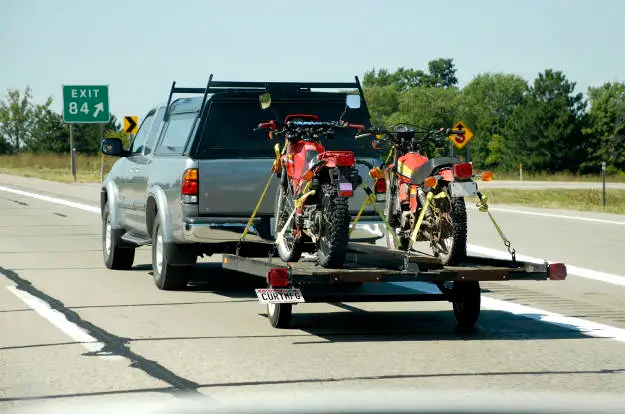
6. Be extra careful when changing lanes
Changing lanes on a highway is a challenge, even when you’re not towing. With a trailer, your blind spots increase, and you can't accelerate as quickly. When changing lanes with a trailer, make sure you have plenty of space and move slowly from one lane to the other.
You can also install tow mirrors to increase your view.

7. Be patient when passing
While towing, you have to allow more distance and time when passing another vehicle or being passed by a vehicle. Passing on a two-lane road should almost never happen. Make sure you have plenty of room to get your vehicle safely up to speed with the trailer in tow.
When being passed by another driver, be patient and remain calm, even if they don't return the favor.
Relax! You'll reach your destination soon enough!

8. Stop gradually whenever possible
Towing a trailer requires extra work from your brakes. You can help prolong the life of your vehicle and trailer brakes by easing into stops as much as possible. Anticipate stops and begin braking sooner than normal.
It is also important to keep your trailer brakes properly adjusted and your brake controller calibrated .
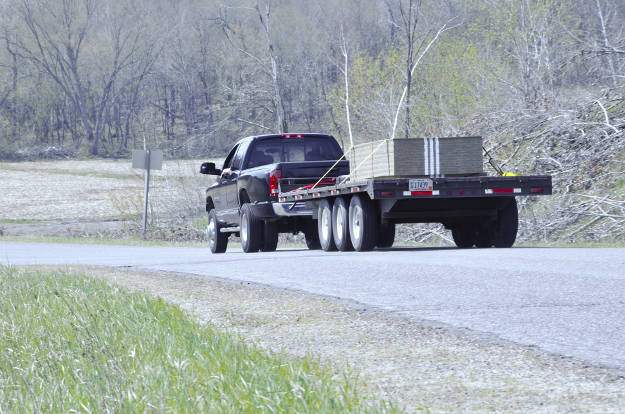
9. Don't drive in if there's no way out
It is easy to get stuck or blocked in with a trailer. For example, you might pull into a small parking lot easy enough, but to get out, you'll have to perform a complicated backup maneuver.
Make sure wherever you pull into that there's plenty of space to make a complete turnaround. Choosing a parking spot that's farther away may be the best option.

10. Keep your towing setup secure
Trailer theft is a serious problem and is always unexpected. A trailer left unattended on its own or even coupled can easily be uncoupled and stolen while you are away.
Use a trailer lock to keep your coupler protected against theft and a hitch lock to keep your trailer hitch secure.
Learn more about how to choose the best lock .

Towing a Trailer Tips!
Throughout this tow trailer guide, look for our Towing Tips! These snippets of advice are helpful for the first time trailer owner and seasoned towing professional alike. Plus, they're free!
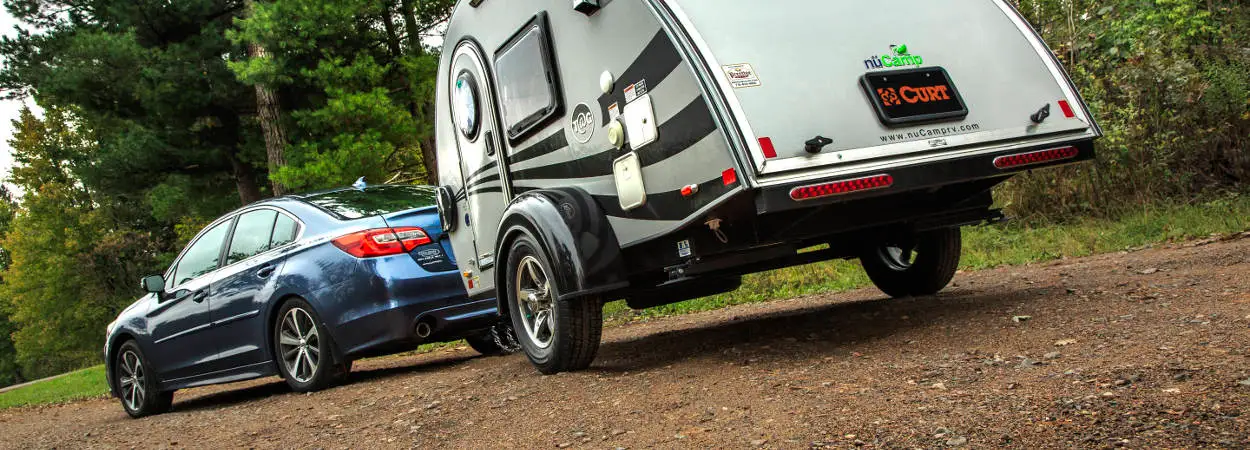
Towing a Trailer for the First Time
Perhaps you, like many drivers, are reluctant to tow a trailer. When towing a trailer for the first time, things may feel heavier, slower and unfamiliar behind the wheel. However, even though several aspects of your normal driving experience may change, trailering does not need to be stressful. In fact, with the proper know-how, towing can become as comfortable as normal driving.
Whether you're pulling a travel trailer for the first time or simply hitching up a cargo carrier, it is important to be prepared. This is hauling 101! Consider the following questions about your own specific towing situation.

1. What will you be towing?
First, you should know what kind of trailer you plan to tow. Will it be a utility trailer, boat trailer or maybe something heavier, such as a travel trailer? Knowing your trailer weight is essential for safe towing.
Based on your trailer type, will you need a receiver hitch or a heavy-duty 5th wheel or gooseneck hitch? Also does your trailer have its own set of brakes?
Learn more about hitch types here and trailer brakes and controllers here .
Be sure to think through all factors before towing any type of trailer.
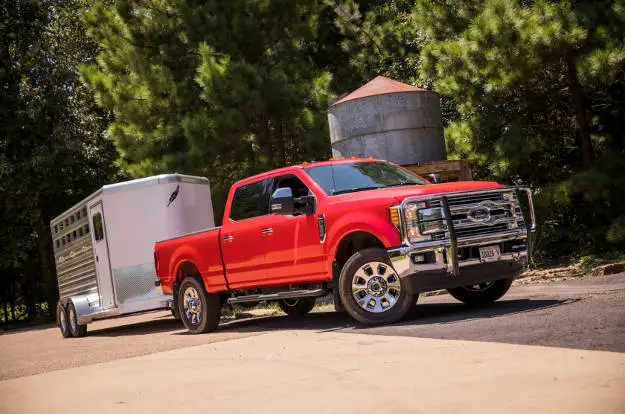
2. How will you be towing?
What kind of vehicle will you be driving? Will you be towing with a heavy-duty pickup truck or a small passenger car? Does your vehicle have a factory tow package or will you need to install your own towing equipment?
Each vehicle has different capacities, and each may require different equipment to tow safely and legally.
Learn more about installing a hitch here and towing capacity here .
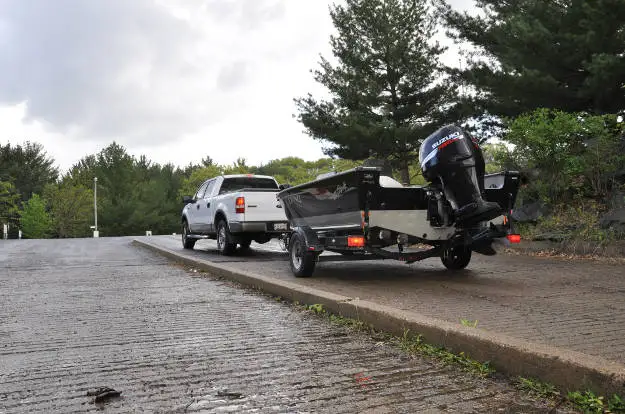
3. Where will you be towing?
Successfully towing a trailer also depends on the distance and road conditions along your route. For example, towing a utility trailer across town is one thing; towing a large 5th wheel trailer to a remote destination is something else.
It is likely that you will tow different trailers with the same vehicle. You will need to consider how best to equip yourself for these changes.
Learn more about different types of towing here.
Additional Towing Help
The information in Towing 101 will help answer all of the basic questions about towing a trailer. You can move through the guide one chapter at a time or jump directly to a specific topic of interest.
For help beyond the towing basics, please know that the CURT team is always here for you. You can send us a message or call our Product Support team any time during normal business hours!

Towing Specific Types of Trailers
How to tow a boat trailer.
Towing a boat trailer is very much like towing any other trailer. Boat trailers, even with a boat in tow, are relatively lightweight, unless you are towing a yacht or pontoon boat. Whatever the case, the same rules apply. Stay alert, be patient and drive carefully.
When towing a boat, it is important to secure the boat before travel. You may need to invest in the right hand winch to pull the boat onto the trailer. Also, make sure you drain water from the live wells and any other reservoir before driving away.
Need help launching?

How to tow a travel trailer
Towing a travel trailer has its challenges and advantages. Travel trailers are relatively larger trailers, and larger trailers can be easier to back up with.
However, large trailers create more wind resistance and usually weigh more. Make sure your vehicle is equipped with the right weight distribution hitch and sway control before towing.

How to tow a utility trailer
When towing a utility trailer, you will need to be conscious of your cargo. Follow the common-sense rules of hitching up correctly , driving carefully and being patient.
If you are towing an enclosed utility trailer, make sure items are secure even with the door shut, especially heavy cargo. If you have an open utility trailer, tie down all cargo with ratchet straps before travel.
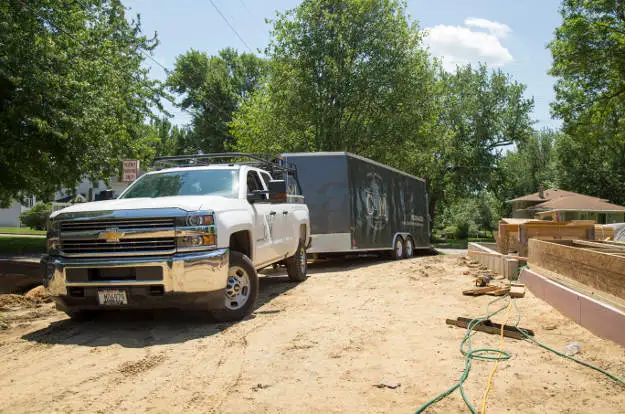
Not sure where to start? Look up your vehicle to find a custom hitch !
Towing 101 Table of Contents
Looking for more.
Discover more great tips and how-tos on the Lippert blog -- your destination for all things RVing, towing, boating and beyond!
- -->Home -->
- --> -->Request Brochure
- --> -->Build Yours
- --> -->Find a Dealer

Towing Guide
- Features & Options
- Build Yours

CALCULATING TOWED WEIGHT AND CARRYING CAPACITY
These are general guidelines to use when matching a trailer to your tow vehicle, assuming standard equipment on your trailer. Whether any travel trailer can be used with your vehicle and its capacities for carrying and/or towing is affected by how much optional equipment is added to the trailer, and the weight of passengers and all other items you carry in your tow vehicle and trailer. To get an approximate weight of the model of your choice equipped with the optional features you are considering, the "Build Yours" feature at lancecamper.com is a great resource. Because we're unfamiliar with your tow vehicle, Lance makes no warranties or representation expressed or implied – as to performance or reliability of your tow vehicle with a Lance trailer. For professional guidance, always consult with your Factory Authorized Lance Dealer. They're trained in calculating proper matches between tow vehicles and trailers.

Ex: If a trailer has an overall weight of 4k lbs. with 400 lbs. of hitch weight that would mean 3600 lbs. is on the axles and being towed. (4,000 – 400 = 3,600 or D . Towed Weight)
Ex. If the axle weight rating is 5200 (2600 each x 2) for this unit you will have 1600 lbs. of axle capacity for cargo. (5,200 – 3,600 = 1,600 or Cargo Capacity)
DISCLAIMER: These are general guidelines to use when matching a trailer to your tow vehicle. For more details, consult with a Lance Factory Authorized Dealer. Visit the "warranty" page for more information.

- Truck Campers
- Travel Trailers
- Find a Dealer
- Request Brochure
- Build a Lance
- Dealer Inventory
- Discover Lance
Copyright © All Rights Reserved by Lance Camper Mfg. Corp.
We use cookies to ensure you get the best experience on our website.

This post may contain affiliate links or mention our own products, please check out our disclosure policy .
Guide to Travel Trailer Towing
Published on October 27th, 2022 by Dave Helgeson This post was updated on January 12th, 2023
New to pulling an RV? You need to read this guide to travel trailer towing.
Learn why RV towing isn’t as simple as hooking a travel trailer to the rear bumper of a tow vehicle and heading down the road.
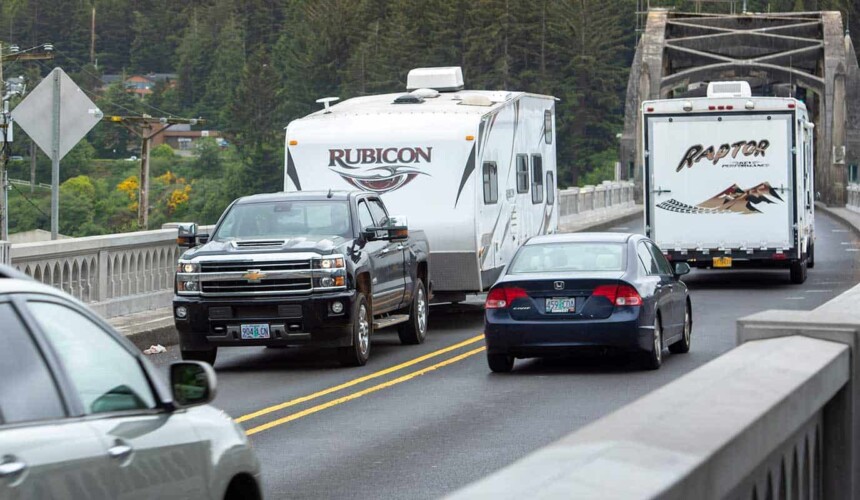
Your Guide to Travel Trailer Towing: Where to Start
Proper travel trailer towing requires the right equipment, preparation, knowledge, and experience. Voluminous books have been written detailing all you need to know. Here are the basics to get you started.
DON’T MISS OUT ON LET'S RV UPDATES
Sign up for the newsletter today.
Please enter a valid email address.
An error occurred. Please try again later.

Thank you for subscribing to the Let's RV newsletter, keep your eye on your inbox for updates.
Know your equipment:.
- Make sure your tow vehicle is rated to pull the weight of the trailer, batteries, potable water, propane, personal gear, passengers, and anything else you plan to carry with you.
- Obtain the proper equipment to tow the travel trailer. This includes a receiver for your tow vehicle, most likely an equalizing hitch, brake control and possibly a sway control. You might also need tow mirrors to see around the trailer while towing.
- Know the cargo carrying capacity of the travel trailer (think axles and tire ratings). Never exceed the rating. Exceeding the limit could void the manufactures warranty or worse. This leaves you personally responsible for injuries to others if involved in an accident deemed your fault.
- Know, check, and maintain the recommended tire pressure of your tow vehicle and trailer. Tire failure while going down the highway can spell the end to your RV trip.
- Understand how to use your tow vehicles transmission to your advantage. If you have a “tow mode”, understand what it does and how to use it. Understand engine RPMs and manually shift gears to maximize performance. Check the manufacturers recommendations for using cruise control when towing and abide by them.
Travel Trailer Towing – Practice!
Take your travel trailer someplace close to home that has a large vacant parking lot and practice trailer towing. Practice hitching and unhitching the travel trailer. This includes making sure the coupler is latched, safety chains are attached, equalizing bars are properly adjusted, brakes and turn signals are working, marker lights and brake lights work.
Now practice backing up. Pay attention to how the trailer follows the tow vehicle. Make mental notes on how much the trailer “cuts the corner” and how much the “tail” swings when turning.
Here’s a steering tip for RV trailer newbies:
- Place one hand at the bottom of the steering wheel when backing a trailer.
- If you want the back end of the trailer to go right, move your hand on the steering wheel to the right.
- If you want the back end of the trailer to go left, move your hand on the steering wheel to the left.
To avoid confusion, have a helper refer to which way they want the back end of the trailer to move. For example, it could be verbal instructions such as “Back end my way!” Or, they can use hand signals.
A large vacant lot is also a great place to adjust the brake control.
Check your trailer brakes before departing home, camp or descending steep grades. Review your trailer brake control manual for manufacturer recommendations specific to your unit.
- Gently apply power to the trailer brakes manually via the brake control in your tow vehicle. You should feel the trailer give a “tug” on the tow vehicle. This tug lets you know the trailer brakes are activating.
- If you don’t feel a tug, you have a brake problem that needs attention before hitting the road and especially before descending a steep grade. Often a “wiggle and push” of the 7-way plug between the tow vehicle and trailer will resolve the problem.
Travel Trailer Towing – On the road:
- Allow plenty of distance between you and the vehicle in front of you. This provides you more time to react and brake when something unexpected happens in front of you.
- Look for large gaps between vehicles when merging or changing lanes that will accept the length of your rig. If someone is tailgating, it is best to move over and let them go past. On two lane highways be aware how many vehicles are stacking up behind you (five or more is typically over the legal limit). Find somewhere to safely pull off, allowing them to pass.
- Shift to a lower gear when descending a steep extended grade. Downshifting allows the compression of the engine to keep your speed under control rather than your brakes. Extended braking on long downgrades can lead to overheating of your vehicle and trailer brakes resulting in brake failure.
- If the engine coolant rises significantly, try shifting down a gear to keep your engine from bogging. Turn off the air conditioner. Consider using the old timer’s trick of rolling down the windows and turning the cab heat on high.
- Is the transmission jumping between gears (aka “searching”)? Manually shift the transmission into the lower of the two gears to avoid overheating the transmission.
- When in doubt on any overheating issues, pull over and let things cool down.

Understand travel trailer towing sway.
You will experience sway when towing a trailer. Knowing what causes trailer sway, how to avoid and how to deal with it are very important for a safe and pleasant experience.
Sway from outside sources include side winds and passing large vehicles like semi-trucks and trailers. Trailer sway can also be introduced by improper loading of personal items in the trailer resulting in too light of tongue weight.
This video clearly demonstrates how violent sway can occur if not enough weight is kept forward of the axles.
What to do if you are experiencing travel trailer sway
When being pushed around by side winds, there is not much you can do other than slow down.
- Does travel trailer sway happen when passing or being passed by a large vehicle? Move over in your lane as far as possible from the passing vehicle. Maximize the air space between the two of you. A larger air space will minimize the effect of being sucked in towards the other vehicle.
- Is your trailer “pushing” you down a hill and causing sway? Take your foot off the gas. Slowly apply the trailer brakes manually via the brake control to eliminate the sway. Learn more about trailer sway here .
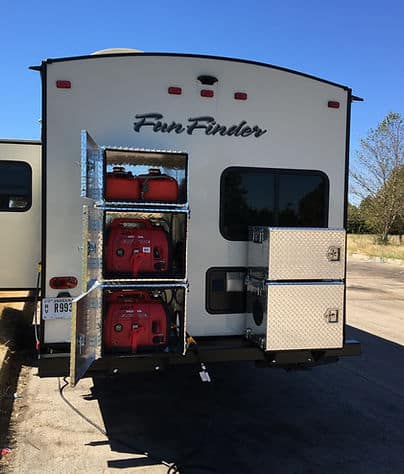
With travel trailer sway under control, accelerate and stop gradually. Don’t be in a rush when travel trailer towing. After all, RVing should be leisurely. Starting and stopping suddenly is hard on your tow vehicle and trailer, wears components out faster, decreases fuel economy and keeps things from shifting in the trailer.
Hopefully this short guide to trailer towing will provide you the needed information to confidentially hitch up your travel trailer and hit the road. Just remember to take it slow and enjoy the journey because that is what RVing is all about.
Share this post:
Related posts:.
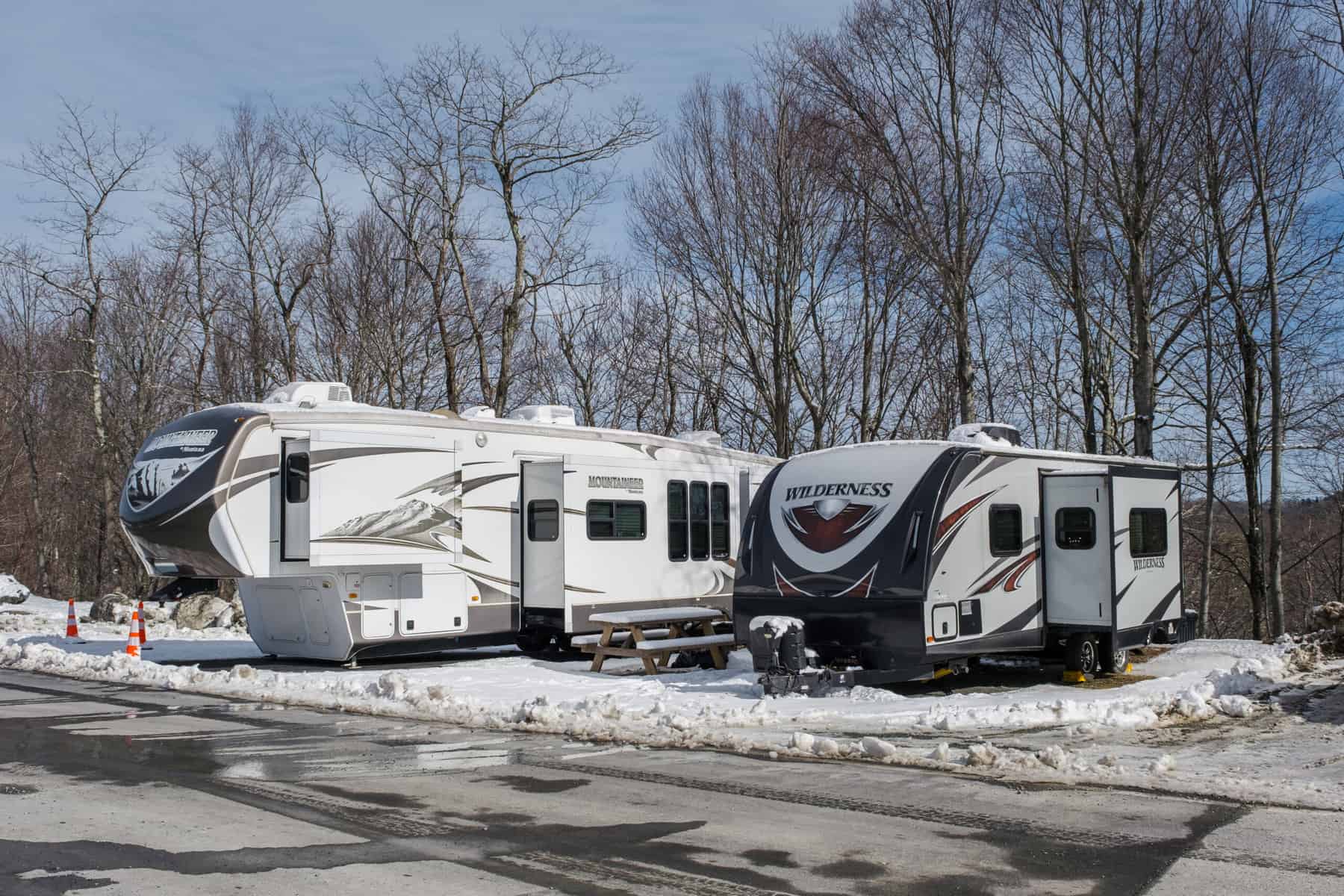
The Truth About Four Season Travel Trailers
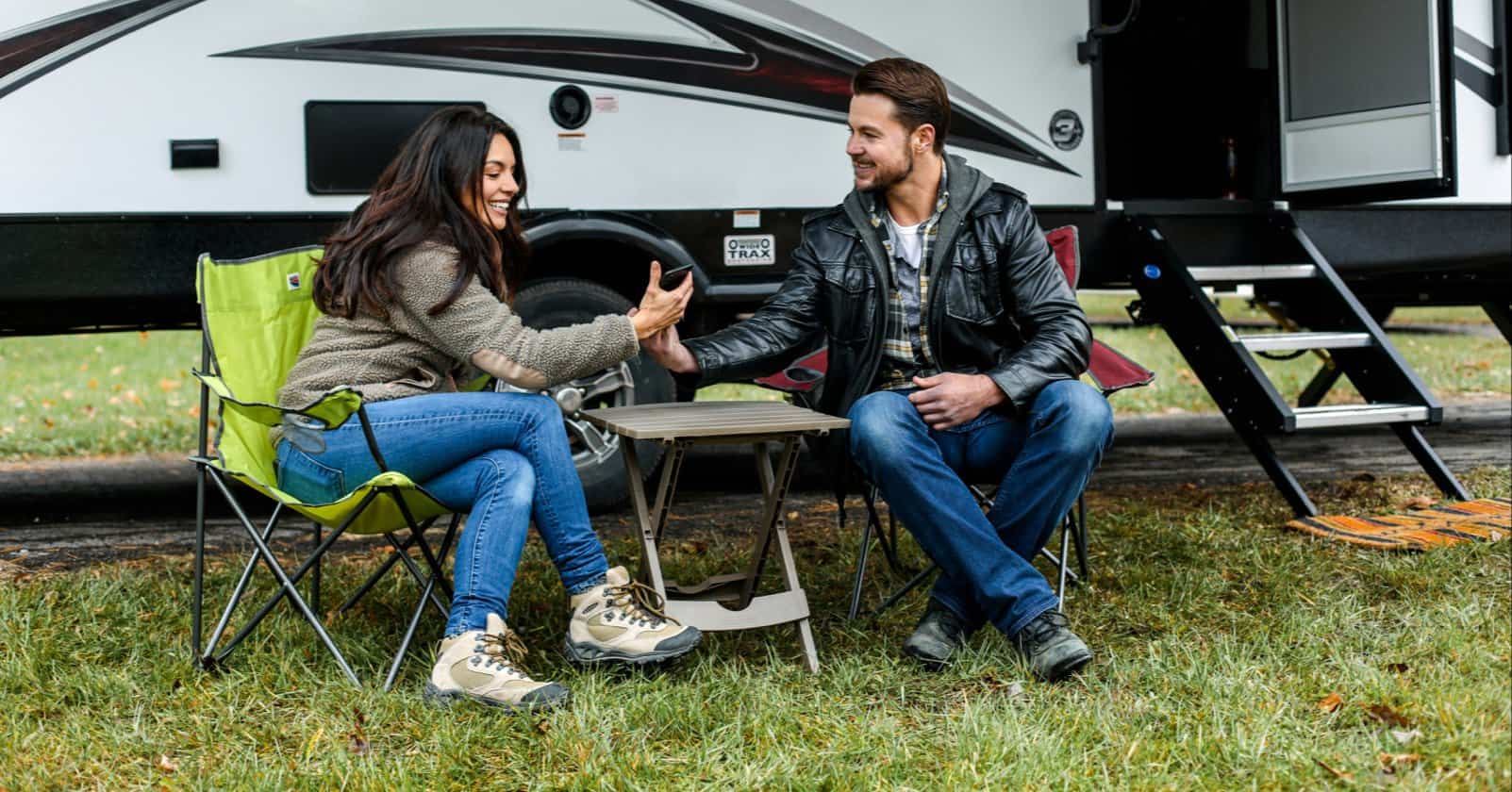
Our Top Lightweight Travel Trailers with Full Bathrooms in 2024
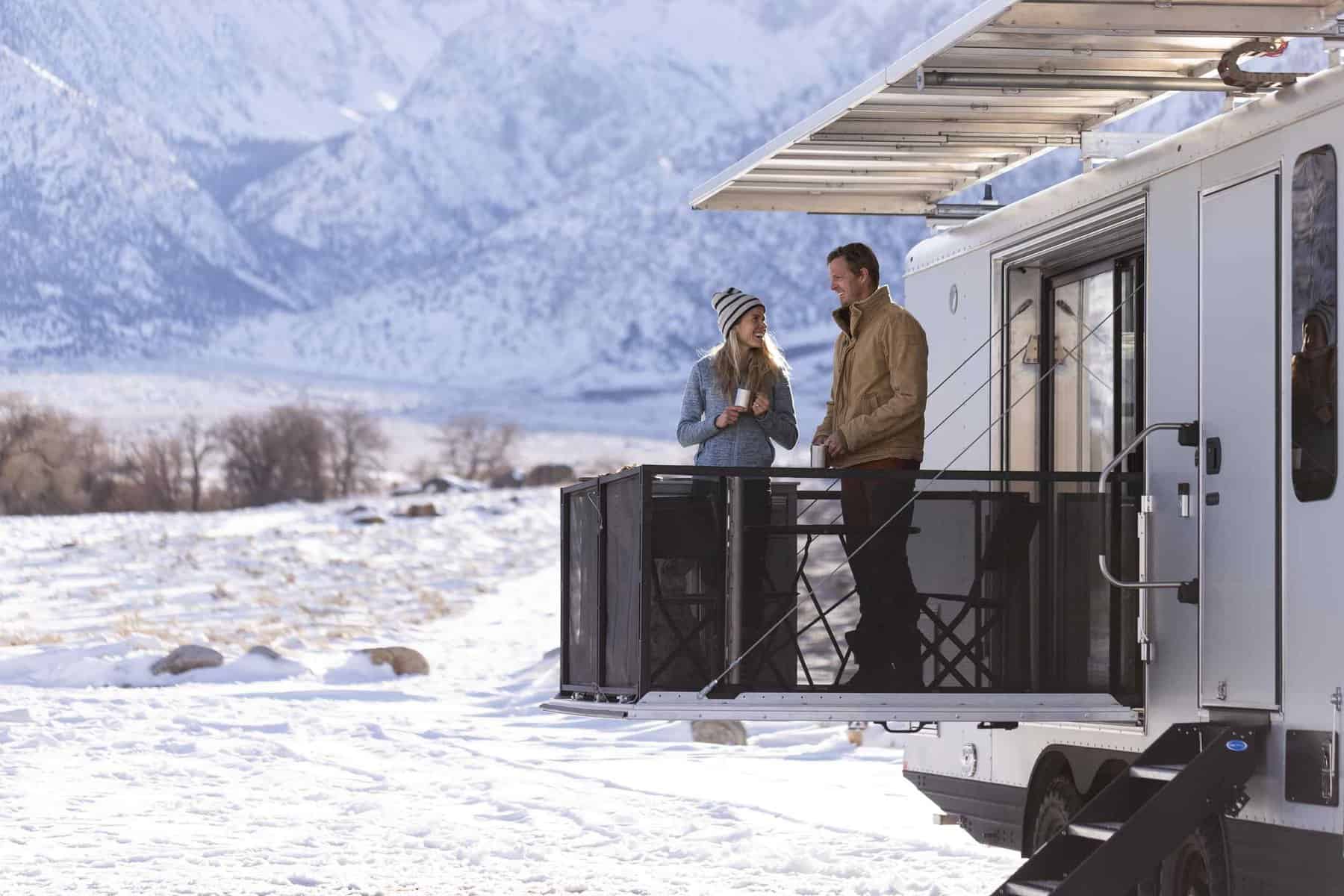
2024’s Best Small Camping Trailers
About the author:.

Dave Helgeson’s knowledge about RVing earned him the title of “ The foremost expert on boondocking ,” bestowed by RV industry icon, the late Gary Bunzer ( The RV Doctor ). He and his wife Cheri owned an RV dealership in the Pacific Northwest and spent 29 years overseeing regional RV shows. Dave has also served as advisor to many industry trade organizations. When he’s not out boondocking, you’ll find Dave in the spotlight at RV shows across the country, giving seminars about all things RVing. He and Cheri currently own their fifth travel trailer, with Dave doing all the service, repair and modifications to his own unit.
Follow Let's RV
What’s the Best Truck for Towing a Travel Trailer or Fifth Wheel?
Everything you need to know about truck size, towing capacity, engine types, drivetrain, payload, and more.
By Johann Schnell
If you’re considering buying a travel trailer or fifth wheel, you’ll need a truck with towing capabilities. There are plenty of trucks to choose from, and each brand and model will be different.
Choosing the proper tow vehicle can feel overwhelming. This guide will break down each step of the process when trying to find the right truck to tow your rig.
In this article:
- Truck Brands
- Truck Towing Capacity and Payload
The Best Trucks for Towing 2020
Where to compare trucks for towing.
- Tow Vehicle Features to Consider
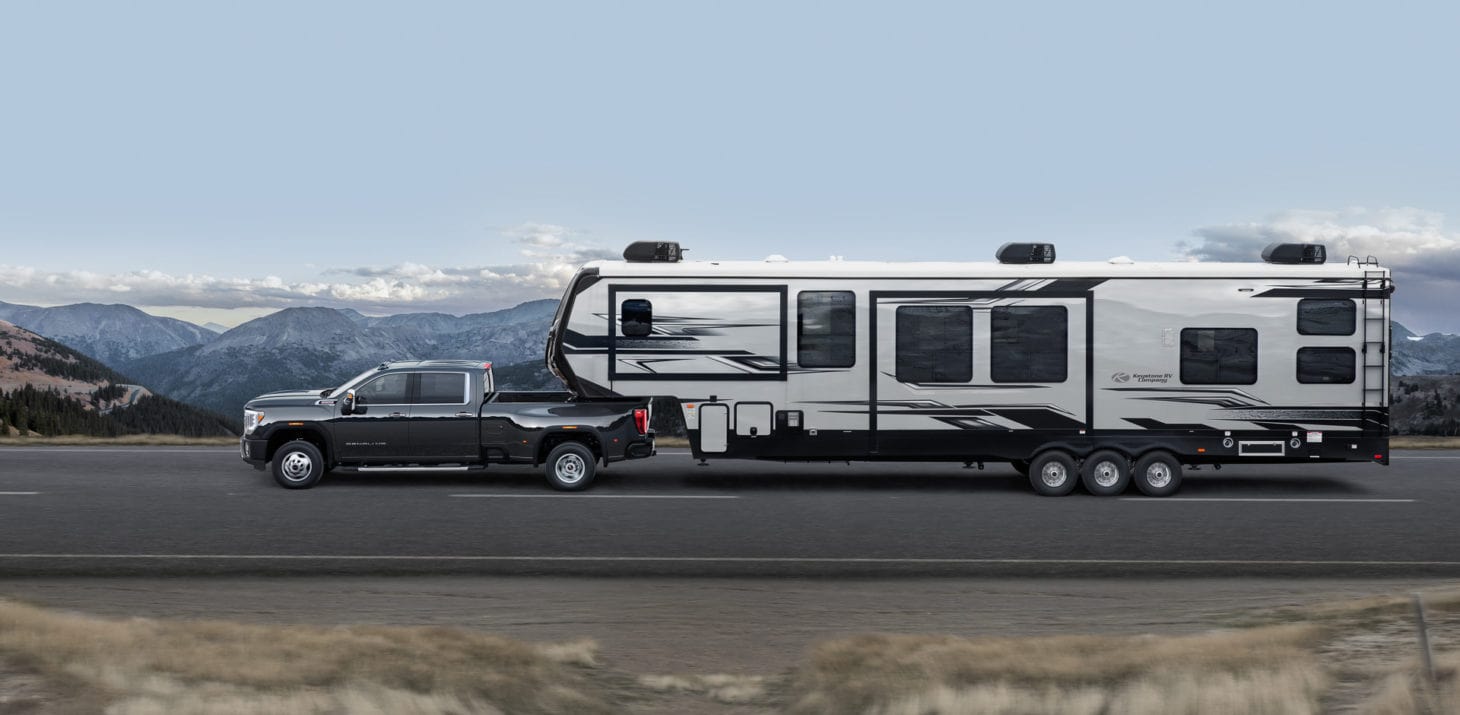
Truck Brands
It’s best to keep an open mind when it comes to choosing your tow vehicle. Try to put any automaker brand loyalty aside, since limiting your truck options can affect the type of trailer you are able to tow.
Automaker quality changes over time and manufacturers constantly develop new features, like towing safety technologies. Manufacturers build vehicles with the same chassis, drivetrain, and design for approximately 4 to 7 years, a period typically known as a generation. When you hear that “the new-gen Tundra is coming out in 2021,” that means it will be on a whole new platform and the truck will be completely overhauled. From year to year and within the same generation, manufacturers will also make minor updates to bumpers, grilles, headlights, and other features to make the same truck slightly new and improved.
If you love the current generation of the truck you are eyeing, look to see how far into the cycle it is. If there’s a new generation coming out next year, the current one will be discounted. Or, the truck you love could be a model from the prior generation and there may be major improvements coming out soon with the new generation.
Truck manufacturers don’t all change generations at the same time. For example, Ford updated the generation of the “F” series trucks in 2016 and it’s the current generation manufactured today. RAM was next to come out with its new generation in 2018, and GM followed in 2019 with the current Silverado/Sierra. This allows for increased competition and to keep truck models fresh to consumers. So, if you’re a fan of Ford trucks, know that Ford will most likely overhaul its trucks in a few years, before RAM and GM.
If you are open to any brand, then you can shop around for the right combination of cost and features to find the perfect truck within your budget.
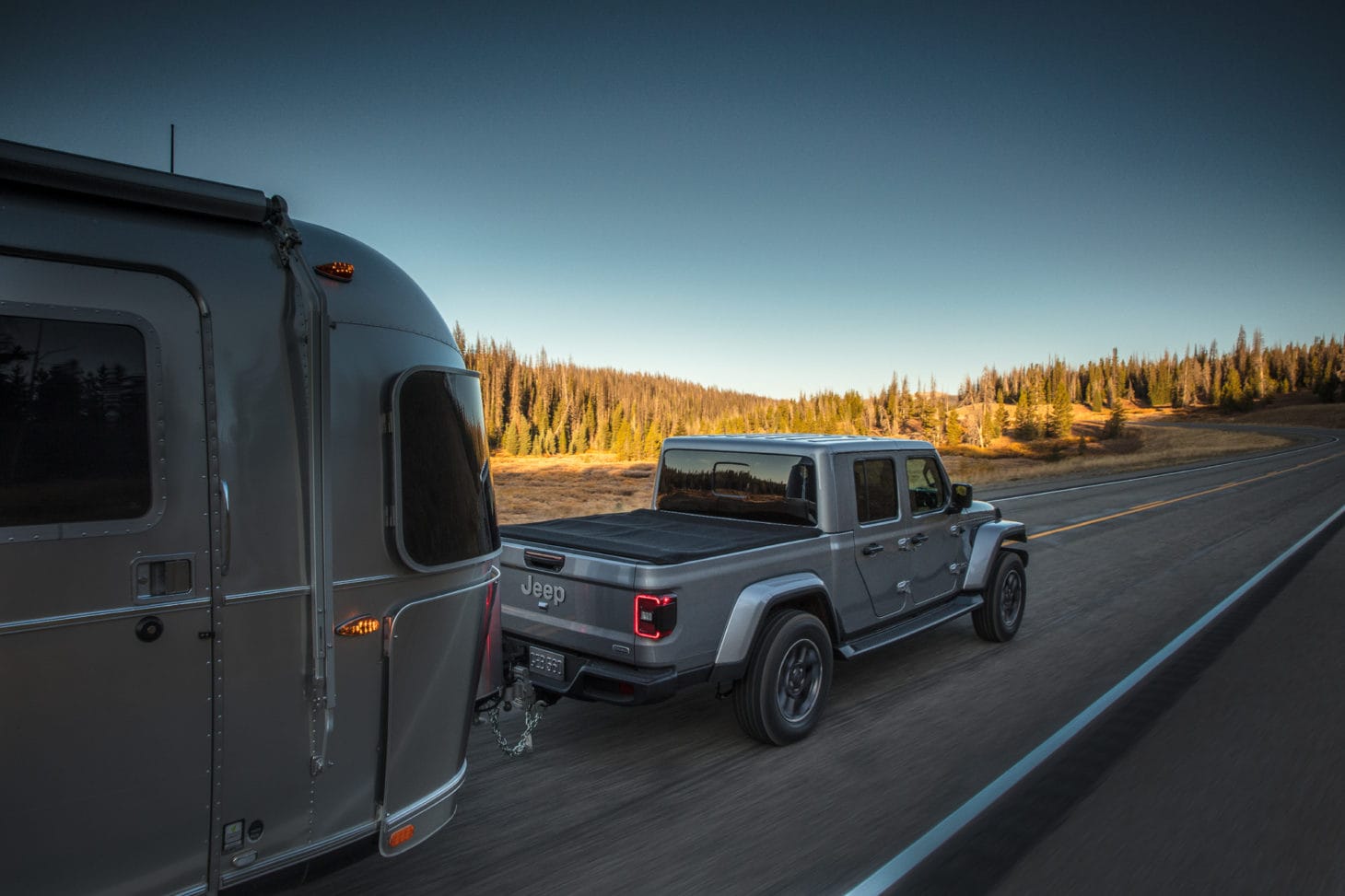
The Importance of Truck Towing Capacity and Payload
Towing capacity is perhaps the most important consideration when choosing your towing vehicle. However, it can be confusing to compare truck models. Automakers compete in torque and toughness, all trying to offer greater towing capacity without crushing the fuel economy.
Just because an automaker claims to be “Best in Class,” that doesn’t necessarily mean it’s the right fit for you—or that the truck you’re looking at is able to live up to the hype. Within the same model of truck, there is a wide range of towing capabilities.
The most capable version of a truck is often the one with fewer luxury options. Generally, a heavier truck with additional upgrades will have a reduced ability to carry cargo. If you opt for these things, they will typically reduce your truck’s towing numbers. For example, off-road suspension—which can be found in Chevy’s Trailboss, RAM’s Rebel, and Ford’s Raptor—is softer and doesn’t handle heavy payloads as well. Luxury features such as leather, sun/panoramic roofs, and bigger cabs all add weight to the standard truck version, meaning less payload capacity.
Engine options also impact towing capacity. A smaller engine means better fuel economy, but it will have less towing capacity than larger engines.
While tow capacity rankings change from year to year, it’s important to spend some time comparing the towing capacity of different truck models. Automakers including Ford, RAM, General Motors, Toyota, and Nissan adopted a uniform method for testing and rating the towing capacity of their pickup trucks, beginning with their 2015 models, which makes it easier to compare them.
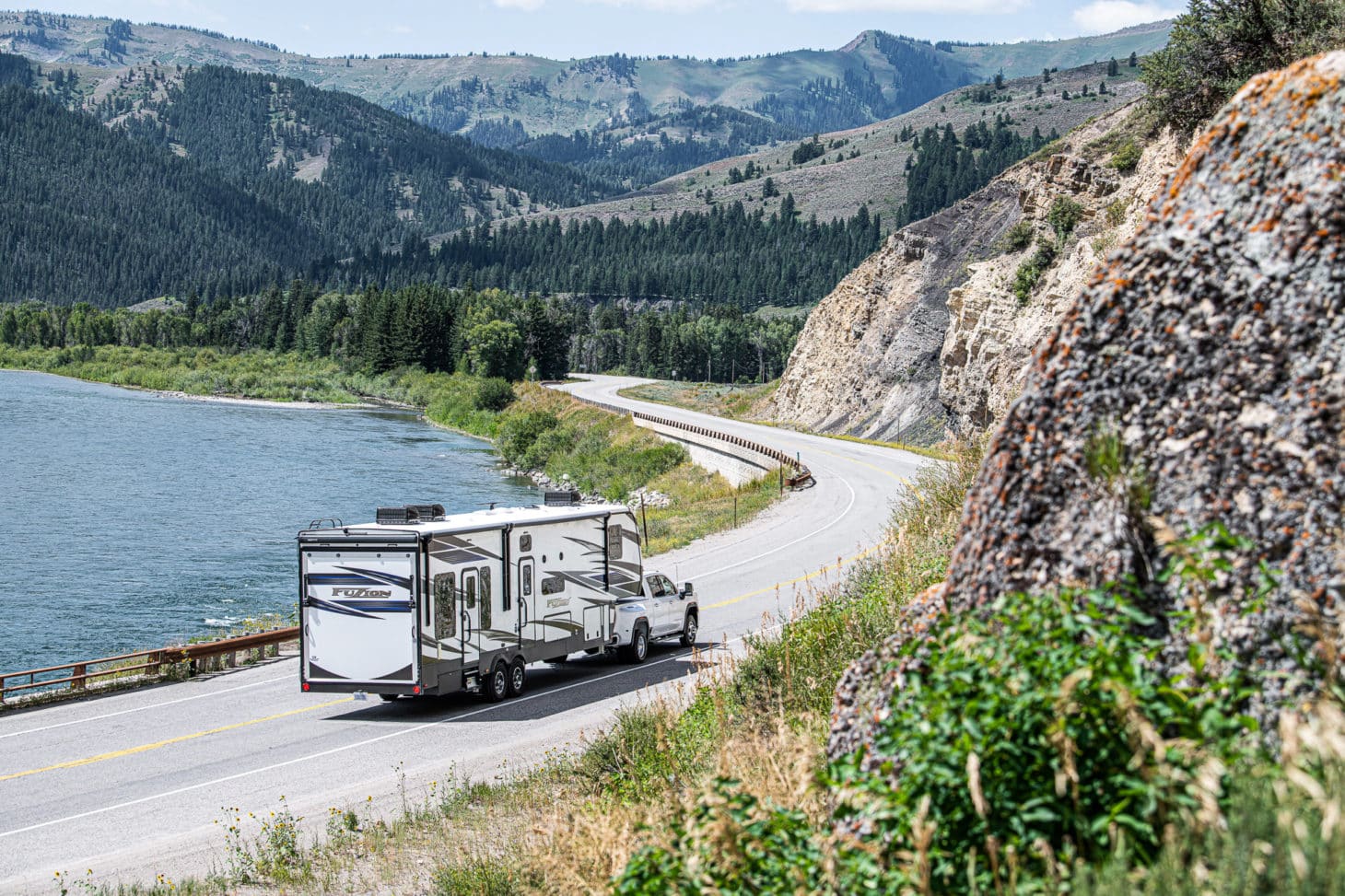
Once you have a few trucks in mind, the best way to understand the specific truck’s towing capacity is to look at the driver’s side door jamb sticker. This contains tire information and payload capacity for the truck—arguably the most important number for towing. At the dealership, look at a different trim level of that same truck and you’ll see how the payload varies.
Whichever truck you pick, your towing vehicle must have a towing capacity higher than the trailer’s GVWR. Keep in mind that weight added to your towing vehicle, such as passengers and cargo, increases your GVW and factors into your vehicle’s GVWR. Head to a truck scale to get an accurate measurement of your GVW and then compare that to your GVWR.
It’s extremely important to understand payload capacity, which is the amount that the truck can hold in terms of cargo. This includes you and your family’s weight, any other passengers (including pets), gear in the cab and bed of the truck, and the weight of the hitch. It’s very common for people to go over payload without realizing it when it comes to RV towing because RVs typically have more tongue weight than boats and other types of trailers.
When a truck is carrying too much payload, the rear suspension isn’t level. This is called sag and can be very dangerous. The nose of the truck will be higher and the steering will feel light. If the truck can’t handle the RV’s tongue weight properly, then the RV will also be unlevel with the nose down. Towing safety is incredibly important as overloading your trailer or vehicle can cause a crash.
Considerations When Towing a Fifth Wheel
Since fifth wheels are usually much heavier than comparable trailers, make sure your towing vehicle can support the hitch weight and the tow weight of a fifth wheel. If you’re towing a fifth wheel, you’ll likely need a truck with a more payload and a higher towing capacity than if you have a bumper pull or more traditional travel trailer.
When shopping for a truck to pull a fifth wheel, it’s recommended to look for one that comes with fifth wheel prep from the factory as this means it will also come with other options that are optimized for towing a camper. If there’s a specific truck that meets your taste and has the capacities to tow your camper, there are aftermarket options for models that aren’t prepped for the fifth wheel to hook up to the bed of the truck.
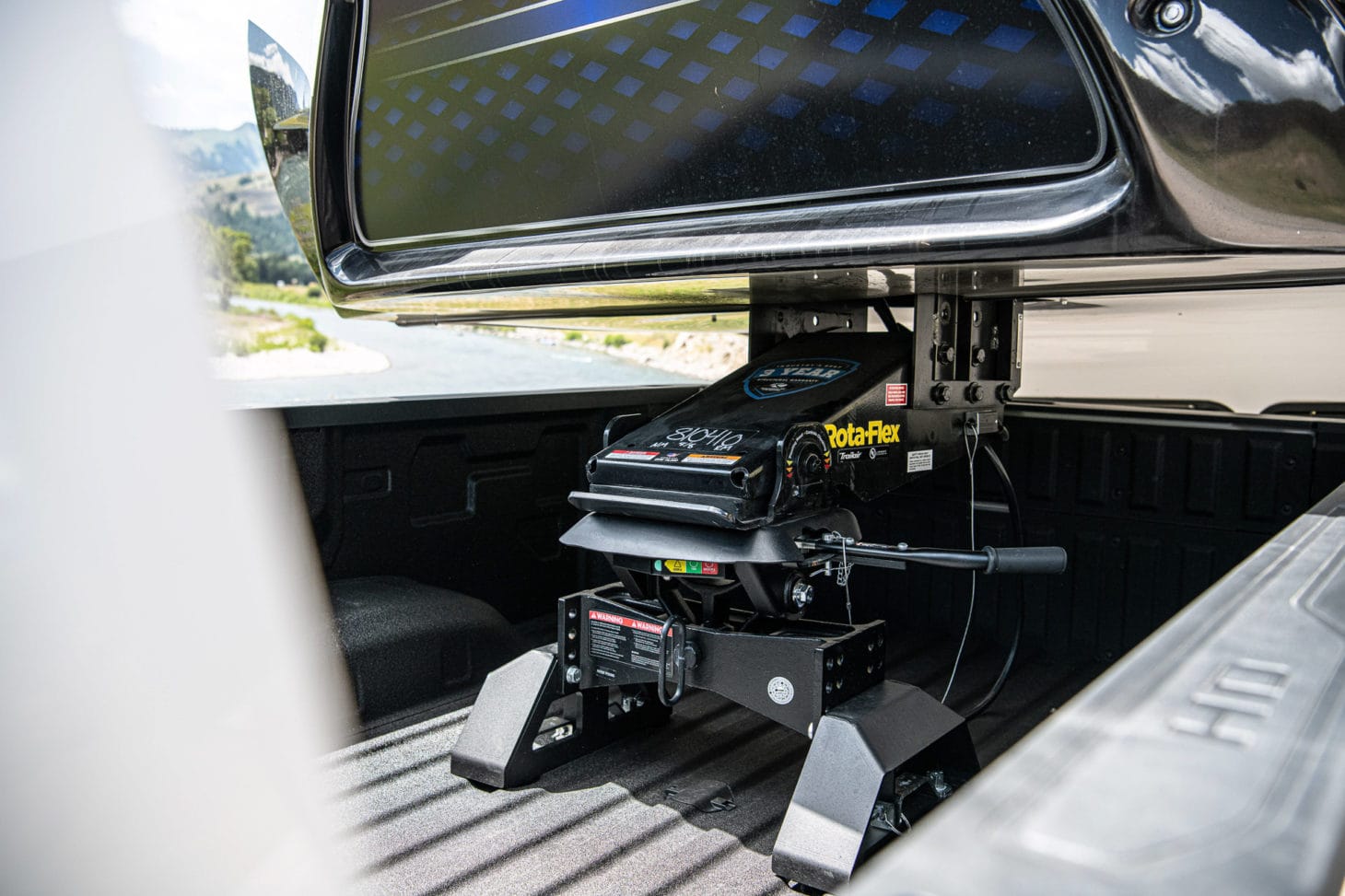
The truck’s payload also plays an important role in a fifth wheel combination because it has high weights that are transferred to the truck. This is why some people find the need to go from a three-quarter-ton truck to a one-ton—for example, if you have a RAM 2500 HD truck, but the fifth wheel’s pin weight, plus passengers, exceed 3,000 pounds. The average RAM 2500 payload maxes out around 3,000 pounds, but the average RAM 3500 can handle 4,000 pounds.
Towing a trailer or fifth wheel takes raw power, a transmission that’s built to distribute that power, a cooling system to keep everything from melting, brakes to be able to stop it, and axles and suspension to support the weight.
It’s crucial to carefully check the specifications of a truck. Why? The engine, gearing, length, cab style, bed style, axles, and towing packages all affect the truck’s towing capacity. While a properly configured RAM 3500 can tow upwards of 30,000 pounds, that capacity drops to about 11,000 pounds without the right features and options.
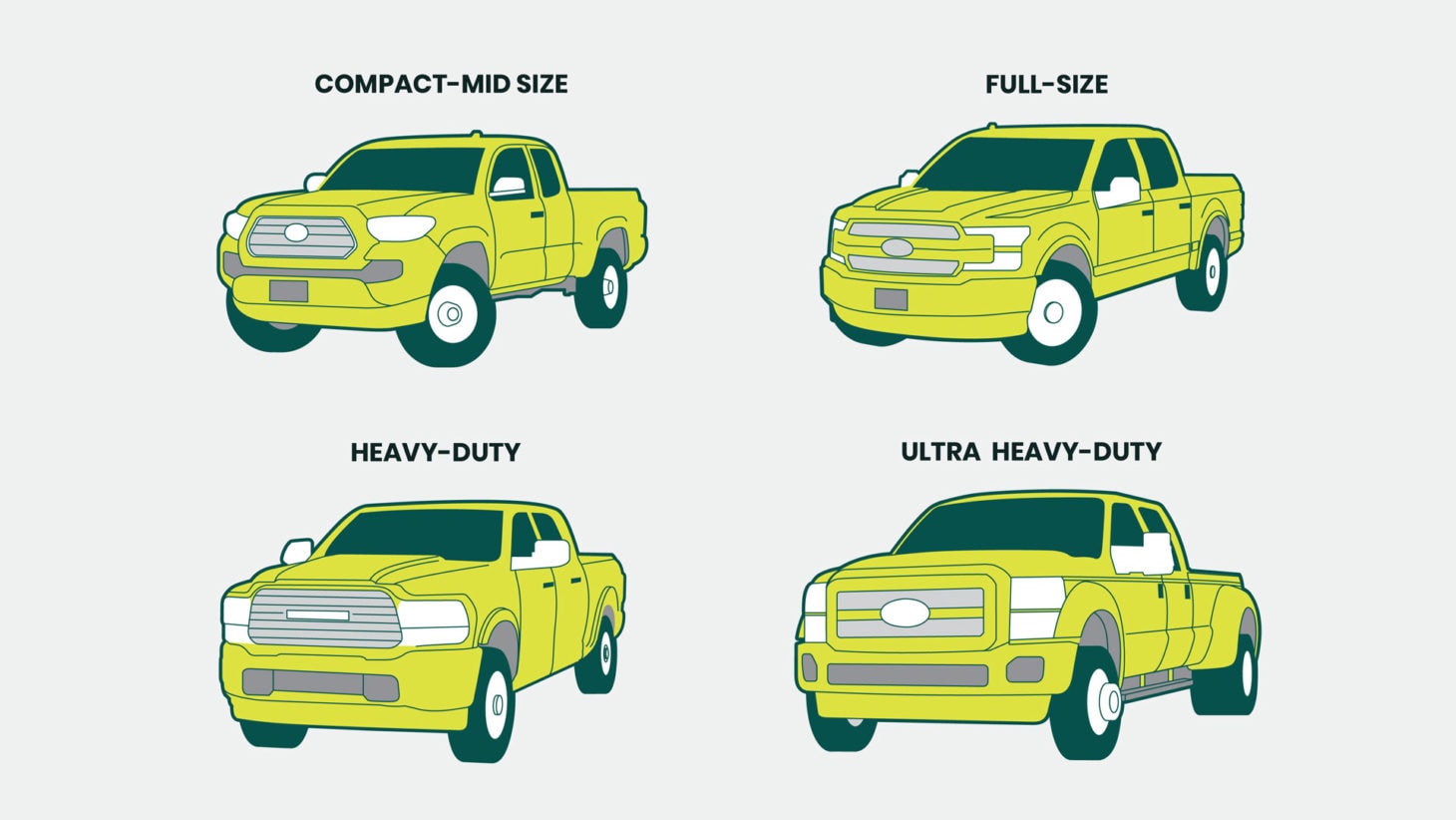
Here are the 2020 trucks available in the U.S. ranked by towing capacity in their respective segments.
Note: Keep in mind that base payload numbers listed are from a standard truck. The realistic payload may be slightly lower depending on additional features and options that add weight and reduce payload capacity.
Mid-Size/Compact Trucks
Weekend warriors love compact trucks. They’re great for hauling small campers, boats, and motorcycles with maximum towing capacities ranging from 5,000 to 7,700 pounds.
Honda Ridgeline
- Base towing capacity: 3,500
- Max. towing capacity: 5,000
- Base payload: 1,452
- Max. payload: 1,499
Nissan Frontier
- Base towing capacity: 3,760
- Max. towing capacity: 6,710
- Base payload: 1,020
- Max. payload: 1,460
Toyota Tacoma
- Max. towing capacity: 6,800
- Base payload: 1,155
- Max. payload: 1,620
Ford Ranger
- Max. towing capacity: 7,500
- Base payload: 1,560
- Max. payload: 1,860
Chevrolet Colorado / GMC Canyon
- Max. towing capacity: 7,700
- Base payload: 1,190
- Max. payload: 1,550
Jeep Gladiator
- Base towing capacity: 4,000
- Max. towing capacity: 7,650
- Base payload: 1,150
- Max. payload: 1,600
Full-Size Trucks
Full-size trucks, or half-ton trucks, are also popular. These rugged pickups are designed with plenty of torque for pulling power. Maximum towing capacities in this segment range from 9,740 to 13,200 pounds.
Nissan Titan
- Base towing capacity: 9,210
- Max. towing capacity: 9,370
- Base payload: 1,580
- Max. payload: 1,680
Toyota Tundra
- Base towing capacity: 9,200
- Max. towing capacity: 10,200
- Max. payload: 1,730
Chevrolet Silverado / GMC Sierra 1500
- Base towing capacity: 6,800
- Max. towing capacity: 13,400
- Base payload: 1,600
- Max. payload: 2,110
- Base towing capacity: 6,390
- Max. towing capacity: 12,750
- Base payload: 1,200
- Max. payload: 2,300
- Base towing capacity: 7,700
- Max. towing capacity: 13,200
- Base payload: 1,990
- Max. payload: 3,270
Heavy-Duty Trucks
Heavy-duty trucks are also referred to as three-quarter-ton trucks. If you own a large fifth wheel trailer or a long travel trailer, you should consider this category of trucks. They come with gooseneck and fifth-wheel hitch options that place your load directly over the axle for greater towing capacities in this segment. The added weight of the truck will also help reduce sway and provide a safer towing experience.
Nissan Titan XD
- Max. towing capacity, conventional: 10,880
- Max. towing capacity, fifth wheel: 11,040
- Max. payload: 2,240
- Max. towing capacity, conventional: 10,580
- Max. towing capacity, fifth wheel: 19,680
- Base payload: 1,620
- Max. payload: 4,010
Chevrolet Silverado / GMC Sierra 2500
- Max. towing capacity, conventional: 20,000
- Max. towing capacity, fifth wheel: 31,180
- Base payload: 2,047
- Max. payload: 6,610
Ford Super Duty F-250
- Max. towing capacity, conventional: 18,200
- Max. towing capacity, fifth wheel: 22,800
- Base payload: 3,040
- Max. payload: 4,160
Ultra-Duty Trucks
Ultra-duty trucks are the heroes of hauling. If you own an extra-large fifth wheel, you will probably need one of these. Their maximum towing capacity ranges from 20,000 to 32,000 pounds. While powerful, they probably won’t ride as well as lighter trucks.
Ultra-duty trucks come equipped with either single rear wheels (SRW) or dual rear wheels (DRW), also known as dually trucks. If you’re comparing the two, it’s helpful to know that single rear wheel trucks have less payload capacity, but dually trucks cost more to buy and require higher maintenance due to the extra tires. Dually trucks are wider and harder to live with as an everyday driver but handle the RV better, offering more stability on the road
Note: The highest payload and towing capacity numbers listed below are for the DRW versions of these trucks.
- Max. towing capacity, conventional: 18,000
- Max. towing capacity, fifth wheel: 35,100
- Base payload: 4,110
- Max. payload: 7,680
Chevrolet Silverado / GMC Sierra 3500
- Max. towing capacity, fifth wheel: 35,500
- Base payload: 4,013
- Max. payload: 7,442
Ford Super Duty F-350
- Max. towing capacity, conventional: 21,200
- Max. towing capacity, fifth wheel: 35,750
- Base payload: 2,990
- Max. payload: 7,850
For more brand-specific towing information, check out these links:
- Ford RV Trailer and Towing Guide
- GMC Trailering and Towing Guide
- Chevy Trucks Trailering and Towing Guide
- RAM Trucks Towing and Payload Capacity Guide
- Nissan Titan Towing
- 2019 Honda Ridgeline Specs
- 2019 Toyota Tacoma Towing Specs
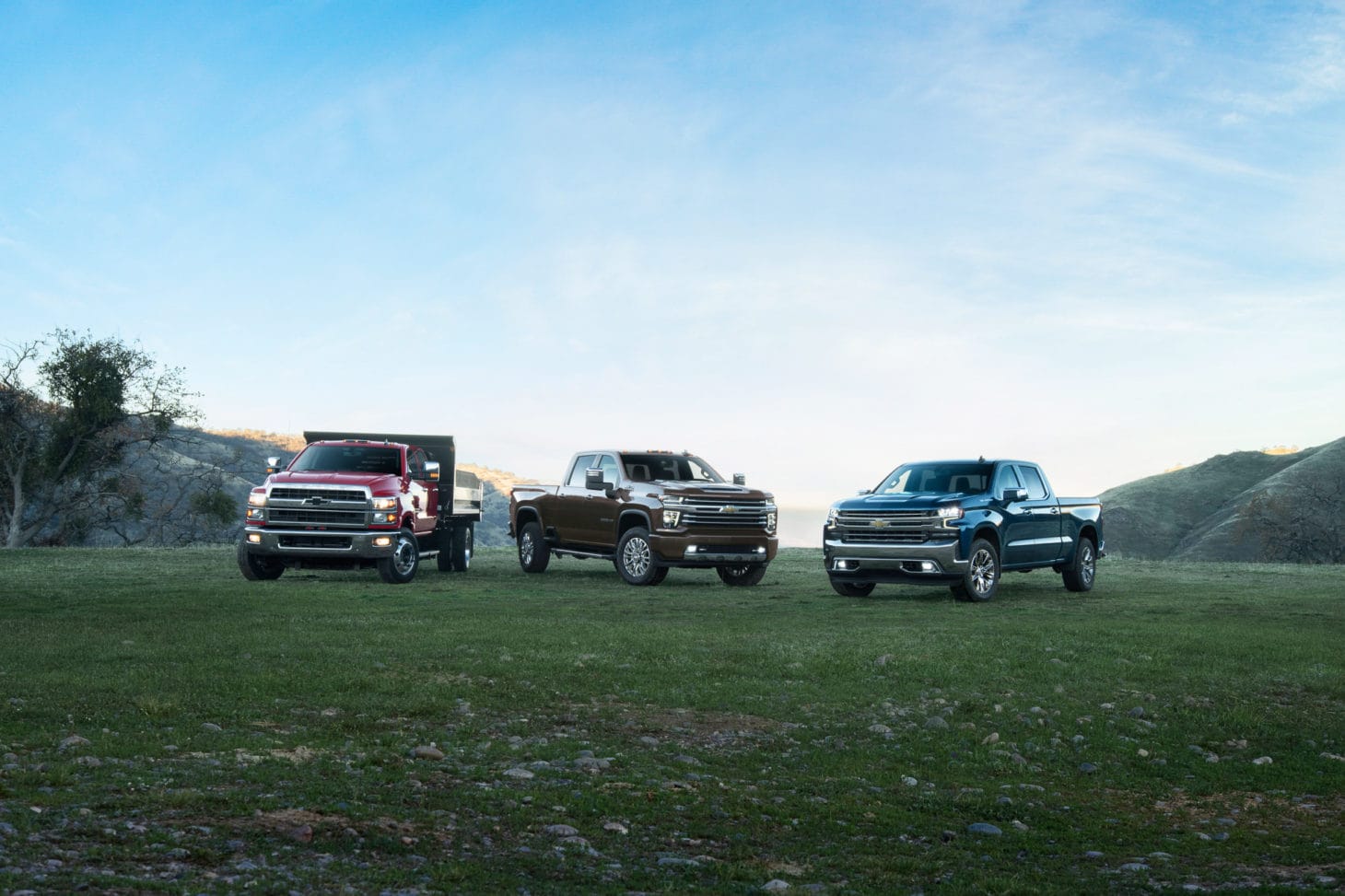
Features to Consider When Purchasing a Truck for Towing
Gas vs. diesel engines .
Diesel engines are great for towing because they give you low-end torque. That’s why they’re so popular with commercial towing businesses. Diesel engines provide a useful combination of everyday driving fuel economy with torque capability for pulling an RV. These engines have similar pulling characteristics to a larger V8 but get better fuel economy and range.
In prior years, diesel engines were limited to heavy-duty trucks, but now you can find lightweight trucks with high-performance diesel engines. There’s also been an increase in mid-size and full-size trucks offering small turbo diesel engines in models like the Chevrolet Colorado / GMC Canyon, Jeep Gladiator, Ford F-150, GM 1500 Silverado and Sierra, and RAM 1500.
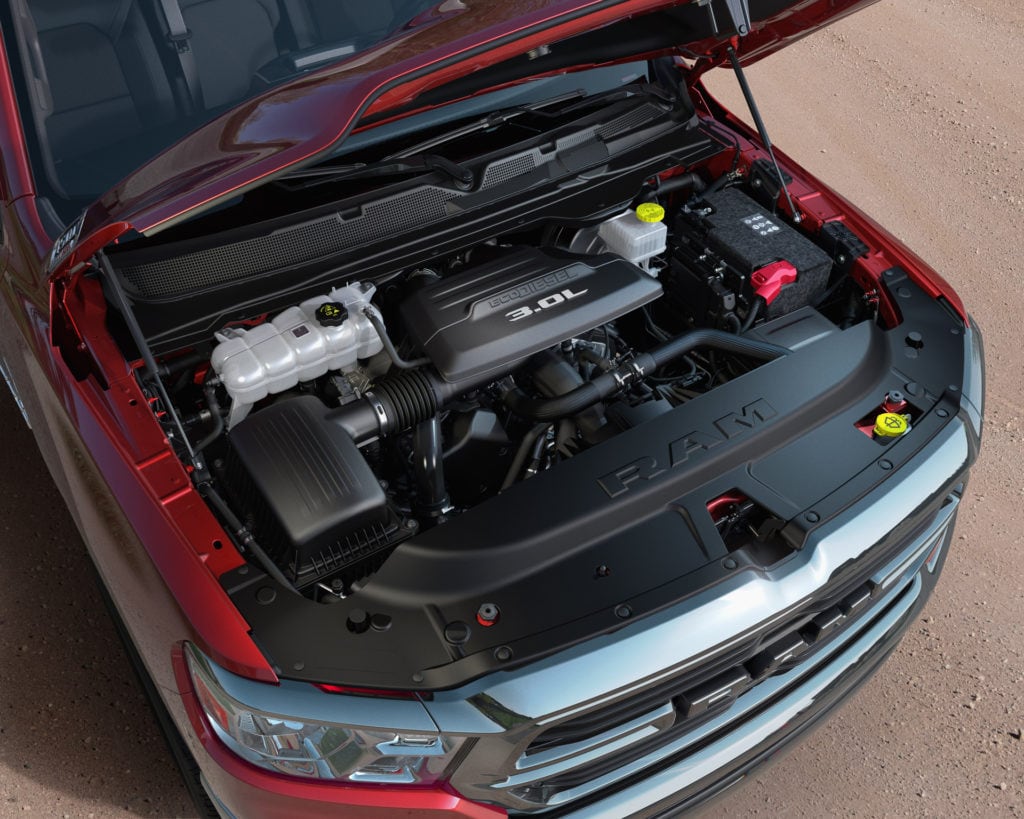
While diesel engines have their benefits, they can add thousands of dollars to the purchase price. For example, you can get the 2020 Chevrolet Colorado (base price $21,300) with a Duramax 2.8L turbo-diesel engine that gives you a 7,700-pound towing capacity. However, the engine upgrade will cost you nearly $4,000.
In the full-size category, a small diesel engine is a premium option. For example, in the Chevrolet Silverado, the small diesel Duramax is $3,670 more than the biggest V8 offered and $6,600 more than the base engine. In the Ford F-150, the small Power Stroke Diesel is also the most expensive option with a $4,000 premium over the base engine.
Pros of a Diesel Truck:
- Higher towing capacity and better towing experience
- Safer descending when towing because the diesel engine has an engine brake feature to help the regular brake system not overheat
- Better fuel economy and range when towing
- Designed for a higher number of operating miles
- Higher resale value in the used market
- More torque makes the truck fun to drive
Cons of a Diesel Truck
- Limited to fuel stations or pumps with diesel gas
- Diesel Exhaust Fluid (DEF) also needs to be filled
- Higher cost of diesel at the pump
- Service and repair costs are higher
- Diesel engine option costs more
- The diesel engine weighs more and reduces payload capacity
Consider how often you’re going to tow your RV. While diesel engines can tow more and may have better fuel economy, you might be better off with a gas engine if you aren’t towing very often.
Four-Wheel Drive
You’ll also want to consider if you need four-wheel drive, or if two-wheel drive will suffice. Nearly all pickups are based on rear-wheel drive platforms, which are designed to move heavy loads.
Traditional four-wheel drive (often called 4×4 or 4WD) is a part-time system that you turn on with a rotary switch, button, or lever when you need it. You can also select a low-range setting for challenging off-road conditions.
Full-time four-wheel drive is more versatile and is optional on some pickups. It kicks in as needed to enhance your traction, and your truck can run indefinitely in that mode without harming the drivetrain.
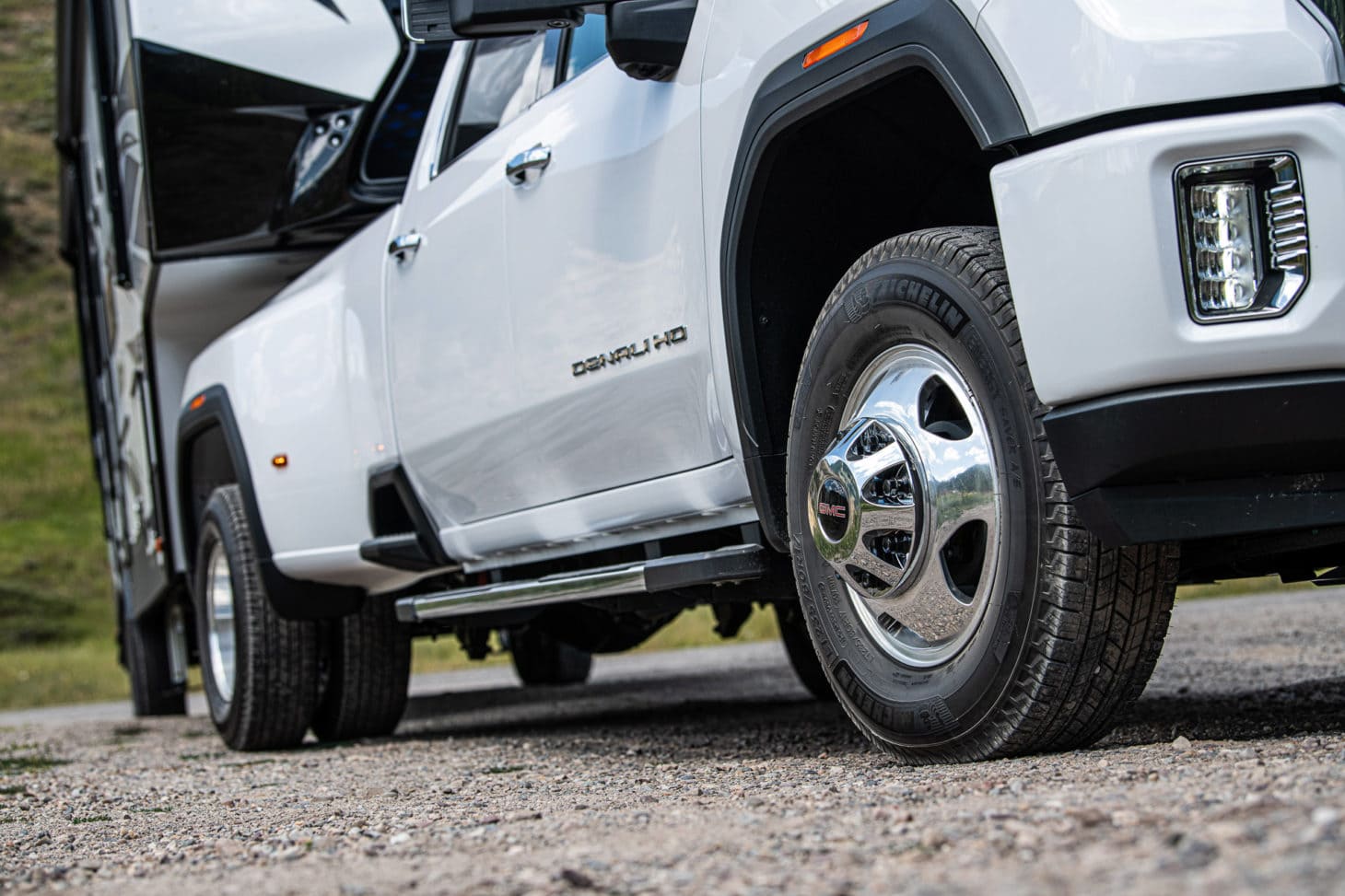
Here’s the trade-off: Four-wheel drive vehicles are typically a bit heavier because of the weight of the four-wheel drive components. They also usually have a slightly lower towing rating and less fuel efficiency than the same vehicle with two-wheel drive.
Here are some high-performance truck models that have four-wheel drive but less payload and towing capacity because the suspension is softer, designed for trails and sand capability:
- Ford Raptor to the F-150
- Chevrolet Silverado Trailboss / GMC Sierra AT4
- RAM Rebel and TRX to the RAM 1500
- Toyota TRD Pro trims on the Tundra and Tacoma
- Jeep Gladiator Rubicon and Mojave to the regular Sport with Max Tow
- Chevrolet Colorado ZR2 trim level
If you’re planning to tackle tough terrain, go off-roading, or travel in the winter, you might need the extra grip of four-wheel drive. You don’t want to get stuck on soft ground or a hill with loose gravel wishing you’d gone with the more aggressive powertrain.
When looking for a pickup, you need to consider the three different types of cabs: regular cab (two-door), extended cab (three-door), or crew cab (four-door).
Regular two-door cabs offer some advantages: They’re typically less expensive and are shorter and lighter, giving you an increase in payload. But if you need room for more passengers, consider the extended and crew cabs.
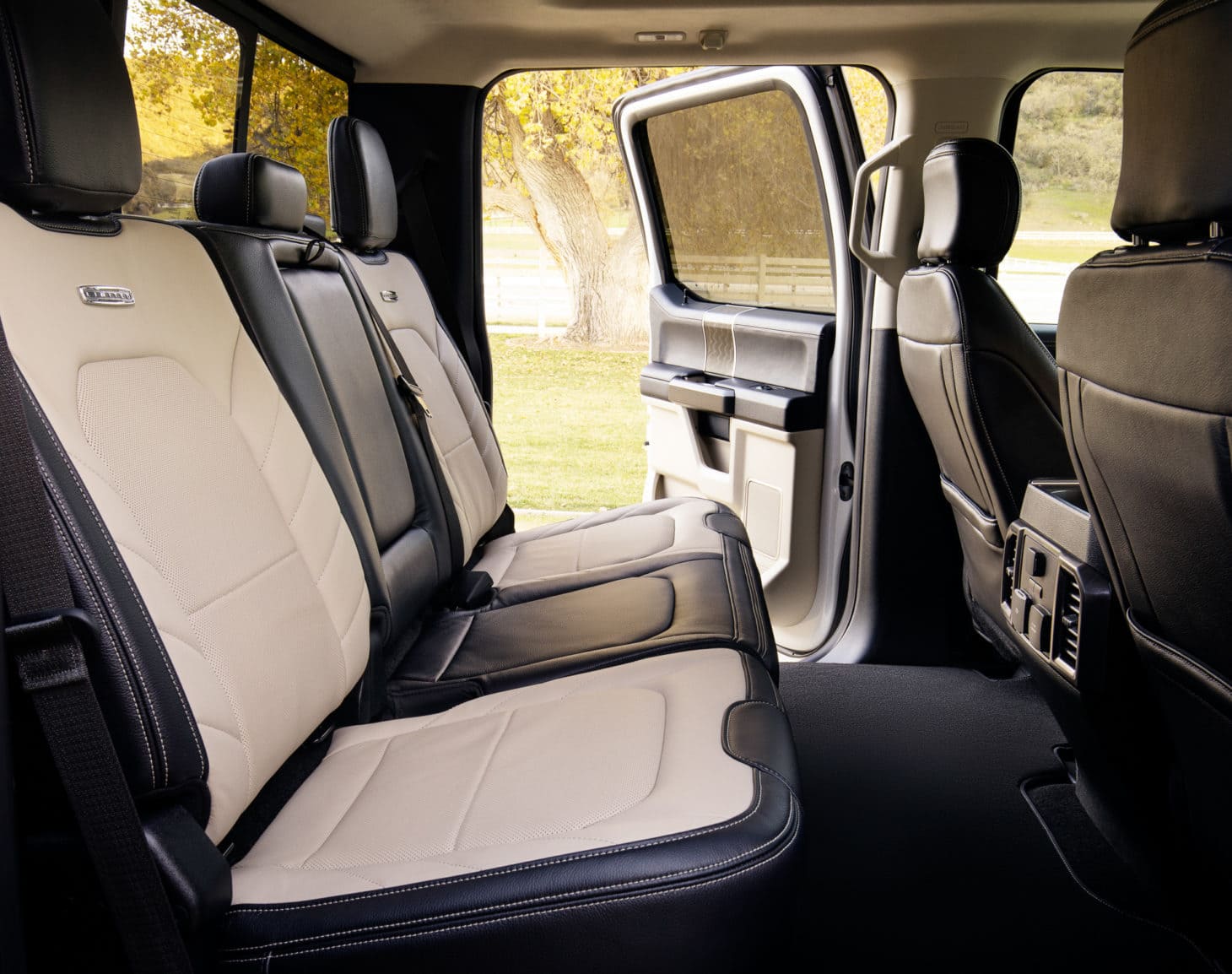
Extended cabs give you additional interior storage. The rear seats may make adults feel cramped but are typically comfortable enough for kids.
Crew cabs with four regular doors give you ample room for seating or cargo, similar to full-sized SUVs. However, these large cabs usually come at the expense of a smaller cargo bed and the least amount of payload versus the other cabs.
Here’s another truck decision you’ll need to make: long- or short-bed pickup? If you choose a short-bed pickup, it will be easier to drive and park when you’re not towing. Parking your trailer at the campground should be easier, too. However, a shorter bed truck also means a shorter wheelbase (the space between the front and rear wheels). The longer the wheelbase of the truck, the better it will be at holding trailer sway steady when towing.
Long-bed trucks will give you more space—and more options. Long bed trucks are also more in demand, so they typically command a higher resale price.
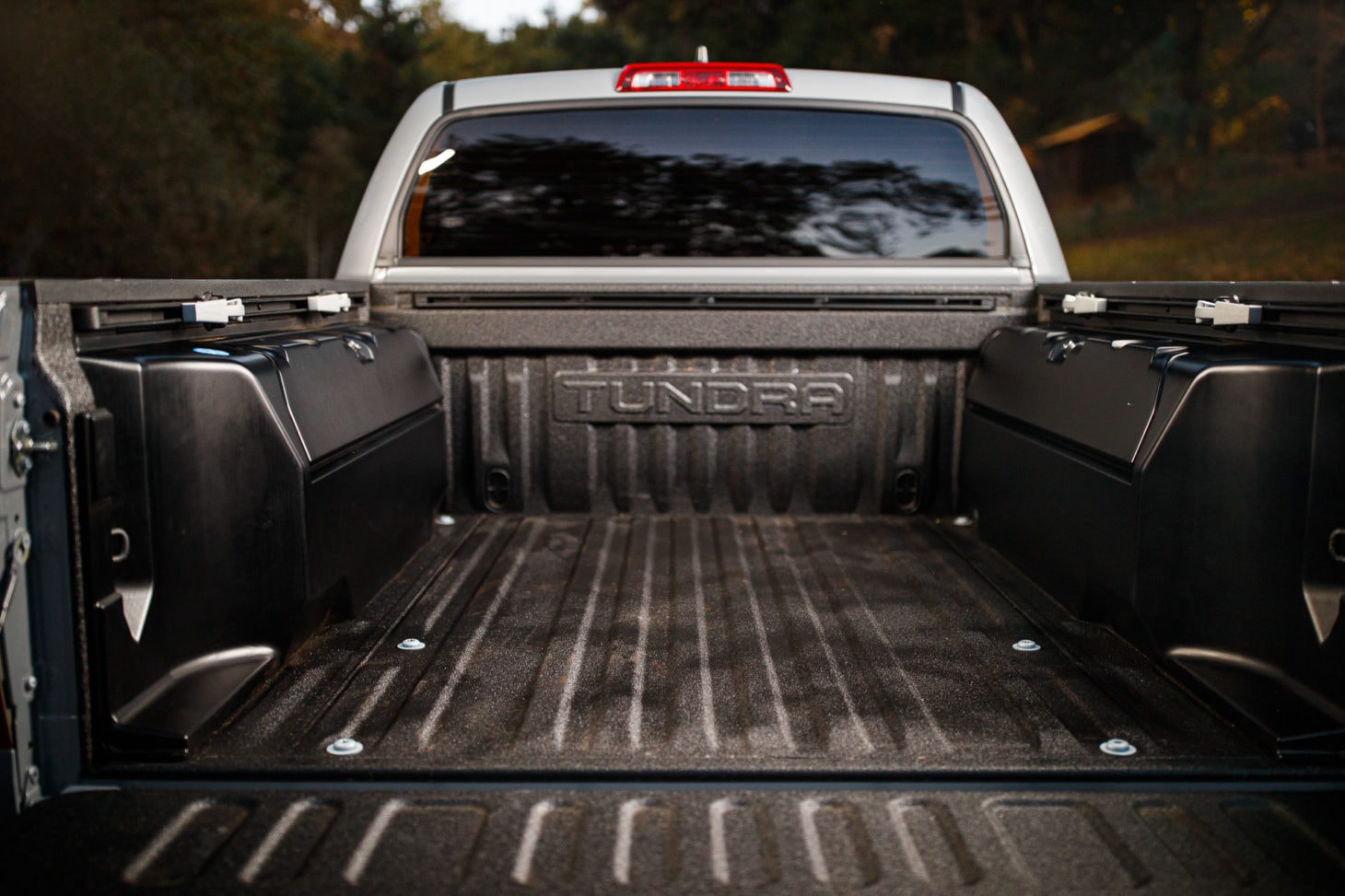
The standard cargo bed length is 8 feet for a full-sized pickup, 6 feet for an extended cab, and 5 feet for a crew cab. Cargo beds for compact pickups usually range from 5 to 6 feet. Fold-out bed extenders are widely available as well. These extenders flip over from within the bed, fencing off the open tailgate to allow you to secure bulkier or longer cargo.
If you are towing a fifth wheel, short beds are not recommended. Since the hitch is inside the bed, a longer bed will keep the fifth wheel further away from the cab. People do tow fifth wheels with short beds, but you’ll typically find that the trailer is making contact with the rear cab’s window with this setup. It can also be a close call when backing up as the corner of the fifth wheel swings.
Additional Features
Automakers continue to add advanced safety technologies to their lineups, including electronic braking, stability control, traction control, tire pressure monitoring (TPM), lane departure warnings, and crash avoidance.
Most trucks now come standard with apps on their infotainment system, but there are some dedicated towing features built in to the infotainment system on most trucks in the full-size and up category. The infotainment system will be the starting point for some of the features we highlight below and there is a range in options and technologies depending on the manufacturer.
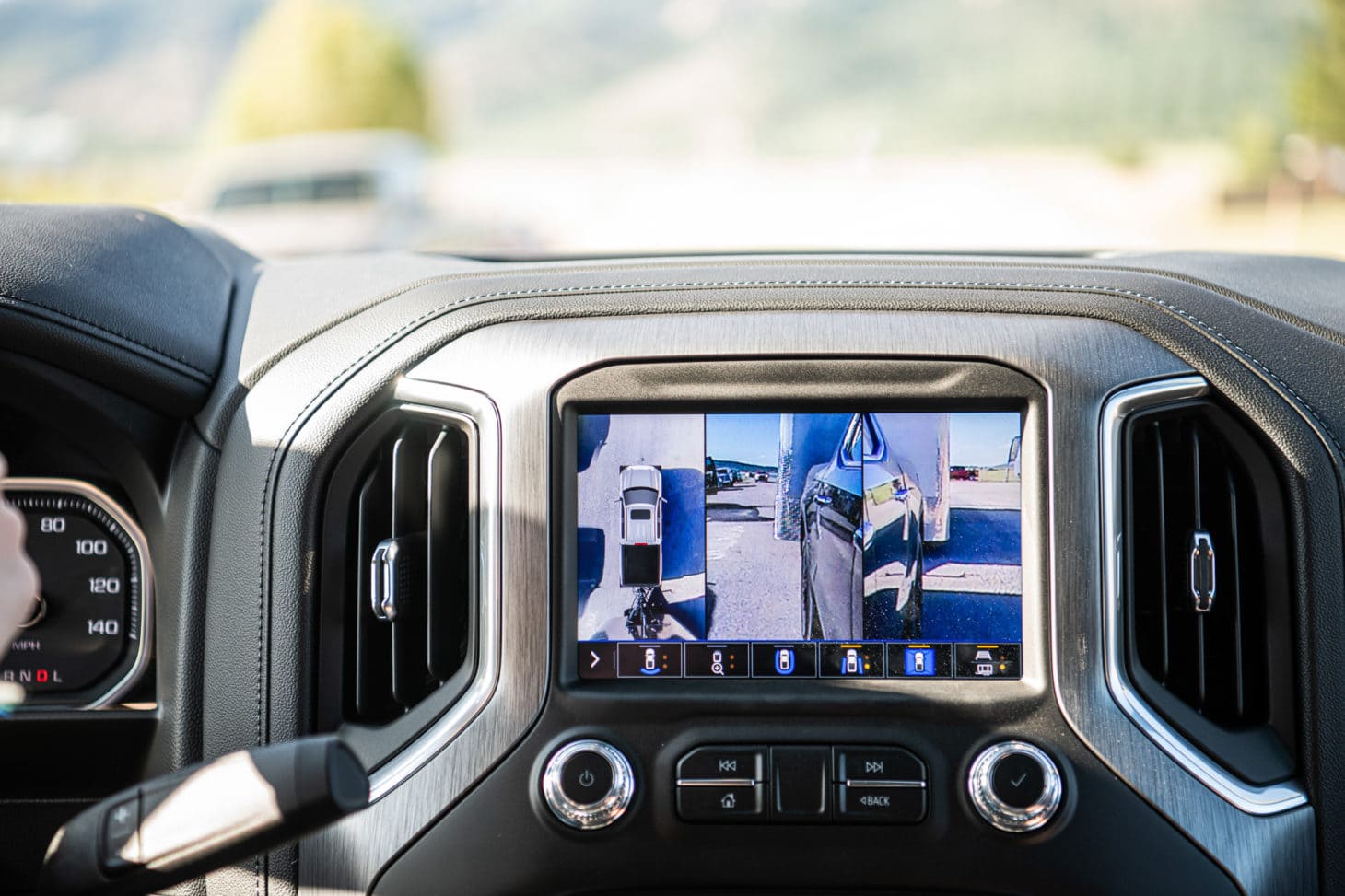
GM is a leader in 2020, with an infotainment system that allows RV owners to connect their truck to a few RV command systems and monitor and control RV features from inside the truck. GM’s infotainment system also provides a checklist of common steps needed to tow a trailer safely.
Some of these features come standard and others are optional, so you’ll want to do some research to decide what’s necessary for your rig.
Trailer Brake Controller
Most trucks that come with a towing option will also come with a trailer brake controller included. This system applies the brakes to the camper when the driver uses the brakes on the truck. This allows both the camper and the truck to each use their own brakes to slow down or stop safely.
Blind Spot Monitoring
This feature alerts the driver when another vehicle is in its blind spot. Most vehicles come with this feature standard, as part of a package of safety features. Now some trucks also have the capability to alert the driver when there is a vehicle in the blind spot of the camper.
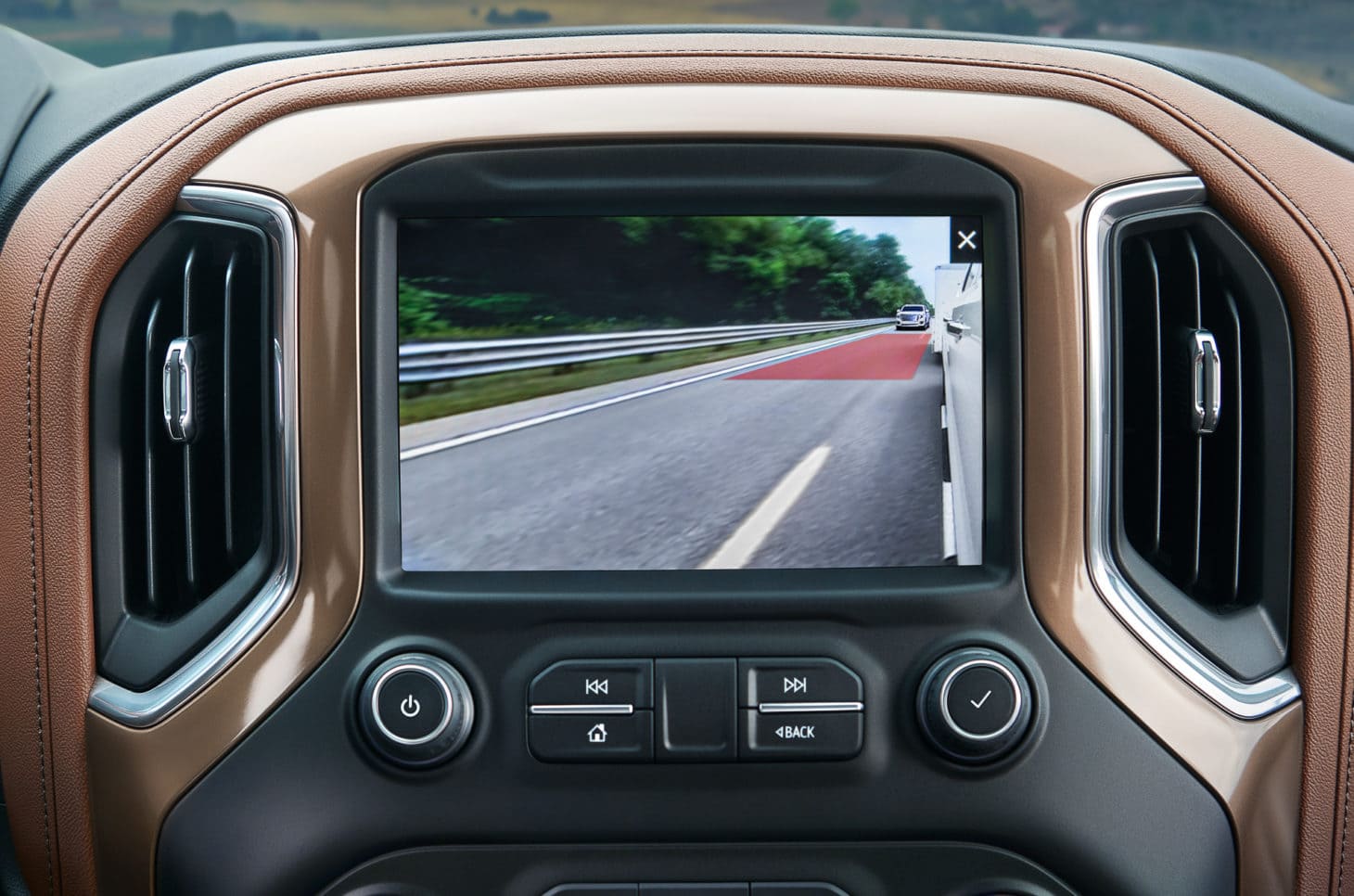
Most vehicles come with a rear backup camera and each manufacturer’s offerings vary. Most will provide an image (varying in resolution quality) from the back view of the truck, lines that guide the driver on a projected path, and zoom-in view. The best systems offer multiple angles on the truck: a front bumper view, wheels view, rear truck bed view, rear hitch view, and a bird’s eye view. The top-of-the-line systems allow for an RV’s rear camera to integrate into the truck’s infotainment system and provide that view, as well.
Be aware that in the mid-size truck category, this feature isn’t standard and may not even be available as an option in some. The aftermarket takes care of this by offering solid units that can be installed in your truck. Some trucks—like the Silverado, RAM models, or F-150—even have wiring ready for installation if they don’t already come with this feature.
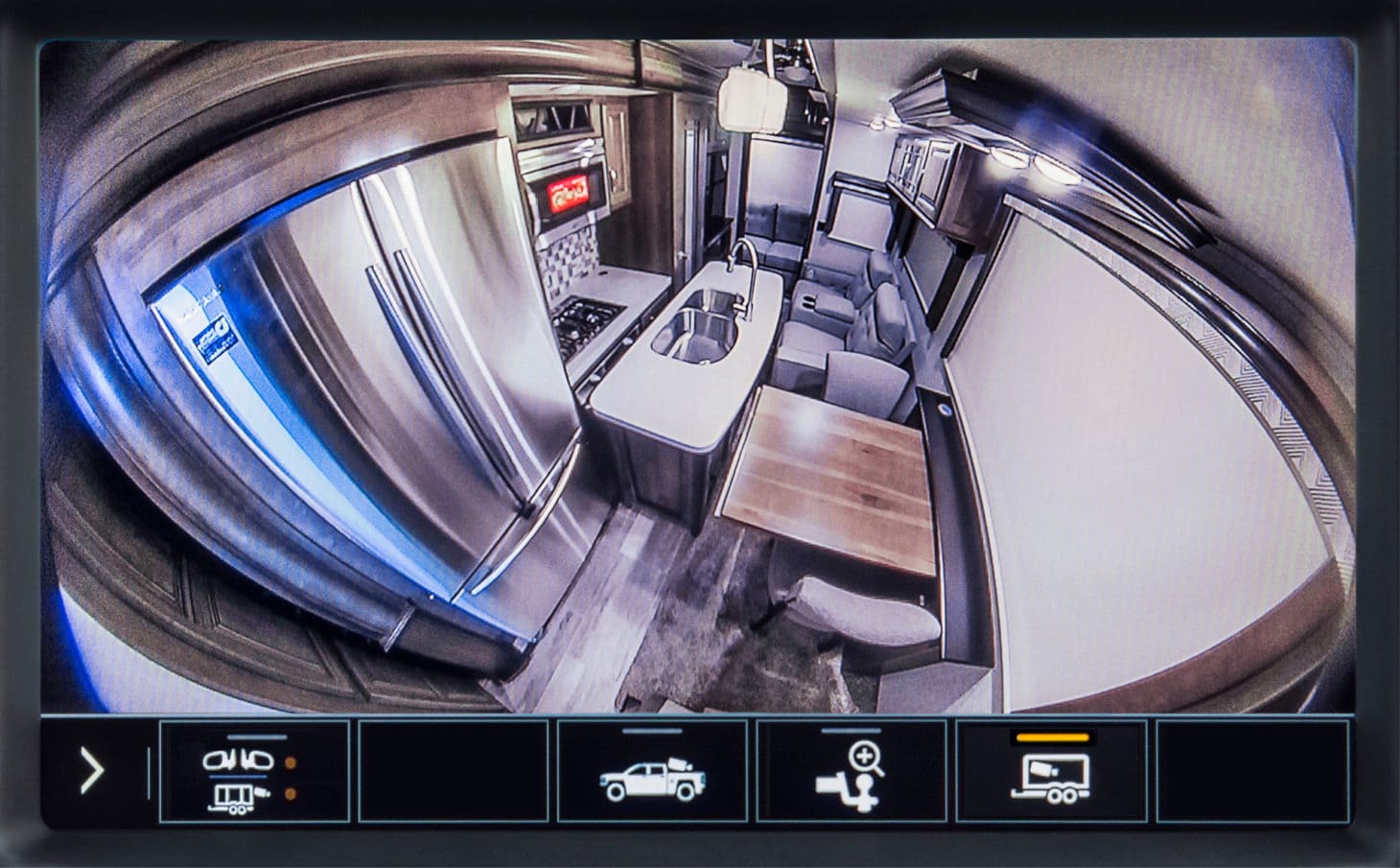
Remote Trailer Light Check
Some models allow you to check your trailer lights by cycling through the lights with a smart key fob.
Trailer Backup Assist
Backup assist technologies increase your confidence in backing up your trailer. While the feature varies slightly by automaker, the concept remains the same.
Trailer Sway Control
This feature gives you confidence that you’re in complete control of your trailer. Some trucks offer a stability system and software to automatically respond to sway.
Trailer Tire Pressure Monitoring System
This feature monitors the pressure of your trailer tires. It also allows you to monitor the temperature of the tires to help prevent blowouts caused by overheating.
Final Considerations for Purchasing a Tow Vehicle
Once you’ve narrowed down your options—from truck size to additional upgrades—look at consumer reports and Facebook groups for feedback on how the truck fares with current owners that tow. You’ll also want to take into account the time of year you’re looking to buy your truck and if you can take advantage of dealer incentives or holiday sales.
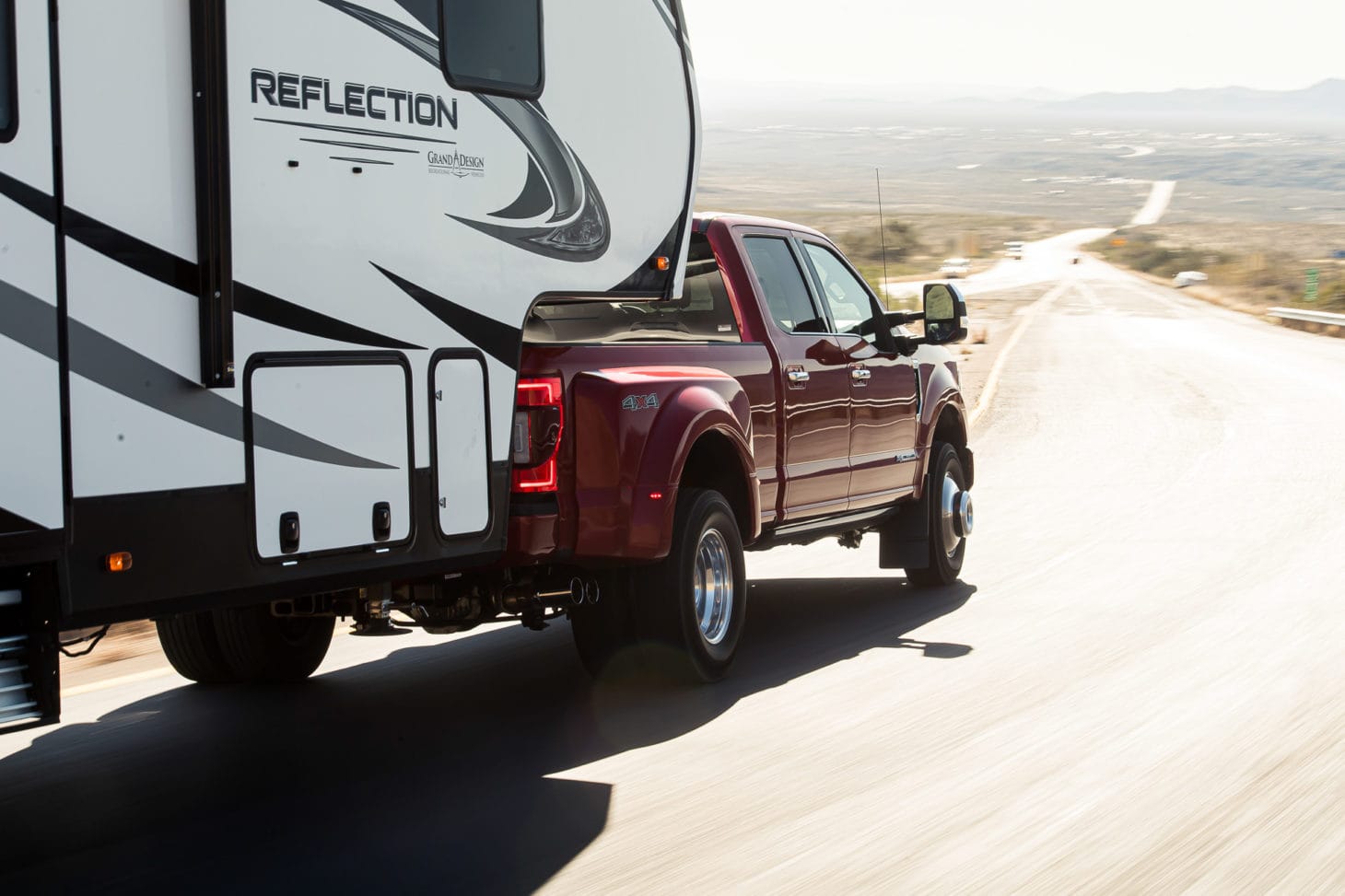
Keep in mind that salespeople at dealerships might not be the best source of information for specific towing questions as they can be focused on what’s popular rather than practical. Even within certain brand models, there will be differences that can drastically change how much the truck can tow.
Now you can go start your tow vehicle shopping journey armed with the right knowledge, questions to ask, and proper terminology to buy the right vehicle for not only your rig but also your lifestyle.
Meet the Author

Johann Schnell
South American immigrant to the U.S. Husband to my life partner in crime, dad to two adventure loving boys and fur-dad to two big dogs. When not serving small business clients for a regional bank, I enjoy taking the whole crew to the outdoors with friends.
Get the most inspiring stories from the road sent directly to your inbox.

- Trip guides
- Trip Planner
- Sign up Log in Sign out
- Log in Sign out
- ROADTRIPPERS MEMBERSHIP
- RV RESOURCES
Plan your journey, find amazing places, and take fascinating detours with our app.
We couldn't find an existing Roadtrippers account using that service. Please try signing in with another option or create a new account with Roadpass.
We need your email address to send you trip itineraries and other updates.
Lighter in weight and secured with a hitch to the frame of your tow vehicle.
Full-sized campers, requiring the “5th wheel” U-shaped hitch to tow.
Can be a travel trailer or fifth wheel. Designed with a rear garage and opening for your “toys.”
- Heartland Difference & Innovations
- Factory Tours
- RV Lifestyle
The promise of adventure drives every RV journey. Nobody knows this better than us.
- Owner's Manual
- MyHeartlandRV App
- Owners Club & Forum
- FAQ's and RV Glossary
- How to Videos
- Towing Guide
- Apparel Store
Heartland Owners Club & Forum
The Heartland Owners Club is made up of RVers from all walks of life, all on different paths on their RV journey. The club holds regular rallies and events across North America and allows you to tap into a vast amount of information curated by experienced RVers.
- FIND A DEALER
RV Towing Guide
When choosing to buy a towable RV—either a travel trailer , toy hauler , or fifth wheel —there are a few crucial things to keep in mind. At Heartland , we’ve collected a few resources here in our vehicle towing and capacity guide that will help walk you through the towing process.
TOW VEHICLE
One of the most important aspects of RV towing capacity guidelines is making sure you have the proper tow vehicle. In order to do so, you’ll need to know both your vehicle’s towing capacity and payload capacity . Both of these can usually be found in the owner’s manual or by consulting your dealer. Camping World has a helpful tool that allows you to find the exact year, make, and model of your vehicle and then calculate its tow capacity. You can also check out this video from the RV Safety & Education Foundation to better understand how to match trucks and trailers.
In choosing your tow vehicle, you’ll also need to consider what type of RV tow hitch for a car is required to actually connect your RV to your vehicle. Some of the most common hitch options include weight-carrying , weight-distributing , gooseneck , and fifth wheel . Togo RV has a great collection of articles that take you through some of these differences, and the steps for hitching and unhitching various trailers.
TOWING GUIDES
When understanding towing requirements, there are a lot of factors to consider—weight, hitch type, even the number of wheels can all play an important role. Luckily, there are resources out there to help make sense of it all. Togo RV has a printable towing guide that not only includes information on the different types of hitches and sidebars, but also includes specifics for driving, packing, and braking with a trailer. Trailer Life Magazine is a top publication in the RV industry, and it regularly releases detailed RV and trailer towing guides and advice on how to choose the right tow vehicle.
RELATED STORIES
Hauling toys: kid cargo, november 11, 2020, 5 amazing resource books for rvers, december 20, 2018, how to sell everything you own and start full-time rv living, october 21, 2020.

Best Travel Trailers – Complete Buyer’s Guide
Also referred to as towable RVs, travel trailers offer you the comfort of your home while you are on the road. However, choosing the best travel trailer for yourself from a variety of thousands can be difficult.
They're perfect for a trip to the beach, mountains, or just to get away from the city and chill in an RV park. Whatever the reason, a travel trailer will be one of the best decisions you can make for your family’s enjoyment.
Travel trailers differ from motorhomes in that they're towable. However, they're similar design to 5th wheels , and although they're not as luxurious, they can be as spacious as and much cheaper than fifth wheels .
Today, there are so many types of trailers, so you need to be careful when looking to buy one. There are a number of things to consider, and it's always a good idea to rent the model you intend to buy beforehand.
That said, to help you select the best travel trailer for your next road trip, this article will be of great help. You will also find a helpful buying guide below to further assist you in decision making.
What is a Travel Trailer?
A travel trailer acts as a towable unit that consists of solid walls, along with other features such as kitchens, living rooms, and plenty of storage and cupboards.
The purpose of a travel trailer is to offer homey comfort to you when you are on the road. Compared to other RVs such as 5th wheels , travel trailers are smaller in size but offer very similar designs and features.

- Radius entry door
- Full LED lighting interior
- Rooms have electric slide doors
- Comes with solar panel and Wi-Fi prep
- Exterior is made with high-grade aluminum
- Number of Floorplans: 17
- Length: 22 to 30 feet
If you are a little tight on the budget, but still don’t want to compromise on your comfort during the traveling experience, then the Shasta travel trailers are your best pick.
These trailers are all affordable and also more lightweight and well-built. They feature well-lit interiors and exteriors, with the exterior being built with high-grade aluminum to ensure longevity.
Also, the trailers feature back-up camera prep, along with Wi-Fi options and solar panel prep as well. The entry doors are the most distinctive feature of these trailers since the radial entrance with a protective screen makes it stand out.
Extra features that further make this the best choice include safety features, including smoke detector, LP leak detector, and fire extinguisher.
Best Bunkhouse Travel Trailer: Jayco Eagle HT

How Long Do Travel Trailers Last?
A good, reliable travel trailer will last somewhere between 10 and 12 years, but it depends on how often you use it and how well you look after it.
What Does GVWR Mean on a Travel Trailer?
GVWR stands for Gross Vehicle Weight Rating . This is the maximum weight that the trailer can take while operating. This weight will also include the trailer’s own components, such as wheels.
Should You Cover Your Travel Trailer?
If you are traveling to an area with lots of rain or unpredictable weather, it is advised to cover it with various types of covers found on the market. These will protect it from the harsh elements of nature, including rain, snow and strong sunshine.
The Best Travel Trailers - Perfect Companions for Road Trips
So, there you have it: the best travel railers. It's important to note, however, that there are many different travel trailer sizes and designs that suit different people.
Overall, if you are searching for a travel trailer, you will have to make several considerations before you can make the final choice. The best trailer is the one that meets your needs, gives you comfort on your traveling days, and does not require lots of maintenance.
All of the above are recommended, but don't let this be your final stop. it's essential that you get the right one, because you'll hopefully be spending a lot of time in yours. Whichever trailer you go for, however, we're sure you've made the right decision and will start making many amazing memories. Happy camping!
Travel Trailer Buyer Guides
If you are looking for more travel trailer-specific guides, here they are:
- Forest River Travel Trailers Reviews
- For Jeep Wranglers
- For Retired Couples
- Lightweight
- Travel Trailer Insurance
- Travel Trailers Under 3000 Lbs
- Under 4000 Lbs
- Under 5000 Lbs
- Under 8000 Lbs
- Vintage Travel Trailer Manufacturers
- Wheel-Bearing Grease
- Jayco Travel Trailers
- Best Brands
- Bunkhouse Under 30 Feet
- Travel Trailer Accessories
- Dry Camping
- For Families
- For Full-Time Living
- Four-Season
- Half-Ton Towable
- Remodels-Before and After
- Travel Trailers Under 2000 Lbs
- Travel Trailer With Bunk Bed
Share to Pinterest

Home British Columbia Idaho Montana Oregon Washington Wyoming HOME >>> Idaho >>> North Central >>> Moscow
Where to stay and what to do in Moscow
VISITOR INFORMATION
ACCOMMODATIONS
FOOD AND BEVERAGE Bakeries Coffee and Espresso Ethnic Food Fast Food Pizza Restaurants
ATTRACTIONS
Nearby Communities Coeur d'Alene, ID Lewiston, ID Pullman, WA Spokane, WA
More North Central Idaho Cottonwood Elk City Elk River Grangeville Lapwai Lewiston Moscow Orofino Peck Potlatch Riggins Spalding White Bird
Idaho Travel Regions and Maps Map Central Map Eastern Map North Idaho Map North Central Map South Central Map Southeast Map Southwest
North Central Travel Region Moscow, Idaho
Explore Moscow in more detail by clicking through the pages listed below and the links they provide to more detailed descriptions and presentations:
VISITOR INFORMATION ACCOMMODATIONS Bed and Breakfast Campgrounds and RV Parks Hotels and Motels Vacation Rentals FOOD AND BEVERAGE Bakeries Coffee and Espresso Ethnic Food Fast Food Pizza Restaurants ATTRACTIONS ACTIVITIES SHOPPING

Go Northwest! Bookstore Best selection of books on the Northwest. Click here!

Go Northwest! ® gonorthwest.com (tm)
Go Northwest! ® gonorthwest.com (tm) and GoNorthwest.com (tm) are trademarks of Go Northwest, LLC All original text, maps, photographs, and other images on this web site, as well as the compilation and design thereof, are Copyright © 1997-2019 Go Northwest, LLC. All rights reserved.
2018 Primetime Emmy & James Beard Award Winner

The R&K Guide To Moscow
The World Cup is upon us, but you could argue that it’s already a relic from another era, a time when Putin was looking for peaceable engagement with the West, before he annexed Crimea and unleashed his trolls on the world. But if ordinary Russians are supposed to play the part of pariah, they haven’t been told. It has been a long time since Moscow was this pleasant to visit. The city center is safe, sanitized, ready for your visit. Yes, the calm is a sign of an increasingly efficient autocracy. But we’ve known Moscow through many iterations, and for the casual visitor, this is one of the best yet. (Visit our St. Petersburg guide here.)
How To Do Moscow
Quick hits what to eat, quick hits what to drink, quick hits what to see, features from moscow, more city guides, r&k insider.
Join our newsletter to get exclusives on where our correspondents travel, what they eat, where they stay. Free to sign up.

IMAGES
VIDEO
COMMENTS
The manufacturer's rating of the maximum weight limit that can safely be towed by your specific vehicle. Weight is calculated by adding the RV's Gross Vehicle Weight with the weights of passengers, liquids or cargo in your vehicle. Ensure your new or used RV is capable of being safely towed. Use Camping World's vehicle tow rating calculator to ...
Hitch Up the Easy Way With Our Travel Trailer Towing Guide. Some 56 million Americans are expected to hit the highways, byways, and backroads this summer with a recreational vehicle, according to the latest RV Industry Association (RVIA) surveys. Another 10 million RVers will join them in 2022. About 1-in-5 of those hitting the road will be hitching up and towing a travel trailer—everything ...
Disclaimer: When calculating your vehicle's max towing capacity, you must account for: trailer weight, passenger weight, added accessories, liquids in tanks, and any cargo and camping gear you have loaded. For this tow guide we have allowed for 1,000 lbs for trailers over 8,000 lbs, 750 lbs for trailers under 8,000 lbs, and 500 lbs for trailers under 5,000 lbs for average Cargo Weight.
Attention: Your vehicle's max towing capacity includes passenger weight, added accessories, any current liquids in tanks, and any cargo you've added such as food, clothes, chairs, grills, games, tools, etc.. For purposes of Find an RV I can Tow, we've allowed 1000 lbs for RVs over 8000 lbs, 750 lbs for RVs under 8000 lbs, and 500 lbs for RVs ...
We recommend the tow vehicle you select have a trailer weight rating to handle at least the Gross Vehicle Weight Rating (GVWR) of the RV you plan to tow. Proper weight and load distribution are essential to safe towing. Keep the loaded tongue weight between 10% and 15% of the total weight. Read more about towing considerations and weight ...
Unlock the secrets to a safe and enjoyable towing experience with our comprehensive guide to towing a travel trailer. From weight distribution and pre-trip inspections to maneuvering tips, fuel efficiency, and campground courtesy, this guide equips you with expert advice and practical tips to navigate the roads with confidence. Discover how to optimize your towing setup, address maintenance ...
10 Common-Sense Trailer Towing Tips. Towing 101 is the ultimate trailer towing guide. It is designed to equip you with the knowledge and confidence to successfully tow a trailer with your vehicle. This tow guide is perfect for any first time trailer owner, as well as seasoned veterans looking for a refresher. It offers some of the most helpful ...
Hitch weight is actually being hauled while the remaining trailer weight is being towed. Ex: If a trailer has an overall weight of 4k lbs. with 400 lbs. of hitch weight that would mean 3600 lbs. is on the axles and being towed. (4,000 - 400 = 3,600 or D. Towed Weight) Cargo capacity must also consider hitch weight as well as axle weight rating.
Obtain the proper equipment to tow the travel trailer. This includes a receiver for your tow vehicle, most likely an equalizing hitch, brake control and possibly a sway control. You might also need tow mirrors to see around the trailer while towing. Know the cargo carrying capacity of the travel trailer (think axles and tire ratings).
Trailer Life's 27th-annual towing guide consolidates manufacturer-assigned weight limits in a single resource ... simple travel trailer, and before you knew it, you were standing before a 35-foot fi fth-wheel with three slideouts and full-body paint, ready to sign some paperwork. Hold on just a second.
For example, you can get the 2020 Chevrolet Colorado (base price $21,300) with a Duramax 2.8L turbo-diesel engine that gives you a 7,700-pound towing capacity. However, the engine upgrade will cost you nearly $4,000. In the full-size category, a small diesel engine is a premium option.
When choosing to buy a towable RV—either a travel trailer, toy hauler, or fifth wheel—there are a few crucial things to keep in mind. At Heartland, we've collected a few resources here in our vehicle towing and capacity guide that will help walk you through the towing process.. TOW VEHICLE. One of the most important aspects of RV towing capacity guidelines is making sure you have the ...
recommended for trailer towing: E-Transit, Mustang Mach-E, Shelby GT500 Mustang and Mustang Mach 1. TOWING GUIDE CONTENTS POWERFUL. CAPABLE. BUILT FORD TOUGH.® SAE TOWING STANDARD Super Duty F-350 Lariat Crew Cab 4x4 in Iconic Silver Metallic 1. Based on 1977-2020 CY total sales. F-150 Pickup 3 Super Duty® Pickup 6 Super Duty Chassis Cab 8
9,995-10,950 LBS. GVWR. Completely redesigned for 2019, the Eagle HT offers an affordable line of shorter-length and lighter-weight luxury travel trailers, made specifically for towing with today's half-ton trucks. Six new floorplans and features like a drop-frame chassis and industry-first fifth wheel auto-leveling set this luxury trailer ...
To calculate your vehicle's towing capacity, you'll need to know the full GCWR, or the gross combined weight rating, of the vehicle you plan to tow with and the trailer you plan to tow ...
impressive payload and trailer tow ratings, no matter which model you choose. Whether carrying a serious payload or towing the heaviest of trailers, F-Series trucks are designed to help conquer the toughest of jobs. F-Series - America's best-selling truck for 46 years1 running, bringing decades of RV and towing experience for every ...
Weight: 7000 to 8000 lbs. Our Review. The Jayco eagle travel trailer is best known for its competitive design that makes it one of the most long-lasting trailers in the market. The bunkhouse trailer has incredible features, which include glazed wooden interiors that ensure elegance and luxurious touch.
Shopping Guide: Sports & Recreation: Travel & Transportation: Towing in Moscow Main-> Autos & Boats-> Towing. Angel Emergency towing service. Address: Signalny proezd, 5 | Phone: +7 (495) 747-49-90. Techpomostch Transportation loading on a platform. ... Travel Services: ...
Looking to get a hitch installed on your car, truck or SUV? Find trailer hitch installation locations in Moscow, TX 75960.
Idaho Off the Beaten Path: A Guide to Unique Places, 9th Edition by Julie Fanselow. This guidebook features fun, unusual and different things travelers want to see and experience. Discover the best in local dining, quirky cultural tidbits, hidden attractions and unique finds in the Gem State. Order now...
Park Zaryadye This rolling green behemoth on the edge of the Moscow river opened for the city's 870th birthday in 2017. It has lush lawns, museums, concert halls, a food court, and a floating bridge for prime photos. The Diorama at Hotel Ukraine This 1:75 scale mini-Kremlin and Moscow was built in 1977 for a Soviet exhibition in New York, where it was an overnight sensation.